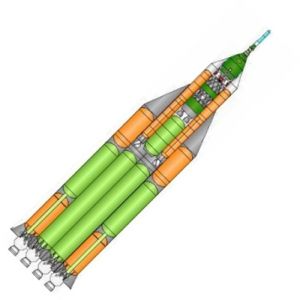
Home - Search - Browse - Alphabetic Index: 0- 1- 2- 3- 4- 5- 6- 7- 8- 9
A- B- C- D- E- F- G- H- I- J- K- L- M- N- O- P- Q- R- S- T- U- V- W- X- Y- Z
N1
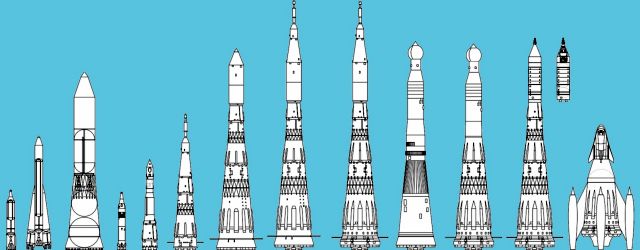
N1 Evolution 1959-74
YaRD nuclear ICBM; YaKhR nuclear LV; SuperRaket; R-9 ICBM; N-III; N-IIGR; N-I of 1962; N1-L3 of 1964;N1F; N1M; N1F+Block S, R upper stages; N1F+Block Sr upper stage; Airbreathing N1 for MKBS
AKA: G-1;N-1;SL-15. Status: Retired 1972. First Launch: 1969-02-21. Last Launch: 1972-11-23. Number: 4 . Payload: 70,000 kg (154,000 lb). Thrust: 4,400,000.00 kN (989,100,000 lbf). Gross mass: 2,735,000 kg (6,029,000 lb). Height: 105.00 m (344.00 ft). Diameter: 17.00 m (55.00 ft). Apogee: 200 km (120 mi).
Before the N1 - 1955 to 1960
Before the N1 there was an attempt to develop launchers and ICBM's to put large payloads into orbit using nuclear thermal propulsion. The first official plan for future Soviet spaceflight was contained in a decree of 30 January 1956. This set forth the following objectives:
- Orbiting of satellites of 1.8 to 2.5 metric tons mass by 1958
- One-week flight of a manned spacecraft by 1964
- Unmanned reconnaissance satellite by 1970
- Rocket capable of 12 metric ton escape velocity payload by 1970
- Rocket with 100 metric ton low earth orbit payload, capable of placing 2 to 3 men on the moon (no date set)
The first approach to the rather vague last objective was the use of nuclear power. Korolev's OKB-1 began work on nuclear launchers and missiles on 30 June 1958. Competing engine designs were in development by Glushko's OKB-456 and Bondaryuk's OKB-670. The draft project designs of both bureaus used nuclear reactors in cylindrical housings, with the reactors operating at 3000 K. The propellant was heated in the reactor and exhausted through four expansion nozzles. The Glushko engine operated with ammonia, while the Bondaryuk engine used a mixture of ammonia and alcohol. With such propellants a specific impulse of 430 seconds at launch was expected. Three rockets were designed by OKB-1 utilizing these engines:
- The first variant, YaKhR-2, followed the layout of the R-7 ICBM. With a length of 48 m, it had six strap-ons using 36 conventional LOX-Kerosene Kuznetsov engines. The core of the missile used the nuclear engine. This ignited at altitude after burnout of the strap-ons with a thrust of 140 to 170 metric tons. Lift-off mass of the booster was to be from 850 to 880 metric tons, with an orbital payload of 35 to 40 metric tons.
- The second variant was an ICBM with a range of 14,000 km. Using the Bondaryuk engine this would have had a lift-off mass of 87 metric tons and a payload of 2.6 metric tons. With the Glushko engine the figures would have been 100 metric tons and 4 metric tons. Obviously testing of such a missile with a nuclear reactor being delivered to the impact zone together with the test warhead would have grave ecological consequences (even though it was anticipated that tests would impact into an artificial reservoir). Interestingly the existence of such a project was mentioned by the American spy Oleg Penkovskiy in 1961 - but considered absurd by Western experts until revealed by RKK Energia in 1996.
- The third variant designed was a 'Super Rocket' with a lift-off mass of 2,000 metric tons and a payload of 150 metric tons. This was a true antecedent of the N1. The first and second stages were in the conical 'raketov' form later adopted for the N1. The first stage used a massive cluster of Kuznetsov NK-9 engines each with a thrust of 52 metric tons. The second stage used four nuclear engines with a total thrust of 850 metric tons. Operating at an elevated temperature of 3500 degrees K a higher specific impulse of 550 seconds in vacuum was expected. Although ideal for use in nuclear rockets, use of liquid hydrogen as a propellant was not contemplated. A mixture of liquid hydrogen and methane was considered as a better-performance propellant at a later date.
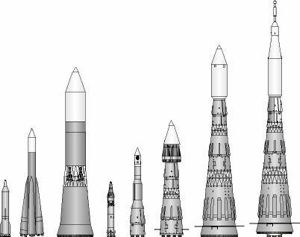 N1 Predecessors Predecessors to the N1 - From left: YaRD nuclear powered ICBM; YaKhR nuclear launch vehicle; SuperRaket; R-9 ICBM; N-III; N-IIGR; N-I of 1962; N1-L3 of 1964 |
Birth of the N-I
The space race with the Americans had heated up considerably since the casual program laid out in the plan of 1956 was issued. A decree of 10 December 1959 added a number of new programs, but for Korolev this was not enough. In a letter to the Central Committee of the Communist Part in January 1960 he proposed an aggressive program for Communist conquest of space. He declared:
- That the design bureaus of the Soviet Union must make a broad swift assault on space research
- That a new rocket of 1,000 to 2,000 metric tons gross lift-off mass with a 60 to 80 metric ton payload must be developed at the earliest possible date
- That advanced propulsion systems - nuclear, Lox-LH2, low thrust liquid, ion, and plasma engines and correction rockets - be developed as quickly as possible
- That new automatic and radio guidance systems be developed to support these objectives
The heavy rocket would be developed in two phases:
- N-I, with a 40 to 50 metric ton payload, to be developed as quickly as possible in 1960 to 1963
- N-II, with a 60 to 80 metric ton payload, using nuclear second and upper stages, to be developed in 1964 to 1965
As payloads for his rocket, to be developed in accordance of the Central Committee decree of 10 December 1959, the following would be developed for launch in the period 1963 to 1965:
- Three to six geostationary communications satellites of 2 to 3 metric tons mass for global communications
- Heavy manned space stations with a crew of 3 to 5, orbited at 350 to 400 km altitude. The station would conduct military reconnaissance, control other spacecraft in orbit, and undertake basic space research. The N-I version of the station would have a mass of 25 to 30 metric tons and the N-II version 60 to 70 metric tons
- Heliocentric satellite for solar studies of 1 to 2 metric tons mass
- Use of the N-I to launch a spacecraft with 2 to 3 men for flyby of the moon, entry into lunar orbit, and return to earth. Payload mass 10 to 12 metric tons in lunar orbit, 2 to 3 metric tons return payload.
- Use of the N-I to launch the MK interplanetary spacecraft with 2 to 3 crew on 2 to 3 year flyby missions to Mars and Venus. Automatic probes would be landed on the planets during the flyby maneuvers.
- Use of the N-II for group flight of 3 to 4 spacecraft on expeditions to land on Mars and Venus. Crew per spacecraft would be 2 to 3. One spacecraft would be a reserve to ensure the safe return of the crews to earth. These spacecraft would be placed by the N-II on their interplanetary trajectories at a velocity of 11.2 km-s, have a mass of 10 to 30 metric tons, with a return capsule mass of 3 to 8 metric tons.
- Global rockets that could bombard any point on earth with showers of nuclear warheads totaling 40 to 100 metric tons mass at ranges of 3,000 to 12,000 km
- Potential to establish a defensive space infrastructure that would annihilate any enemy satellites or rockets that flew over the territory of the USSR
- Photographic and electronic reconnaissance of every part of the earth
- Precision military navigation
For his part, Korolev and the other chief designers would pledge to support this overall effort by the development of draft projects and fundamental research work to validate and mature the necessary technologies. They would place before the Central Committee in the third quarter of 1960 comprehensive plans for development of the new projects. It was requested that that the Central Committee authorize the design bureaus to undertake these draft projects, and that the Ministry of Finance be directed to allow the bureaus to use reserve funds to finance the work.
Korolev also requested that a decree be issued to establish a USSR Institute of Interplanetary Studies. This would be a public body like the nuclear institute in Dubna, and would co-ordinate world-wide work on space research and technology. The decree was also to authorize publication in the USSR of an open scientific technical journal covering international exploitation of space and interplanetary research.
This letter was followed by a meeting with Khrushchev on the subject on 3 March 1960. Korolev believed it would be truly possible with backing from the very top to have a large rocket in the USSR in a very short span of time. Unfortunately at the meeting Korolev made a slip of the tongue he would always regret, admitting that his plan had not been agreed among all of the Chief Designers. This resulted in Khrushchev throwing the matter back for a consensus plan.
By 30 May 1960 Korolev was back with a plan that now included participation of his rivals, Chelomei and Yangel. Project codes were applied and some of the work Korolev had planned was now Chelomei's. The consolidated plan was as follows:
- N-I - (Korolev) - to be developed in 1960 - 1962. 40 to 50 metric tons payload to low earth orbit and 10 to 20 metric tons to Mars. Draft project to be completed by second quarter 1961.
- N-II - (Korolev) - to be completed in 1963 - 1967. 60 to 80 metric ton payload to low earth orbit and 20 to 40 metric tons to Mars. Draft project to be completed in 1962.
- KS - (Korolev) - Heavy manned spacecraft, 2-3 crew, to demonstrate rendezvous, docking, and controlled flight. To be developed in 1961 to 1963 (this would become Soyuz).
- KL - (Korolev) - Manned spacecraft for lunar flyby. To be developed in 1961 to 1964 (this would become the L1).
- KMV - (Korolev) - Interplanetary manned spacecraft for 2-3 crew, flyby of Mars and Venus. To be developed in 1962 to 1965 (this was the TMK-1).
- R-7 - Four-stage version of R-7- (Korolev) - 300 metric ton gross lift-off mass, available from 1960 for robotic lunar and interplanetary flights (this would be the Molniya booster)
- M - (Korolev) - Launch to Mars of 1M robot probes in September - October 1960 and 2M probes in 1962 (these Mars flights were attempted on this schedule)
- V - (Korolev) - Launch to Venus of 1V probes in January 1961 and 2V probes in 1962 (these Venus flights were attempted on this schedule)
E - (Korolev) - Launch to the moon (as per decree of 10 December 1959) E-1 lander probes in 1960 to 1961 and E-7 orbiters in 1961 (these lunar probes would eventually succeed many years behind schedule)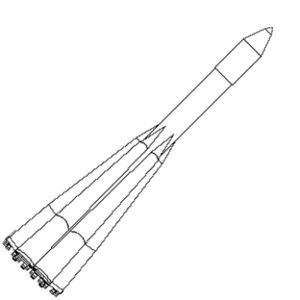
YaKhR-2 exterior
YaKhR-2 Nuclear-powered Launch Vehicle
Credit: © Mark Wade- K - (Chelomei) - Development of unpiloted Kosmoplans for flight to Mars and Venus with return to earth and landing at conventional airfields. These would use new exotic chemical systems, low thrust nuclear engines (nuclear-plasma, ion, atomic hydrogen). Sub-variants with a total mass of 10 to 12 metric tons and 25 metric tons would be developed in 1965-1966. Draft project to be completed in 1962.
- UR-500 - (Chelomei) - Develop a 600 metric ton gross lift-off mass rocket using new chemical propellants for sending these spacecraft to nearby planets. Draft project to be completed in 1962. (This would become the UR-500 Proton booster)
- R-7L - (Korolev) - Develop in 1960 to 1962 a 4 stage version of the R-7, utilizing R-9 technology, with a 300 metric ton gross lift-off mass and high specific impulse engines in the last stage. Payload 10 metric tons to low earth orbit and 3 metric tons to escape. Draft project to be completed in 1961 (this booster, later called the Molniya-L, was never developed).
- Vostok recoverable spacecraft (Korolev) :
- Photo and electronic reconnaissance versions to be developed in 1960 to 1962 (these would be the Zenit-2 reconnaissance satellites. They would end up flying after, not before the Vostok manned flights)
- Manned version to be developed in 1961 to 1963 (these flew on schedule)
- Scientific research version to be developed in 1960 to 1962 (these were designed but never flown)
- Maneuverable rendezvous and docking version to be developed in 1961 to 1963 (this was the Vostok-Zh - never flown, replaced by Soyuz)
- Elektron - (Korolev) - high apogee radiation belt research satellites, developed according to decree of 10 December 1959, to be launched in 1960 to 1961 (these flew late to schedule)
- US - (Chelomei) - Naval reconnaissance satellite using P6 nuclear reactor. To be developed in 1962 to 1964 (these flew late to schedule)
- R - (Chelomei) - Manned Raketoplan spacecraft for orbital maneuvering flight and recovery at conventional airfields. Total mass to be 10 to 12 metric tons, total gliding range during re-entry 2,500 to 3,000 km. Unpiloted version to be developed in 1960 to 1961, followed by piloted version in 1963 to 1965. Satellite interceptor operational version to be tested in 1962 to 1964 (only suborbital subscale tests were conducted on this program before it would be cancelled)
- Meteorological satellites - (Korolev) - Meteor R-7 launched satellites to be developed in 1961 to 1963 (these would fly, but behind schedule), to be followed by heavy-rocket satellites in 1963 to 1964 (designer not decided).
- Communications satellites - (Korolev) - R-7 launched satellites to be developed in 1961 to 1963 (these would fly, behind schedule, as the Molniya series), to be followed by heavy rocket satellites in 1962 to 1964 (designer not decided).
- DS - Small satellites - launchers - (Yangel) to be developed in 1961 to 1965, together with launch vehicles derived from the R-12 and R-14 ballistic missiles (this program flew on schedule)
- OS - (Korolev) - Space stations - the Ministry of Defense was to decide by the fourth quarter of 1960 whether it can utilize military stations with multiple independent rocket-warheads
- IS - Antisatellites - the Ministry of Defense was to decide by July 1960 whether to develop an R-7 launched system for annihilation of enemy reconnaissance satellites (this project was conducted, but given to Chelomei for launch on the UR-200. Eventually flew in the late 1960's, launched by Yangel Tsiklon rockets)
Military Communications Satellites - the Ministry of Defense was to decide by the fourth quarter of 1960 whether to proceed with development of military communications satellites (this was done - the Strela series)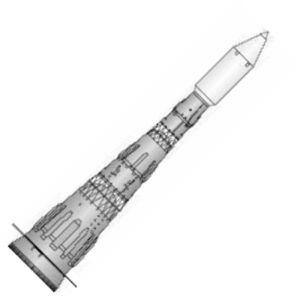
N1 - 1962
N-I as per draft project, 1962- GOSPLAN was to allocate budget beginning in 1961 for development of the systems set forth in the plan
However the May plan was approved as outlined. Therefore N-I design officially began as a result of the final government decree 715-296 of 23 June 1960 'On the Production of Various Launch Vehicles, Satellites, Spacecraft for the Military Space Forces in 1960-1967'
Design of the N-I
The same day that the decree was issued Korolev wrote to the Ministry of Defense, again trying to obtain support for a military orbital station (OS), on which a decision had been deferred to the end of the year. He pointed out that his design bureau had already completed a draft project, in which 14 work brigades had participated. Missions the station could accomplish included:
- Reconnaissance
- Combat operations against enemy spacecraft
- Strike against any point on earth
- Communications and relay functions
- Military applications studies
- Defense against enemy ballistic missiles
- Study of the space environment
- Study of the earth and planets
- Astronomical observations
- Weather observation
- Interorbital communications
- Study of the sun
- Biological research
- Radiation control studies
By this time Glushko had new data from the US on the use of N2O4 (nitrogen tetroxide) as an oxidizer. He told Korolev that he advised replacing both Lox-UDMH and Nitric Acid-UDMH with N2O4-UDMH in the three stages of the N1. N2O4 would improve the specific impulse by 13 seconds at sea level and 14-15 seconds at altitude in comparison with the previously considered propellant combinations. To utilize it an existing turbine design would have to be increased from 25,000 to 30,000 HP, powered by a closed cycle gas generator cycle, and an increase in chamber pressure from 260 atmospheres to 300. N2O4 was more stable than nitric acid, and cost 50 to 55 rubles per metric ton. For fourth stage applications, Glushko recommended use of a 10 metric ton engine burning hydrogen peroxide and pentaborane. Although extremely difficult to handle and toxic, the propellants would increase the specific impulse by 54 seconds compared to nitric acid-UDMH, 40 seconds compared toN2O4-UDMH, and 25 seconds compared to Lox-Kerosene. Korolev was not at all receptive to use of any of these propellants, still preferring Lox-Kerosene.
 N-IIGR - 1962 N-IIGR Multi-Warhead FOBS, 1962 |
Glushko really saw the adoption of the N2O4-UDMH propellant combination as the answer to problems he had experienced with combustion instability and chamber cooling in the four-chamber RD-111 engine developed for Korolev's GR-1 ICBM. As was the case with the R-7, Glushko was unable to solve the problems and finally resorted to four smaller chambers operating from a single turbopump. This scheme provided problems of its own, however - difficulties in synchronizing the thrust of the four chambers. By using N2O4-UDMH, a combustion chamber 280 to 580 degrees less than that of Lox-Kerosene would be obtained, greatly lessening these problems and allowing faster development.
Korolev had nothing but contempt for Glushko by this point, going back to his belief that it was Glushko's denunciation of him in 1937 that landed him in the Gulag, in the death-mines of Kolyma. Glushko had failed to solve combustion problems with the RD-105 engine, forcing the use of a four-chamber design in the RD-107 and RD-108 - chambers little larger than those on the V-2. Glushko had refused to solve the vernier rocket design for the R-7, forcing Korolev to do it. Glushko had been unable to expediently provide an upper stage engine for the R-7, forcing Korolev's own bureau to develop the S1.5400. Again with the R-9 engines, Glushko could not solve the problem of producing stable combustion in a large chamber.
In developing the S1.5400 Korolev's team demonstrated the higher performance that could be achieved with a closed-cycle engine. Glushko refused to consider this for a Lox-Kerosene RD-250 - it would only increase the already unmanageable chamber pressures and temperatures. Therefore Korolev turned to Kuznetsov's design bureau. Kuznetsov's OKB had originally been founded to exploit German engineers and develop the gigantic turboprop engines of the Tu-95 Bear bomber. But with assistance from Korolev's team he promised he could learn the technology. Kuznetsov had good relations with Korolev and was conveniently located in Samara, the same town where R-7 production was underway and N-I production was planned. Kuznetsov was willing to attempt to produce the higher-efficiency closed cycle engine that Glushko believed was impossible with the Lox-Kerosene propellants.
By March 1962, faced with Chelomei's favor with the military, Korolev made a detailed pitch for development of the N-I in the military context. This evolutionary program had a real chance of producing a mature launch vehicle for heavy applications.
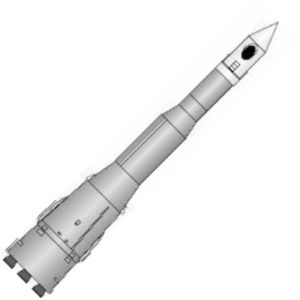 N-III 1962 |
Step 1 would be the N-II, which would fulfil the GR-2 global rocket requirement in place of Chelomei's UR-500. It would have a gross lift-off mass of 750 metric tons, and deliver a 25 metric ton payload to low earth orbit. It could also deliver a 25 megaton bomb from an under-the-radar orbital trajectory with an accuracy of 2 km. The N-11GR variant was an adaptation of the basic N-11, derived from the second and third stages of the N1 heavy booster. The GR-2 was to be a kind of enormous multiple-warhead FOBS (fractional orbit bombing system). Surrounding the top of the second stage of the rocket, like bullets in an enormous revolver, were six final stages derived from the 8K713 GR-1 last stage. Each stage had a 1,500 kg 2.2 MT nuclear warhead. The stages would separate from the main vehicle, and make violent maneuvers using independent guidance systems to put each warhead in a different low 160 km altitude orbit. At the end of a 10,000 to 12,000 km journey along their separate orbital paths, the warheads would appear on US radar screens at the last moment with minimal warning. The total spread of the warheads would be 1800 km from left to right; two such global rockets could devastate America's major cities from coast to coast in an unstoppable first strike.
Step 2 Would be to develop the first stage of the N-I, which coupled with the already-tested N-II would provide a total lift-off mass of 2,100 metric tons and put 80 metric tons into low earth orbit. Missions for the N-I would include global reconnaissance, anti-satellite, antiballistic missile, interceptor spacecraft to rendezvous with, examine, and neutralize enemy satellites; and nuclear anti-satellites.
This program could be conducted at minimum cost and risk. The NK-9 would be flight-tested by the end of 1963 in the improved R-9M ICBM. If the military could not afford construction of a new launch site, Korolev proposed that the N-II could be assembled in the existing R-7 MIK assembly hall and launched from the two R-7 launch pads at Baikonur, LC-1 and LC-31. Using this cut-rate approach the N-II could be developed for 2 million rubles and provide real confidence that the N-I would be successful. Korolev promised that if a prompt go-ahead was received the N-I would make a first flight by the end of 1964 or the beginning of 1965.
Despite this appeal, which set forth a program which could have discovered and eliminated the problems the N-I encountered later, the military did not support it. Chelomei was given go-ahead on 24 April 1962 to develop the UR-500 rocket for the GR-2 requirement.
Korolev's next attempt to win military support for development of the N-I was his fantastic 'Orbitalniy Poyas' (OP -Orbital Belt) scheme of 20 April 1962. Anticipating Ronald Reagan's Strategic Defense Initiative by 25 years, he painted a picture of an invincible Soviet space force patrolling the heavens. Two to three large N-I launched military manned stations would control a constellation of strategic assets. Geosynchronous nuclear-powered satellites would provide secure communications. Piloted reconnaissance spacecraft would surprise the enemy, observing military preparations without warning. The orbital stations would provide continuous observations of the territory of the imperialist block. They would control combat sputniks, maneuverable anti-satellites that would control the heavens from altitudes of 300 to 2,000 km. Using docking methods, the stations would be remanned, providing fresh crews to control anti-ballistic missile interceptors in 150 to 100 km orbits and to deploy separately targetable warheads at a variety of altitudes.
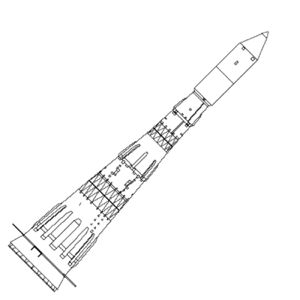 N1 early concept Credit: © Mark Wade |
In parallel with the formal N1 draft project, since 1961, the Yangel and Chelomei bureaus had been developing alternate designs (Yangel's was designated R-56 and Chelomei's was the UR-700). Both used clustered 4 m diameter rocket stages. Both advocated each stage be equipped with a single large Glushko engine using toxic storable propellants and with a thrust of 450 to 550 metric tons. Such stages could be built in factories in Moscow or Dnepropetrovsk and shipped on the existing Soviet rail system to Baikonur. There they would be joined together but no actual metal fabrication work would have to be carried out. This approach was used with success for the smaller R-7 and Proton launch vehicles. Dynamic testing of scale models by TsNIIMASH indicated the clustering of large numbers of stages was feasible.
 R-56 test model R-56 dynamic test model Credit: © Mark Wade |
The N-I draft project was completed on 16 May 1962. The design was defended before the other Chief Designers on 2 to 16 July 1962. And this is what the draft project said:
The three stage N-I was designed to support the following objectives:
- Placement of heavy spacecraft in low earth orbit for the purposes of research into the space environment; the origin and evolution of the planet Earth; solar radiation; the nature of gravity; physical observations of nearby planets; understanding the origin of organic life and the evolution of life on earth; etc.
- Circumnavigation of the moon with a crew of two to three men; entry into lunar orbit of robotic and crewed modules for study of the lunar surface
- Expeditions to the surface of the moon for the study of its soil, relief, inner structure, physical properties, and selection of a suitable site for a research base on the moon
- Establishment of a lunar base and regular traffic between the earth and the moon;
- Flyby of Mars and Venus and return to earth by a crew of two to three men
- Entry into orbit around Mars and Venus and return to earth of spacecraft with two to three men
- Delivery of expeditions to the surfaces of Mars and Venus and identification of sites for research bases
- Launch of automatic probes to the outer planets (Jupiter, Saturn, etc.)
- Establishment of manned and unmanned spacecraft in high and geosynchronous earth orbits, not obtainable by launch vehicles derived by ICBM's, for radio and television communications, earth resources, early warning, and meteorological purposes
- Deployment of heavy automatic and piloted military stations for high priority operations in earth orbit, including the capability of making evasive maneuvers and deployment of large numbers of nuclear warheads or other military apparatus in low earth orbit
- Simultaneous launch from a single base of a large number of nuclear warheads on intercontinental ballistic and global orbital trajectories, with the assistance of multiple independently-guided final rocket stages atop the last stage of the N-I
- Construction of a launch vehicle of the highest possible payload
- Development of the national technical base to the highest possible degree
- Development of a family of smaller rockets using the same technology
After extensive study it was determined that the design objective of a single launch payload of 75 metric tons into a 300 km orbit best met the required payload masses for a variety of missions:
- Manned lunar orbiter
- Manned lunar landing, if used with Lox-LH2 upper stages
- Manned flyby of Mars and Venus
- Manned expeditions to orbits around Mars and Venus, utilizing two N-I launches, docking in earth orbit, and nuclear electric propulsion for the spacecraft
Many trade studies were conducted comparing differing propellants and design layouts before settling on the configuration set forth in the draft project as the optimum design. These trade studies would be vital in defending the design before the expert commission against the attacks of Glushko. Propellant variants studied were:
- N1-K, the baseline, using Lox-Kerosene (TG-1) in all three stages
- N1-V1,V2,V3: Variants with Lox-LH2 stages. These later developments could reach 120 metric tons to 165 metric tons low earth orbit payloads needed for manned Mars expeditions.
- N1-D-A: Variant with storable N2O4-UDMH propellants. Other less energetic propellant combinations considered were OKA-50-UDMH, Nitric Acid (AK-27)-UDMH.
Conclusions were that the highest specific impulse was obtained from the Lox-Kerosene combination; and that highest tank mass was required for the N2O4, OKA-50, or AK-27 oxidizers. Use of N2O4-UDMH would result in a reduction in specific impulse of 17 to 21 seconds compared to Lox-Kerosene and a reduction in payload of 20 to 25%. Use of AK-27-UDMH would result in a 33 to 38% second reduction in specific impulse and a reduction in payload of 43 to 47%. Moreover the storable propellants would cost almost ten times more than lox-kerosene (2 million rubles per N1 launch versus 250,000 rubles). These considerations, plus the easier handling of Lox-Kerosene, confirmed the propellant selection. Lox-LH2 engines would not be available during the time scale of the initial project, but would be considered later for uprated versions of the launch vehicle.
Configuration variations considered were:
- N1-I - Packet rocket, as used for the R-7. Six strap-ons around an identical core with an upper stage. Two sub-types were considered: In the first, as in the R-7, the rocket would hang from the 'shoulder' of the strap-ons above the flame pit to minimize lower stage mass. The second, which was selected for further study, had the same layout, but the base of the rocket was mounted conventionally, free-standing on its base on the launch pad. This was the baseline design for comparison with the others.
- N1- II - Polyblock - a cluster of autonomous rocket stages, each consisting of two propellant tanks feeding individual engine sections. Loads would be carried through the individual stage structure, although the Blocks would be tied together to form a single unit. This was basically the same as the competing Chelomei UR-700 and Yangel R-56 layouts.
- N1-III - Polyblock - a cluster rocket, but with the loads transmitted through an external skin. The tanks would be unsupported and a common fuel system would feed the engines. This scheme was analogous to the American Saturn I first stage and Nova designs.
- N1-IV - Monoblock - large single stages, each with one oxidizer and one fuel tanks, using a common fuel system to feed the engines. This was analogous to the American Saturn V and the selected N-I configuration
All of the designs used 'hot start' stage ignition, requiring use of the familiar Warren truss open strut interstages.
Following analysis of the designs, the following were the results of the detailed design analysis:
| Parameter | N1-I | N1-II | N1-III | N1-IV |
|---|---|---|---|---|
| Payload - kg | 70,000 | 65,000 | 72,000 | 75,000 |
| Complexity | 16 tanks 8 engine systems 78 armatures | 30 tanks 15 engine systems 621 armatures | 30 tanks 3 engine systems 331 armatures | 6 tanks 3 engine systems 305 armatures |
| Train Cars Required | 26 | 21 | 33 | 43 |
The disadvantages of Variants I, II, and III were the large number of servicing ports, fueling ports, and check inspection points. It was felt that the lower complexity and higher performance of the monoblock Variant IV outweighed the much greater number of train-car loads of parts necessary. The gores of the spherical propellant tanks and panels of the side walls would be built in the factory in Samara and only final assembly of the launch vehicle would be undertaken at the cosmodrome.
In the United States launch from coastal Cape Canaveral permitted the 10 m diameter Saturn IC and Saturn II stages to be shipped by barge from the factories to the launch site. No such possibility existed for Baikonur, in the arid steppes of Kazakhstan. Alternate launch sites were considered (and some space engineers wistfully hoped for a launch site on the balmy Black Sea) but Baikonur remained the only possibility. Due to the geography of the Soviet Union there was no other launch location with relatively uninhabited downrange areas for impact of spent rocket stages.
By this analysis the selection of lox-kerosene propellants and the monoblock configuration were justified in the draft project. Indirectly the problems of polyblock designs like those of Yangel and Chelomei were considered and attacked.
For the 75 metric ton payload a gross lift-off mass of 2,000 to 2,300 metric tons would be required using only Lox-Kerosene propellants in all stages. It would be necessary to build a 150 metric ton thrust closed-cycle rocket engine for use in the launch vehicle (at that time the largest rocket engine chamber built in Russia was 40 metric tons, open cycle). 24 NK-15-11D51 engines would be used in the first stage, 8 NK-15V-11D52 engines in the second stage, and 4 smaller NK-19-11D53 engines in the third stage. Development of engines in the 600 to 900 metric ton thrust were studied but would have required development of new technologies and not been available during the project's time scale. A 150 metric ton engine was well sized for use in the second stage and the clustering of large numbers of them in the first stage could be managed through use of the KORD control system (an elaborate automatic system that would monitor engine health, shut down any failing engine and its opposite number, allowing continued operation of the cluster until the required stage performance was reached).
From the N1 stages two smaller launch vehicles would be derived. The N11 would use versions of the second and third stages of the N1, together with the third stage of the GR-1. This would have a lift-off mass of 700 metric tons and a 20 metric ton payload into low earth orbit. It was designed for the same missions as the Chelomei UR-500 Proton booster. The N111 would use derivatives of the third stages of the N1 and the second stage of Korolev's R-9 ICBM. This would result in a lift-off mass of 200 metric tons and a five metric ton payload, allowing it to replace the R-7 derived Vostok and Soyuz boosters.
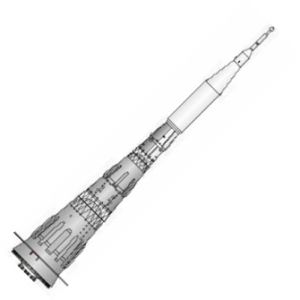 N1-L3 - 1964 N1-L3 as per advanced project, 1964 |
Despite intense criticism by Glushko, Keldysh and the rest of the expert commission supported the draft project. But the program was still without an authorized mission. Following the approval of the draft project there was a more informal discussion between Khrushchev and the Chief Designers at the Soviet leader's estate at Pitsunda, on the Black Sea, in August. Korolev went over the heads of the military once again and pitched his giant military space station as a rationale for the project. At the conclusion of the meeting, Khrushchev ordered start of the project to put a 75 metric ton manned platform with nuclear weapons into low earth orbit. The official decree authorizing N-I production was issued on 24 September 1962 with first flight to occur in 1965. This set forth the first of a series of optimistic schedules for development of the launch vehicle. Completion of third stage tests was expected by the end of 1964, first and second stages by mid-1965, completion of all engine test stand runs by the first quarter of 1965, completion of the launch complex by the end of 1964, and first launch in 1965.
So after two years of struggle, Korolev finally had his authorization in hand. But it turned out not to be enough. He had authorization for the rocket, but no support from the military ranks for a payload for it to launch.
Barmin's GSKB SpetsMash was given responsibility for design and construction of the launch facilities. In March 1963 design work started on the N1 launch complex. The ground-breaking ceremony was held a year later and construction began of the N1 launch complex and assembly buildings
Nuclear N-I's - 1961 to 1963
Following abandonment of the nuclear-ammonia ICBM projects, the engine bureaus of Bondaryuk (OKB-670) and Glushko (OKB-456) continued study of nuclear propulsion, but using liquid hydrogen for upper stage applications. Engines of 200 metric tons and 40 metric tons thrust with a specific impulse of 900 to 950 seconds were being considered. At the end of 1961 both bureaus completed their draft projects and it was decided to continue work on development of an engine in the 30 to 40 metric ton thrust range. In the following year Korolev was asked to study application of such engines, followed by a demand in May 1963 from the Scientific-Technical Soviet for specific recommendations.
Korolev considered three variants based on the N1:
- A three stage vehicle using the N1 first and second stages and a nuclear third stage
- A three stage vehicle using the N1 first stage and nuclear second and third stages
- A two stage vehicle using the N1 first stage and a nuclear second stage
The study concluded that the two stage vehicle was the most promising. Compared to an equivalent vehicle using liquid oxygen/liquid hydrogen, mass in low earth orbit would be more than doubled. Optimal stage size was 700 to 800 metric tons for the Type A engines and 1,500 to 2,000 metric tons for the type V engines (this resulted in a halaciously large number of nuclear engines by Western standards). Use of the nuclear stage would result in a single N1 launch being able to launch a round-trip lunar landing (mass landed on lunar surface over 24 metric tons with return of a 5 metric ton capsule to earth).
 N1 Late Versions Late versions of N1: from left: N1F; N1M; N1F with Block S, R upper stages; N1F with Block Sr upper stage; Airbreathing N1 for MOK support; Kistler |
Further investigation of nuclear thermal stages for the N1 does not seem to have been pursued. Bondaryuk and Glushko turned to Chelomei and his competing UR-700 rocket for future application of such stages.
N1 Payloads - the Moon Calls - 1963
On 23 September 1963 Korolev submitted his plans for space projects in the period 1965 to 1975. He now saw a clear chance to again appeal to the leadership for a manned lunar landing program. He dusted off his rejected L-1 circumlunar project, but added four new spacecraft that would allow reconnaissance, followed by landing on the moon and extended exploration of its surface.
The first two projects, as before, would use R-7 based launch vehicles and extensive docking and refueling operations in low earth orbit. But elements of these would be used in the last three, which would map the moon from lunar orbit, land men on its surface, and explore it with a manned crawler.
L-1
This revision to the original L1 project of 1962 had the same objective of sending two men on a circumlunar flyby trajectory. But now the Soyuz had a reverse configuration of that used earlier. From fore to aft, the modules were: the Descent Capsule (SA), Living Module (BO); Equipment Module (AO); Propulsion Module (AO); Rendezvous electronics module (NO) and Docking Unit (SU). This configuration would be important in the later N1-based projects. As before, the system consisted of the 7K manned spacecraft, the 9K rocket spacecraft, and the 11K tanker. A total of six launches of the 11A511 Soyuz booster would be required. The 9K rocket stage would be put in orbit first. It would be followed by four 11K tankers which would top off the tanks of the rocket block. Then, when all was ready, the 7K manned craft would be put into orbit and dock with the 9K stage. The stage would fire and put the manned spacecraft on a translunar trajectory.
The 7K would be equipped with cinema cameras and scientific sensors to record the lunar surface during the flyby, which would be at from 1,000 to 20,000 km from the lunar surface. Total flight time was 7 to 8 days. The SA would separate from the 7K at 120 to 150 km altitude and re-enter the earth's atmosphere at 11 km/sec. After decelerating to subsonic speed, the SA's parachute would open at 10-18 km altitude. Total mass of the L1 in low earth orbit was 23,000 kg and the flyby mass of the Soyuz alone was 5,100 kg.
L-2
The L2 was a project to land a remote-controlled self-propelled rover on the surface of the moon. It would use the same rocket stage and tanker elements developed for the L1 manned circumlunar project. It can be seen to be the direct ancestor of the Ye-8 Lunokhod lunar rovers of the 1970's.
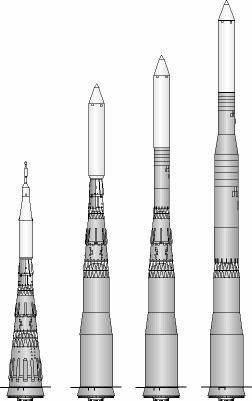 N-IM 1965 N-IM version of 1965 |
The L-2 system consisted of:
- The L-2 crawler. This had a maximum speed of 4 km/hour and a range of 2,500 km. The L-2 consisted of:
- Motor compartment with equipment permitting speeds of up to 4 km/hour
- Equipment compartment, with on-board radio, navigation, and control systems
- Power generating system (evidently solar and/or radioisotope generators)
- The 13K rocket system for midcourse corrections and lunar braking. This would brake the L-2 to a direct landing on the surface of the moon with no intermediate lunar orbit. It consisted:
- Braking stage, for midcourse corrections and the main braking impulse for the landing on the surface. This would ignite at an altitude of 200-300 km above the surface.
- The landing vehicle, with throttled engines, for the soft landing on the surface at a speed of only 2 to 4 m/s.
- The guidance system
- The maneuvering and guidance system for docking with the 9K in earth orbit, which was cast off before the translunar injection.
- The 9K translunar injection stage for sending the L-2 towards the moon from the low earth assembly orbit. This was the Soyuz B rocket stage used on the L-1 project
Total mass of the L-2 + 13K + 9K complex at ignition of the 9K for translunar injection was 23,000 kg. Total mass of the L-2 and 13K in their translunar cruise configuration was 5,000 kg. As was the case for the L-1, six launches of the Soyuz 11A511 booster would be required to assemble the L-2 in a 225 km low earth assembly orbit.
L-3
Korolev's first version of the L-3 manned spacecraft was designed to make a direct lunar landing using the earth orbit rendezvous method. It was a 200 metric ton spacecraft requiring three N1 launches and a single Soyuz 11A5ll launch to assemble in low earth orbit. The first N1 launch would place the 75 metric ton partially-fueled TLI stage and L3 spacecraft (except the L1 manned return craft) into low earth orbit. Two further N1 launches would orbit 75 metric ton tankers which would rendezvous and dock with the first payload and top off its propellant tanks. Then the Soyuz would be launched for an automated rear-end docking with the entire L3 stack. The L3 spacecraft thereby assembled consisted of:
- Translunar injection stage, with a total mass of 138 metric tons
- The lunar braking stage, which included a separate midcourse correction section cast off before the braking burn. Midcourse maneuvers would be made at 100,000 and 150,000 km from the earth to ensure a landing near the site pre-surveyed by the L-2 robotic lunar rover, which would be providing a homing signal for the L-3. The lunar braking stage had a total mass of just under 40 metric tons. The main braking burn would start 200 to 300 km above the surface.
- The lunar soft landing/ascent stage, which had a total mass of 21 metric tons landed on the moon. The stage would use variable-thrust engines to make a soft landing at 2-4 m/s on the surface. The landing leg structure and soft landing engines would be left behind on the moon.
- The ascent stage, which would separate from the landing legs and propel the manned capsule back toward the earth. This included the guidance system for the entire L-3 complex.
- The Soyuz L1 manned spacecraft, which consisted of a 2.5 metric ton equipment module and 2.5 metric ton re-entry module. It could accommodate a crew of two to three.
 N-IF Variants N-IF Versions, from left: N1-L3; N-IF; N-IUV-III; N-IFV-III; N-IFV-III,II |
L-4
The L-4 Manned Lunar Orbiter Research Spacecraft would have taken two to three cosmonauts into lunar orbit for an extended survey and mapping mission. The L-4 complex, with a total mass of 75 metric tons, would be placed into orbit in a single N1 launch, and would consist of:
- The trans-lunar injection stage, total mass 58 metric tons. If development of a fourth stage for the N1 was not authorized, this could be replaced by three sequentially-fired Soyuz B 9KM rocket blocks developed for the L-1 and L-2 projects.
- The lunar orbit maneuvering stage, which would have a total mass of 11.5 metric tons. This would break the Soyuz manned spacecraft into lunar orbit and returned it on its transearth trajectory. Five metric tons of propellant would be used for lunar orbit insertion.
- The L-4 spacecraft, which would be a modification of the 7K Soyuz. This would have a mass of 5.5 metric tons after being placed on a transearth trajectory with a descent capsule mass of 2.5 metric tons.
L-5
The L-5 Heavy Lunar Self-Propelled Craft would be used for extended manned reconnaissance of the lunar surface. With a maximum speed of 20 km/hour, it would provide living accommodation for three cosmonauts and 3,500 kg of provisions. The crews themselves would be landed on the moon using the L-3 complex.
- Translunar injection stage, with a total mass of 64 metric tons
- The lunar braking stage, which included a separate midcourse correction section cast off before the braking burn. The lunar braking stage had a total mass of just under 14 metric tons. The main braking burn would start 200 to 300 km above the surface.
- The lunar soft landing/ascent stage, which had a mass of 1.3 metric tons landed on the moon. Presumably the stage would make a precision landing, homing on a beacon provided by an L-2 robot scout. The stage would use variable-thrust engines to make a soft landing at 2-4 m/s on the surface.
- The L-5 rover, with a mass of 5.5 metric tons
Project in Crisis and a New Mission - 1964
At the beginning of 1964, despite hard work in the previous year, it was apparent that there were still one to two years of development and construction to go and the target dates set in the decree would not be met.
On 24 March 1964 Korolev managed another meeting with Khrushchev, where he again advocated an aggressive plan of lunar and interplanetary exploration. He dusted off his old L3 lunar landing scheme. Two variants of the L3 would be developed: the basic version would use Lox and Kerosene in Rocket Blocks G and D, with N2O4/UDMH in Block E. A later version would use Lox/LH2 in all of these upper stages. This would add 4 metric tons to the lunar surface payload. Korolev promised to have an L3 draft proposal completed in 1964 and the spacecraft in service by 1966. Development of the Lox/LH2 engines would take place from 1964 to 1967. He even pressed development of the TMK / TMK-E interplanetary manned spacecraft, using the newest designs from his bureau with nuclear electric engines. Khrushchev expressed some interest now in the lunar landing scheme, in the face of the American's evident determination to press on with project Apollo.
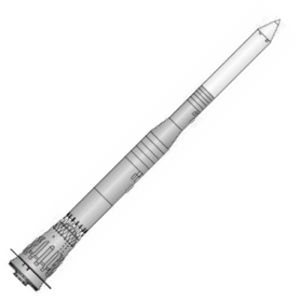 N-IFV-II, III N-IFV-II, III of 1965 |
It is not clear if this letter was sent; and if so, it certainly hurt Korolev with Brezhnev when he would ascend to power in a year's time. But he had convinced Khrushchev of the necessity for a high priority lunar landing project to beat the Americans.
The Lunar Landing Mission and the N-I Upgraded
On 3 August 1964 Command number 655-268 issued by Central Committee of Communist Party for the first time set the objective for OKB-1 to put one man on the moon and return him safely to earth - ahead of the Americans (who had begun over three years earlier, in April 1961). To achieve this aim a large part of the industry had to be mobilized (though not the competing and dissenting Glushko, Yangel and Chelomei enterprises). This would require design of what was designated the L3 complex, with the combined launch vehicle/spacecraft termed the N1-L3. The L3 would utilize the same lunar orbit rendezvous method to achieve moon landing as was selected for the Apollo program. By upgrading the N1 from a 75 metric ton to a 95 metric ton payload capacity it was felt possible that a single N1 launch could accomplish the mission. The L3 complex itself, with a total mass of 95 metric tons, would consist of a fourth stage (Block G) for the N1 to take the L3 from low earth orbit to trans-lunar trajectory; a lunar orbiter with a Soyuz re-entry capsule for return to earth (LOK); a lunar lander (LK) for the landing of a single cosmonaut on the surface of the moon; and a deceleration stage (Block D) which would brake the L3 complex into lunar orbit and then take the LK lander to near zero velocity above the surface of the moon.
The N1-L3 complex was designed not just for a quick initial moon landing, but also for exploration of the moon and near-lunar space for both scientific and military purposes.
 N-IF - 1965 N-IF - 1965 design |
- To measure the physical characteristics of near-lunar space and the lunar surface.
- To place in orbit around the moon and on the surface high precision automatic and manually-operated scientific equipment.
- To solve the navigation and biological problems associated with regular travel along the Earth-Moon trace;
- To conduct detailed photo-reconnaissance of the lunar surface from lunar orbit.
- To conduct research and determine the most effective means for exploiting the moon for military purposes.
- The L3 complex would be injected into a 220 km, 51.8 degree inclination parking orbit of the earth. Up to one day could be spent in earth orbit before trans-lunar injection.
- The Block G stage burned to propellant depletion, putting the complex into translunar trajectory. The Block G then separated.
- During a 3.5 day translunar coast the Block D stage would perform two mid-course corrections. It then would put the LOK/LK/Block D stack into an equatorial elliptical lunar orbit. The Block D would be restarted twice to adjust the orbit, first to a circular 110 km orbit, then to bring the pericynthion down to 14 km. The Block D could restarted for up to 4 days in lunar orbit.
- The LK pilot-cosmonaut would spacewalk from the LOK to the LK and check out the lander and Block D systems.
- The LK/Block D then separated from the LOK. As it approached the landing site, the Block D then began its main burn and braked the LK to 100 m/s at four kilometers above the lunar surface. The Block D then separated and crashed on the moon.
- The LK ignited its engines and hovered to a precision piloted soft landing on the surface.
- The LK cosmonaut would exit the LK to the lunar surface. From six to 24 hours would be spent on the lunar surface.
- The LK Lunar Cabin and Block E ascent stage launched itself from the LK landing gear (LPU) into lunar orbit. It rendezvoused with the LOK and docked using the 'Kontakt' docking system. The LK cosmonaut spacewalked from the LK back to the LOK with the lunar samples. The LK was then cast off.
- After up to one additional day in lunar orbit, the LOK's Block I engine would put the LOK into trans-earth trajectory. 3.5 days was to be spent on the coast back to earth with two midcourse corrections en route.
- Before re-entry, the descent module separated from the LOK with the two cosmonauts aboard. It re-entered the earth's atmosphere over the South Pole at 11 km/sec, skipped back out to space after slowing down to 7.5 km/s, then soared 5,000 km before making final re-entry and landing on the territory of the USSR.
The work for the L3 project was split as follows:
- OKB-1 (Korolev): General management, design of Blocks G and D, design of the engines for Block D, L, and LOK.
- OKB-276 (N. D. Kuznetsov) - engines for Block G
- OKB-586 (Yangel) - the LK lunar lander and the engines for the lander Block E rocket stage
- OKB-2 (Isayev) - the complete propulsion system (tanks, controls, engines) for the LOK lunar orbiter Block I stage.
- NII-94 (V. I. Kuznetsov) - guidance systems for the L3 (LOK/LK/Block D) lunar complex
- NII-AP (Pilyugin) - guidance systems for the LOK
- NII-885 (Ryazanskiy) - radio telemetry systems
- GSKB Spetsmash (Barmin) - N1 launch complex and N1/L3 ground systems
- Saturn Factory (Lyulka OKB) - 40 metric ton thrust engines for the Blocks G and V. They would also work with OKB-1 in design for the 8.5 metric ton thrust Block D engine, derived from the third stage engine developed for Korolev's GR-1/8K713 FOBS missile.
 N-IMV-II,III |
The original N1 with its payload of 75 metric tons to a 300 km, 65 degree inclination orbit would require two to three launches to assemble a lunar landing expedition in earth orbit. One result of the draft project was the decision to increase the N1 payload to 95 metric tons to allow the L3 to be launched toward the moon in one launch. The following measures would increase the N1 payload to 91.5 metric tons:
- reduction of the altitude of the earth parking orbit from 300 km to 220 km
- an increase of the propellant mass of the first stage by 25% (350 metric tons) by supercooling the propellants prior to loading in the launch vehicle (the kerosene to be at -15 to -20 degrees Centigrade, the liquid oxygen at -191 degrees Centigrade)
- addition of six engines to the first stage
- an increase in thrust of all the engines on the first, second, and third stages by 2%
Then the following measures would increase the payload to 95 metric tons:
- Replace the steel helium pressurization tanks with plastic tanks
- Reduce the parking orbit inclination from 65 degrees to 51.8 degrees
- Reduce the telemetry equipment in operational vehicles
The 3 August 1964 decree foresaw completion of manufacture of the N1-L3 to the following schedule: 4 in 1966; 6 in 1967; and 6 in 1968. By September 1964 construction began of the first N1 launch pad (LC110R). Then on October 13, while Voskhod 1 was in orbit, Khrushchev was removed from power and Brezhnev's faction assumed control of Politburo. This immediately led to a shift of political forces. Chelomei lost his main patron and Korolev immediately again attempted to gain control of the L1 manned circumlunar project. Many of Chelomei's pet projects, such as the R Raketoplan, the K Kosmoplans, and their UR-200 booster, were cancelled.
Meanwhile the advance design project for the N1-L3 was completed in collaboration with Kuznetsov's OKB-586 on 30 December 1964. The decree for production of 16 shipsets of spacecraft and boosters was issued on 26 January 1965. After several skirmishes during the year, on 25 October 1965 the Chelomei circumlunar project was given to Korolev and Chelomei's LK-1 manned capsule was cancelled. The new scenario would use a stripped version of Korolev's Soyuz atop Chelomei's UR-500 Proton launch vehicle. While a victory for Korolev, it was an added project at a time that the N1-L3 was in serious technical and schedule problems. Korolev had begun to admit to his colleagues that the moon landing could not come until 1969 at the earliest. He also noted that while development of the Soyuz was proceeding on schedule, Chelomei's LK-1 was badly lagging behind (although the Proton booster was on schedule).
On 25 August 1965 a knock-down-drag-out meeting was held between Ustinov and the Chief Designers. Although he was a received as much criticism as he gave, Korolev's hand in engineering the meeting to wrest control of the LK-1 from Chelomei can be seen. Ustinov contracted the mounting successes of the American space projects with the continuing delays and failures of the Soviet projects. The problems were clearly gross underfunding of the entire program and duplication of effort between the Chief Designers. The Chief Designers fought bitterly and would not back down. But it was clear finally to the leadership that some drastic reorganisation was required to keep up in the space race. Korolev could see that he would soon have the whole thing under his control at last.
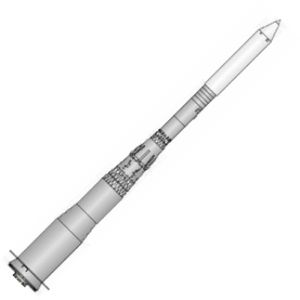 N-IMV-III |
After completing production drawing release, Korolev's design teams could consider future improved variants of the N1. On November 9, 1965 a four volume study was issued covering these variants. These were:
- N-IU would be the initial production version of the N1 following the mad rush to make the lunar landings. It would have essentially the same payload but would be substantially re-engineered for sharply improved reliability, most notably with autonomously operating engines. It is interesting to note that four years before the disastrous first flight Korolev already foresaw the potential engine problems that would be the downfall of the project.
- N-IF would be the first follow-on version with increased performance. The first stage engines would be increased in thrust from an average of 150 metric tons to 175 metric tons, and those in the second stage from 150 metric tons to 200 metric tons. The second and third stages would be substantially enlarged.
- N-IM would mark an tremendous increase in vehicle size and was the ultimate pure liquid oxygen/kerosene version considered. The first stage engines would be increased to 250 metric tons thrust, without reducing reliability, through use of higher engine chamber pressure. Propellant load in the first stage would be almost doubled. Second stage engine thrust would increase to 280 metric tons each and the second and third stages again enlarged.
- N-IUV-III would replace the N-IU's conventional third stage with a LOX/LH2 cryogenic third stage. This was seen at the time as the first step in exploitation of cryogenic technology in Russia. Although pursued for some time, this large stage never went into development. The more modestly-sized Block R, Block S, and Block SR instead were put into development in the early 1970's.
- N-IFV-III would add the Block V-III cryogenic third stage to the first and second stages of the N-IF.
- N-IM-III would add the Block V-III cryogenic third stage to the first and second stages of the N-IM. This provided the second-highest performance of the variations considered and would certainly have been cheaper than the N-IFV-II, III.
- N-IFV-II, III would use only the first stage from the N-1F, and use new cryogenic second and third stages. This cryogenic second stage seems not to have been pursued beyond the study phase.
- N-IMV-II, III was the ultimate conventionally-powered N1 ever considered. It paired the monster N-1M first stage with new cryogenic second and third stages. Both lift-off thrust and payload of this vehicle would have been double that of the American Saturn V.
At this critical juncture Korolev learned that he was terminally ill with cancer of the colon.
The Death of Korolev - the Race to the Moon - Advanced Upper Stages - 1966 to 1969
 N-IUV-III |
The project continued. In February 1966 construction started of the second N1 launch pad (LC 110L). By November the first N1 hardware arrived at Baikonur and construction of the 1M1 full-size mock-up of the launch vehicle began. On 16 November 1966 another Keldysh-headed expert commission considered the state of the program. With Korolev dead, once again Glushko, Chelomei, and Yangel advocated development of the UR-700 or R-56 in lieu of the N1. While it was agreed that engine development and studies of these launch vehicles could continue, the government decree issued approved Mishin's draft plan for the first lunar landing. The first N1 launch was now to be in March 1968 (two years late to the very optimistic schedule set when the project was first full approved).
In February assembly of the first N1 began at the Progress plant in Samara. On March 10 1967 Cosmos 146 was launched in the first test of hardware (the Block D stage and L1 lunar spacecraft) to be used in the L1 and L3 projects. The boilerplate Soyuz 7K-L1 was launched by a Proton into the planned highly elliptical earth orbit. The Block D stage functioned correctly in its first test, putting the spacecraft into a translunar trajectory. The spacecraft was not aimed at the moon and no recovery was planned or attempted. This successful launch created a false confidence just before the string of failures that would follow. On April 8 Cosmos 154 reached earth orbit but the Block D translunar injection stage failed to fire (ullage rockets, which had to fire to settle propellants in tanks before main engine fired, were jettisoned prematurely). The spacecraft burned up two days later when its orbit decayed.
N1 Flight Test Begins - 1968-1969
By the end of summer the first N1 launch pad (LC110R) was completed. In addition to the sixteen flight vehicles, two N1 mock-ups were being built to support pad compatibility tests. Assembly of the first 1M1 mock-up was nearing completion at the MIK assembly building at Baikonur. In September 1967 the EU-28and EU-29 test models of the second and third stages began hot firing tests on their test stands at Samara. On 25 November 1967 the 1M1 mock-up was first erected on LC-110R. After tests of electrical and hydraulic interfaces on the pad it was returned to the assembly building on 12 December.
A decree in November had recognized yet further slips in the schedule, with a first flight test of the vehicle not expected until the third quarter 1968. By March 1968 it was recognized that no Soviet manned lunar landing would take place until 1970. On May 7, 1968, eight months behind the 1966 schedule, N1 booster 4L was erected at launch complex 110R. Under its shroud was the 7K-L1S spacecraft. This modification of the 7K-L1 circumlunar Soyuz incorporated the Isayev forward propulsion module that would be used on the LOK and LK. A mass model representative of the LK lander was also included. These early test N1's were limited to a lift-off mass of 2,735 metric tons and had an earth orbit payload of 70 metric tons. Even so it has taken 165 train wagon-loads of material to construct the vehicle, as against the 43 estimated in the 1962 draft project.
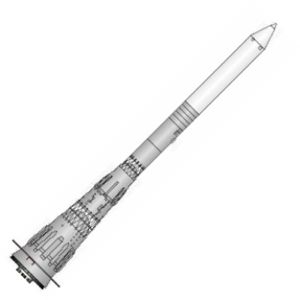 N1FV-III N-IFV-III design of 1965 |
Returned to the MIK, the flight payload taken from 4L, the 7K-L1S, was integrated with the 1M1. The 1M1-L1S was moved back to the pad in November to conduct tests of the payload. It was joined by 3L, erected on launch pad without its payload (which was on the 1M1 mock-up). This was the first, but not the last, dual N1 roll-out. 3L was put through a series of engine system tests. In January 3L was returned to the MIK and the L1S payload was integrated to the launch vehicle. Also under the L3 payload shroud was an LZS functional test model of the LK.
The first 28 day long N1 countdown began in January with the roll-out of 3L to the pad. Mishin personally led 2,300 technicians in around-the-clock shifts to prepare the vehicle for its first flight. Fifty tanker cars of propellants were required to fuel the booster. The initial planned launch on February 20 was scrubbed because of weather. Finally, on February 21, 1969, N1 serial number 3L rose into the sky, thundering over the roofs of the assembly worker's apartments as they cheered it on. But trouble was afoot. Small metallic particles lodged in the gas generator turbine of engine 2. This resulted in a rising high frequency oscillation, eventually causing some engine components to fatigue and tear off their mounts. A forced leak of propellants followed, setting in motion a fire in the tail compartment. The KORD's BKS engine monitoring system detected the fire, but then gave an incorrect signal shutting down all engines at 68.7 seconds into the flight. The vehicle was destroyed by range safety 1.3 seconds later. The SAS escape tower worked as designed and the 7K-L1S capsule was recovered. The main body of the rocket impacted 45 km downrange from the launch pad. British intelligence detected the launch attempt, but the CIA's technical means for some reason missed it and they denied for years that it had ever occurred.
The failure of the KORD was attributed to the much higher than expected temperatures in the engine compartment. The next vehicle, 5L, was modified by having the KORD moved to the intertank compartment. Additionally, ventilation openings to the engine compartment were introduced below the fuel line fairings.
Against this failure, the Apollo program was achieving success after success in bimonthly missions. While beating the Americans to a moon landing was now clearly impossible, a dual unmanned mission was devised, which, if successful, would have stolen a little of the American's thunder. The plan was for the next N1 to launch an unmanned 7K-L1S spacecraft on a loop around the moon. It would take multi-spectral photographs of the lunar surface and far side. Meanwhile, a Proton rocket would launch an unmanned Ye-8 soil return spacecraft. This would soft land on the moon, deploy a core drill which would take a small sample of lunar regolith. Deposited in a small spherical re-entry capsule, this then would automatically be returned to earth.
 Cutaway of N1 Credit: RKK Energia |
The investigation of this failure would result in substantial modifications to the N1 and it would be two years until the next launch attempt. The accident investigation commission came to three main conclusions: the engines must be redesigned with filters to prevent ingestion of metal splinters and shavings into the turbine machinery; the KORD logic must be modified to prevent unnecessary shut down of engines; and the launch vehicle trajectory had to be modified so that it moved away from the pad as soon as it cleared the tower.
With the moon race lost, the rationale for further development of the limited 7K-LOK and LK spacecraft for a dash to the moon disappeared. The LK would be test flown in the coming years, but the LOK never was. Mishin instead looked towards using the N1 to establish a moon base (LEK - Lunar Expeditionary Complex).
Redesign and New Missions - 1969 to 1974
The three-year job of rebuilding Pad 110R began on August 3, 1969. By September 24 an N1 was erected on launch pad 110L to test the launch pad interfaces. This all-white launch vehicle, with no payload, was either the N1 mock-up 1M1 or flight vehicle 6L. This was the first use of the all-white paint job - the previous grey and white scheme had resulted in summer temperatures of up to 60 degrees Centigrade in the intertank compartments.
It was not until May 18 of 1970 that US reconnaissance satellites detected another N1 being installed on the pad. Again with no payload, it remained there at least through 4 June.
Against these failures, development was already underway to develop more powerful versions of the N1 to launch heavier payloads to the moon. The N1 growth study S. P. Korolev had signed shortly before his death had foreseen the wide use of oxygen-hydrogen propellants in modified versions of the N1 launch vehicle.
It will be recalled that the 1965 study foresaw development of a Block V-II Lox/LH2 replacement for the Block B second stage of the N1. At OKB-276 N. D. Kuznetsov led a project to develop a liquid oxygen/liquid hydrogen version of the NK-15V engine with a flight thrust of 200 metric tons for use in this modernized version of the second stage of the N1. However Kuznetsov was having enough difficulty in completing satisfactory development of the conventional version of this engine for use in the basic N1 and his 200 metric ton engine did not reach the hot firing test stage.
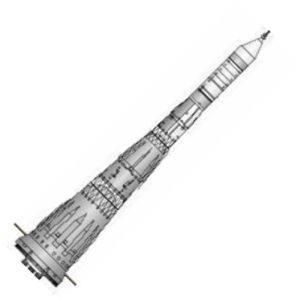 N1F - Sr N1F with Sr Lox/LH2 upper stage |
Isayev set about adapting the 11D56 engine, with a vacuum thrust of 7.5 metric tons, for the Block R. This engine had originally been designed in the early 1960's for use in the third stage of an uprated Molniya-L launch vehicle. The new Block R for the N1 was to have an empty mass of 4.3 metric tons, a maximum fuel load of 18.7 metric tons, and would have been 8.7 m long and 4.1 m in diameter.
Lyulka developed two variants of a 40 metric ton engine - the 11D54 (with fixed chamber) and 11D57 (with gimballed chamber). These would be used for the new Block V-III third stage of the N1 (3 to 6 11D54) and in the Block S (one 11D57).
First hot firings of the 11D56 on the test stand began in June 1967. Both the 11D56 and 11D57 engines successfully completed their state development test series.
At the Tsniimash museum in Korolev a photograph is displayed of a dynamic test model of an N1 configuration that has been called N1M. This model shows an N1 first stage, with a Block V-III second stage, and Blocks S and R third and fourth stages. Calculations indicate that a two stage Block A / Block V-III N1 would have a low earth orbit payload comparable to that of the basic N1 (around 95 metric tons). Evidently this configuration was considered as an alternative to a conventional three stage N1 for launching the L3M complex into low earth orbit.
The original draft project for the new N1M-L3M lunar landing complex anticipated use of a two-launch profile. On the first launch a Block R RTB braking stage would be put on a translunar trajectory. The RTB would place itself in lunar orbit. Next, the manned L3M lunar lander would be launched. This new spacecraft was much larger than the LK, with a mass of 21 metric tons landed on the lunar surface. The L3M would dock, tail-first, with the RTB stage in lunar orbit. The RTB would act as a lunar crasher stage. The L3M would separate from the RTB just over the lunar surface, then hover to a soft landing. The crew would spend up 16 days on the surface. Following completion of their work, the landing legs would be left behind, and the L3M would launch itself on a trans-earth trajectory. Just before arrival at earth, the crew would enter their Soyuz capsule, separate from the L3M, and make a lifting re-entry into the earth's atmosphere. It was felt that within the existing funding allocation of the original N1-L3 program, enough N1's would be available to support a series of landings in 1978-1980.
 N1M 1974 N1M of 1974 |
The N1 that would utilize these engines was designated the N1F (this had no relation to the much more powerful N1F design of 1965 - it was more like the N1U 'perfected' N1 design of the same year). With a payload to a 225 km orbit of 105,000 kg, the N1F would use the new engines, higher density superchilled propellants in all stages, lighter stage structures and numerous detailed changes. Following extensive wind tunnel studies, the boat tail was again redesigned in detail to cope with gas dynamics problems. A cylindrical base reduced the vehicle maximum diameter from 16.9 m to 15.8 m. Four high-thrust roll 'steering' engines were later added to prevent the loss of control that would destroy the 6L launch vehicle. The KORD was completely redesigned, a fire extinguishing system was installed, improved isolation of cabling and electronics was introduced. The telemetry system was reduced in weight while increasing the number of points measured from 700 to 13,000.
Full go-ahead to develop a liquid hydrogen/liquid oxygen high energy upper stage for the N1F finally came in June 1970. The decision was made to develop a multi-engine Block Sr with a propellant mass of 66.4 metric tons. This single stage would be used in place of the previously-planned Blocks S and R to insert spacecraft of the Lunar Expeditionary Complex (LEK) into low lunar orbit. It was also to be used to insert heavy spacecraft into geosynchronous orbit and on interplanetary trajectories. The increased payload of the N1F, combined with the Block Sr stage, would allow a single N1F launch to place 27 metric ton spacecraft on the lunar surface. The L3M lander could be increased in capability to allow three month stays on surface.
It was decided to incrementally test the planned changes for the N1F lower stages, but using the old engines. Vehicle 6L was substantially improved, incorporating filters in the propellant lines to prevent any foreign objects from getting into the pumps.. The shape of the tail of the booster was modified, and ventilation and refrigeration systems were added to keep the engine compartment cool. It was rolled out with the all-white paint scheme. A planned June 23, 1971 launch was delayed for three days by heavy rain. On June 27, almost two years after the last attempt, N1 serial number 6L thundered into the sky. After lift-off and ascent, the vehicle made the new evasive maneuver to move away from the pad. The axial rotation this started was aggravated by the by gas dynamics interactions of the thirty engines with the air slipstream. The launch vehicle developed a roll beyond the capability of the control system to compensate. 6L began to break up as it went through Max Q. Control was lost at 50.2 seconds into the flight and it was destroyed by range safety a second later. The main body of the rocket impacted 20 km downrange. However the engines functioned well and did not shut down up to the point of vehicle destruction. No functional payload was carried and this launch did not have a working launch escape system. Although still counted as a failure, the technical difficulties were being solved one-by-one.
 N1M cutaway Credit: © Mark Wade |
Zvezda would have utilized unmanned spacecraft designed by the Lavochkin OKB to conduct initial reconnaissance of the prospective moon base site. These would use lunar soil core drills to obtain samples of the soil and return them to earth for analysis, and Lunokhod rovers to survey the site. If the site was found to be satisfactory, these craft had radio beacons which would guide follow-on elements of the base to precision landings.
Ambitious articulated mobile nuclear-powered Lunokhod laboratories would take the cosmonauts from the landing sites on long-duration traverses of the lunar surface. The Lunokhods were equipped with core samplers and manipulators so that the crew could conduct collection of surface samples from within the pressurized cab without the need to always exit the ship and conduct surface operations in space suits. One of the main objectives of the base would be the location and mining of Helium-3 for use in nuclear fusion reactors on earth. Rare on the earth, Helium-3 was abundant on the moon, having collected in the regolith from the solar wind.
Barmin's lunar base would be crewed by nine cosmonauts and consist of nine modules. These modules would have a length of 4.5 m during launch and transport on the moon. Once position in place on the surface of the moon and inflated with air, they would telescope out to 8.6 m length with a total floor area of 22.2 square meters. Power would be provided by nuclear reactors.
The nine modules would be pre-equipped in the factory for specialized functions: command module, laboratory/warehouse module, workshop module, midpoint module, medical/gymnasium module, galley module with dining room, and three living modules.
In later versions, the manned elements apparently used the improved L3M complex (designed for the follow-on two man lunar landings) to ferry manned crews from earth orbit to lunar orbit and then from lunar orbit to the surface and back. The Block Sr LOX/LH2 stage would be used to insert the components of Zvezda into low lunar orbit.
By 1971 the lunar city project was practically complete and Chief Designer Barmin arranged a meeting with Secretary Ustinov, head of all military and space rocketry. He brought along two of this 'lunatics', Aleksandr Yegorov and Vladimir Yeliseyev. The project was defended in a marathon meeting - nine presentations over six hours. At the conclusion, Ustinov agreed that the project should go ahead - but he couldn't decide, at the pace of a walk or the speed of a freight train. In the event, the point was moot.
 N1M - Sr |
Meanwhile the test flight series continued, albeit at a slow rate. N1 serial number 7L incorporated most of the changes expected for the N1F, except for the new engines, which were still not available. Payload for this mission consisted of a (now obsolete) 7K-LOK lunar orbiter and an LK functional model. The launch of 7L came on November 23 1972. The rocket ascended into the sky, and the engines ran 106.93 seconds, only seven seconds before completion of first stage burnout.
At this point, to reduce the G forces on the vehicle, a programmed shutdown of six engines occurred. Immediately thereafter, the oxidizer pump of engine number 4 exploded. The vehicle was destroyed by range safety before the second stage could separate and begin operation. The root cause was never determined. Mishin blamed the engine designers. Kuznetsov claimed that they were not at fault, saying the shutdown of the central engines had led to propellant line hammering, followed by rupture of propellant lines, resulting in the explosion of engine number 4. All agreed that if the N1 first stage had simply been shut down, and Stage 2 ignited, a successful mission could have followed.
N1 with Aerospike First Stage Engine
While the first N1F vehicle had yet to fly, studies continued on a number of improved N1's. One of these contemplated the use of an aerospike engine in the first stage. Two variants were considered. In the first, the 30 x 151 metric ton thrust NK-15 engines of the first stage were replaced with 24 x NK-15F engines of 188 metric tons thrust. This freed up the center of the stage for a truncated aerospike. As in similar designs advocated by Philip Bono in the United States, hot gas would be bled off from the engines to produce an ‘aerospike' streaming behind the booster, which would contour the combined rocket exhaust into an optimum flow. The advantage of the aerospike was that it ‘auto-corrected' for altitude, providing optimum specific impulse over a range of conditions.
The second variant eliminated the NK-15's completely and used a radical annular combustion chamber that surrounded the aerospike. Detailed mass calculations were made for each variant. The final study found that an improvement was achieved - but probably not one that justified the development expense and risk. The empty mass of the stage increased because the central body of the aerospike and the exhaust gas system were all additional features. Further, the NK-15's were closed cycle engines. Bleeding hot gas from them for the aerospike actually reduced their inherent specific impulse.
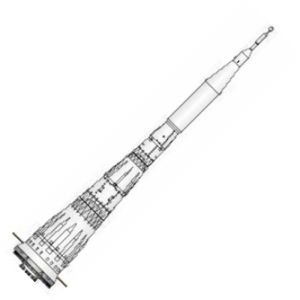 N1F - 1974 N1F - 1974 Configuration (N1 s/n 8L) |
The final conclusion of the study was that the improvement in performance was not worth the development risk in three-stage, low specific impulse designs such as the basic N-1. Using the ‘standard' N1 second and third stages, payload was increased only 5.0% for Variant A and 6.9% for Variant B. It was concluded that the aerospike could provide bigger performance gains in single- or two- stage-to-orbit designs or in upper stages.
The final design comparison was as follows:
| Parameter | Basic Block A | Aerospike Variant A | Aerospike Variant B |
|---|---|---|---|
| Calculated Lift-off Thrust, kgf | 4,530,000 | 4,511,400 | 4,510,500 |
| Effective Lift-off Thrust, kgf | 4,117,000 | 4,420,000 | 4,480,000 |
| Vacuum Thrust, kgf | 5,065,500 | 5,334,400 | 5,379,000 |
| Fuel Consumption, kg/sec | 15,304 | 15,241 | 15,238 |
| Calculated Specific Impulse, Lift-off, sec | 296.0 | 296.0 | 296.0 |
| Effective Specific Impulse, Lift-off, sec | 269.0 | 290.0 | 294.0 |
| Specific Impulse, Vacuum, sec | 331.0 | 350.0 | 353.0 |
| Specific Impulse, Average, sec | 311.0 | 321.0 | 324.3 |
| Stage Empty Mass, kg | 112,230 | 120,250 | 124,700 |
| LEO Payload, kg | 92,700 | 97,350 | 99,090 |
The Last Days
Following the fourth N1 failure, Glushko and Kosberg were brought in to provide independent opinions on how the problems could be solved. Neither came up with inexpensive solutions. Kosberg wanted to equip the rocket with new-development 250,000 kgf engines using N2O4/UDMH. Glushko suggested using the RD-253 engines that he had developed for the UR-500 Proton launch vehicle. Interestingly, this very successful design was the final form of the RD-250 engine that Korolev had rejected for the N1 ten years earlier. But even Glushko had to admit that using the RD-253 would mean converting the N1 to N2O4/UDMH propellants, thereby lowering payload performance to unacceptable levels (just as Korolev had argued). Glushko was also rather dubious of successfully synchronizing the operation of 30 engines.
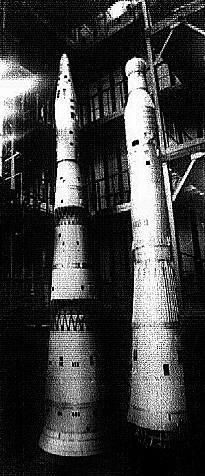 N1 and N-1M N1 and N-1M Dynamic test models Credit: © Mark Wade |
On May 18, 1974 the Minister of Medium Machine Building Afanasyev attended a routine meeting of the management of OKB-1. In a few clipped sentences he informed the group that the Politburo had decided to remove Mishin, replace him with Korolev's old nemesis Glushko and combine the two OKB's into a new entity known as NPO Energia. Afanasyev wished the stunned managers every success, and left the room. The N1 program was cancelled.
The N1- the Accounting
Two fully assembled (serial numbers 8L and 9L), and four partially assembled N1Fs were available at time of cancellation. In all, Kozlov's Progress factory in Samara had delivered components for ten flightworthy N1's, plus the two mock-ups, the engine test stand versions of the upper stages, and several other static test specimens. A total of 3.6 billion rubles was spent on the N1-L3 program, of which 2.4 billion rubles went into N1 development. Another 1.37 billion rubles would have taken the program to completion, including construction of a final total of sixteen flight N-1's, as laid out in the decree of 1964.
The Soviet Union had lost the moon race. In retrospect this seemed inevitable given a three-year later start and a funding level only a fraction that of the Apollo program. Those on the project felt that they were within months of finally providing the Soviet Union with a heavy-lift booster. Instead the work was discarded, and Glushko began design of the Vulkan launch vehicle with an entirely new configuration and engines. This was itself revised on 17 February 1976 when Glushko was directed to modify Vulkan to the Energia configuration to accommodate the Buran space plane (based on US Space Shuttle). Thirteen years and another 14.5 billion rubles later, the Energia flew, only to be cancelled in turn with the collapse of the Soviet Union.
Like a Phoenix, at least parts of the N1F may still fly. The 150 NK-33, NK-39, and NK-43 engines built by Kuznetsov were cocooned and secretly stored at the program's cancellation despite orders to the contrary. After Glushko's death, these were sold to Aerojet, redesignated AJ26's, and considered first for use in the American Atlas IIIA launch vehicle. In 1996 they were selected by Kistler Aerospace for its reusable US launch vehicle. The Kistler never reached production, but the engines were again sold to Orbital for their Taurus II, with a first launch set for 2011/2012 (following explosion of an engine on the test stand). The 11D56 Lox/LH2 engines designed for the Block Sr RTB stage for the L3M also never flew, but the design was sold to India in 1994 for use in its GSLV launch vehicle.
 L3 Cutaway Dimensioned Russian cutaway drawing of L3 manned lunar landing complex. |
References
- Przybilski, Olaf, and Wotzlaw, Stefan, N-1 Herkules - Entwicklung und Absturz einer Traegerrakete, Schriftenreihe der Deutschen Raumfahrtausstellung e.V., 1996.
- Rusakov, K, "'Aerospaik' dlya N-1", Novosti kosmonavtiki, Number 7, 1998, p. 27.
- Semenov, Yu. P., Raketno-Kosmicheskaya Korporatsiya ENERGIYA imeni S. P. Koroleva 1946-1996, RKK Energia, 1994.
- Vetrov, G S, S. P. Korolev i evo delo, Nauka, Moscow, 1998.
| N-1 11A52 The N1 launch vehicle as flown. These test vehicles did not exceed 2735 metric tons liftoff mass and 70 metric ton earth orbit payload capability. Four flight tests, all failures. |
| N1 1962 Russian heavy-lift orbital launch vehicle. Final configuration of the N1 at the time of development go-ahead in 1962. The 75 metric ton payload was to consist of the Raskat dispenser, which would have delivered 17 multi-megaton nuclear warheads, essentially destroying the United States in a single launch. The design also supported the OS-1 heavy space station and TMK manned Mars flyby requirements - as opposed to any manned lunar landing project. |
| N1 1964 Russian heavy-lift orbital launch vehicle. The N1 launch vehicle for the N1-L3 lunar landing mission as described in the draft project of 1964. Design requirement for the single-launch lunar-orbit-rendezvous lunar landing was 2750 metric tons liftoff mass and 95 metric tons low earth orbit payload. The actual N1 that flew in 1969 to 1972 had lighter first and third stages, but never demonstrated a full fuel load using superchilled propellants as planned in the draft project. |
| N1 1969 Russian heavy-lift orbital launch vehicle. The N1 launch vehicle, developed by Russia in the 1960's, was to be the Soviet Union's counterpart to the Saturn V. The largest of a family of launch vehicles that were to replace the ICBM-derived launchers then in use, the N series was to launch Soviet cosmonauts to the moon, Mars, and huge space stations into orbit. In comparison to Saturn, the project was started late, starved of funds and priority, and dogged by political and technical struggles between the chief designers Korolev, Glushko, and Chelomei. The end result was four launch failures and cancellation of the project five years after Apollo landed on the moon. Not only did a Soviet cosmonaut never land on the moon, but the Soviet Union even denied that the huge project ever existed. |
| N1 Nuclear A Russian nuclear orbital launch vehicle. A version of the N1 with a nuclear upper stage was studied by Korolev in 1963. It was concluded that the optimum design would allow a single N1 to launch a direct manned lunar landing and return. However for manned Mars missions, a nuclear electric engine was found to be much more efficient. This essentially killed further consideration of thermal nuclear upper stages within the bureau. |
| N1 Nuclear AF Russian nuclear orbital launch vehicle. A variant of the first alternative considered in the 1963 nuclear N1 study. This was a 'high thrust' version of the Type A engine - apparently with higher propellant rate, lower specific impulse, and lower engine weight. Due to the very low density of the enormous liquid hydrogen upper stages, these immense vehicles would have been very ungainly (and had interesting stress problems during ascent!) |
| N1 Nuclear V Russian nuclear orbital launch vehicle. Second primary alternative considered for the 1963 nuclear N1 study. The immense liquid hydrogen tank of the second nuclear stage would have dwarfed the N1 first stage mounted below it in the shadows. The extremely poor thrust to weight ratio of the Type V engine design compared to that of the Type A remains unexplained. |
| N1 Nuclear V-B Russian nuclear orbital launch vehicle. N1 with nuclear upper stage. This variant of the Type V nuclear engine used a very heavy radiation shield to protect the crew of any manned spacecraft payload. |
| N1/L3 mod. (11A52) Russian orbital launch vehicle variant. |
| N11 Russian heavy-lift orbital launch vehicle. It was originally planned the N1 would form the basis of a family of launch vehicles that could replace existing ICBM-derived boosters. The N11 would use the second, third, and fourth stages of the N1. This would give it a lift-off mass of 700 metric tons and a 20 metric ton payload into low earth orbit. It could replace Chelomei's Proton launch vehicle in the medium-lift role. |
| N11 1963 Russian heavy-lift orbital launch vehicle. A military variant of the N-11 which would use a powerful third stage, probably derived from the first stage of the 8K713 GR-1, to put up to 24 metric tons in low earth orbit. This was a competitor with Chelomei's UR-500K, which was selected instead for the heavy military payload mission. |
| N111 Russian heavy-lift orbital launch vehicle. It was originally planned the N1 would form the basis of a family of launch vehicles that could replace existing ICBM-derived boosters. The N111 would use the third and fourth stages of the N1, and the second stage of Korolev's R-9 ICBM. This would result in a lift-off mass of 200 metric tons and a five metric ton payload. It could replace the R-7 derived boosters (Vostok and Soyuz) in this payload category. |
| N11GR Russian orbital missile. This 1962 project was designed by Korolev's OKB as a competitor to Chelomei's UR-500 against the military GR-2 (Global Rocket 2) requirement. The N-11GR was an adaptation of the basic N-11, derived from the second and third stages of the N1 heavy booster. The GR-2 was to be a kind of enormous multiple-warhead FOBS (fractional orbit bombing system). Surrounding the top of the second stage of the rocket, like bullets in an enormous revolver, were six final stages derived from the 8K713 GR-1 last stage. Each stage had a 1,500 kg nuclear warhead. |
| N1F Russian heavy-lift orbital launch vehicle. The N1F would have been the definitive flight version of the N1, incorporating all changes resulting from the four flight tests of the vehicle, including the new Kuznetsov engines and 10% greater liftoff mass by using superchilled propellants in all stages. N1 8L would have been the first N1F configuration flight, with launch planned in the third quarter of 1975 at the time the project was cancelled. |
| N1F Sr Russian heavy-lift orbital launch vehicle. The final more modest version of the N1F replaced the fourth and fifth stages of the N1 with the single liquid oxygen/liquid hydrogen Block Sr stage. Development of the Sr stage was from May 1971 until cancellation of the N1 project in May 1974. |
| N1F-L3M Russian heavy-lift orbital launch vehicle. The N1M was found to be too ambitious. The N1F of 1968 was instead penciled in to be the first Soviet launch vehicle to use liquid oxygen/liquid hydrogen high energy cryogenic propellants. The N1F would have only used the Block S and Block R fourth and fifth stages in place of the N1's Block G and Block D. |
| N1M Russian heavy-lift orbital launch vehicle. The N1M was to be the first Soviet launch vehicle to use liquid oxygen/liquid hydrogen high energy cryogenic propellants. It was designed to launch payloads in support of the LEK lunar expeditions (two cosmonauts on the surface), the DLB (long-duration lunar base), and heavy unmanned satellites into geosynchronous and interplanetary trajectories. As originally conceived, the advanced propellants would be used in all upper stages. However due to delays in Kuznetsov development of a 200 metric ton thrust LOx/LH2 engine, the final version used an N1 first stage, with a Block V-III second stage, and Blocks S and R third and fourth stages. |
| N1-MOK Russian heavy-lift orbital launch vehicle. Ultimate derivative of N1. Single-stage-to-orbit vehicle based on N1 Block A. Propellants changed to LH2/LOX, 16 x modified NK-33 engines + 4 Liquid Air Cycle Engine Liquid Air/LH2 boosters. All figures estimated based on tank volume of Block A and delivery of 90,000 kg payload to 450 km / 97.5 degree MKBS orbit. Briefly described in RKK Energia official history and in some detail in Peter James' 1974 book Soviet Conquest from Space! |
| N-IF 1965 Russian heavy-lift orbital launch vehicle. The N-IF would be the first follow-on version with increased performance. The first stage engines would be increased in thrust from an average of 150 metric tons to 175 metric tons, and those in the second stage from 150 metric tons to 200 metric tons. The second and third stages would be substantially enlarged. |
| N-IFV-III Russian heavy-lift orbital launch vehicle. Then N-IFV-III would add the Block V-III cryogenic third stage to the first and second stages of the N-IF. |
| N-IFV-II-III Russian heavy-lift orbital launch vehicle. N-IFV-II, III would use only the first stage from the N-1F, and use new cryogenic second and third stages. This cryogenic second stage seems not to have been pursued beyond the study phase. |
| N-IM 1965 Russian heavy-lift orbital launch vehicle. The N-IM would mark an tremendous increase in vehicle size and was the ultimate pure liquid oxygen/kerosene version considered. The first stage engines would be increased to 250 metric tons thrust, without reducing reliability, through use of higher engine chamber pressure. Propellant load in the first stage would be almost doubled. Second stage engine thrust would increase to 280 metric tons each and the second and third stages again enlarged. |
| N-IMV-III Russian heavy-lift orbital launch vehicle. Then N-IMV-III would add the Block V-III cryogenic third stage to the first and second stages of the N-IM. This provided the second-highest performance of the variations considered and would certainly have been cheaper than the N-IFV-II, III. |
| N-IMV-II-III Russian heavy-lift orbital launch vehicle. N-IMV-II, III was the ultimate conventionally-powered N1 ever considered. It paired the monster N-1M first stage with new cryogenic second and third stages. Both liftoff thrust and payload of this vehicle would have been double that of the American Saturn V. |
| N-IU Russian heavy-lift orbital launch vehicle. The N-IU would be the initial production version of the N1 following the mad rush to make the lunar landings. It would have essentially the same payload but would be substantially re-engineered for sharply improved reliability, most notably with autonomously operating engines. It is interesting to note that four years before the disastrous first flight Korolev already foresaw the potential engine problems that would be the downfall of the project. |
| N-IUV-III Russian heavy-lift orbital launch vehicle. The N-IUV-III would replace the N-IU's conventional third stage with a LOX/LH2 cryogenic third stage. This was seen at the time as the first step in exploitation of cryogenic technology in Russia. Although pursued for some time, this large stage never went into development. The more modestly-sized Block R, Block S, and Block SR instead were put into development in the early 1970's. |
| Superraket Russian nuclear orbital launch vehicle. The ancestor of the N1 lunar launch vehicle, this was the first heavy lift launch vehicle actively considered in the USSR. The 2,000 metric ton liftoff mass was similar to the later N1 design, but the first stage would use a staggering cluster of around 66 Kuznetsov NK-9 engines (as opposed to the modest 24 NK-15's of the first N1 configuration). The real difference was in the second stage, which used the nuclear YaRD engine, giving the launch vehicle nearly double the later N1's payload capacity. |
| YaKhR-2 Russian nuclear-powered orbital launch vehicle. First large space launcher considered in the Soviet Union. It would have had the same layout as the R-7, but with six strap-ons increased in size by 50%. The core, igniting at altitude, used a nuclear thermal engine using ammonia as propellant. Dropped in favor of development of conventional chemical propulsion. |
Country: Russia. Engines: NK-19, NK-15V, NK-21, 8D415K, NK-15, RD-54, RD-58. Spacecraft: MPK, TMK-E, TMK-1, Vostok, OS, L1-1960, L4-1960, TKS Heavy Space Station, OS-1962, OP, OS-1 (1965), DLB Module, L3-1963, L4-1963, L5-1963, Global Communications Satellite Using Nuclear Power, Mavr, L3, KK, Soyuz 7K-OK, OS-1 (1969), Soyuz 7K-L1, L5-1967, L3M-1970, DLB Lunar Base, Mars 5NM, Luna Ye-8, Soyuz 7K-L1A, Luna Ye-8-5, MKBS, MEK, OS-1 Lunar, LK, Soyuz 7K-LOK, DLB Lunokhod 1, DLB Lunokhod 2, DLB Lunokhod 3, L3M-1972. Launch Sites: Baikonur, Baikonur LC110R, Baikonur LC110L. Stages: N1 Block G, N1 Block V, N1 Block B, N1 Block A, N1 Block D. Agency: Korolev bureau. Bibliography: 123, 125, 164, 165, 168, 2, 21, 23, 283, 288, 32, 367, 376, 474, 51, 57, 69, 70, 72, 75, 77, 84, 89, 96.
 | N1 Pad Construction N1 Pads Under Construction Credit: RKK Energia |
 | N1 Side View Credit: © Mark Wade |
 | N1 LV Credit: © Mark Wade |
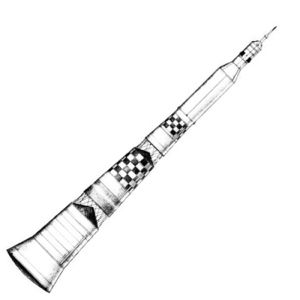 | N1 Early Design Early design of N1 with aerospike first stage Credit: Gleb Aleksushin |
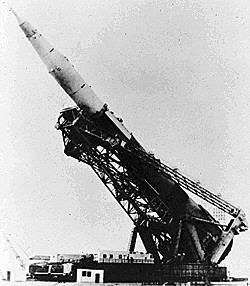 | Early model of N1 Early model of N1 being erected by the Grasshopper carrier. A retouched version of this photo was the first one released to the West. Credit: RKK Energia |
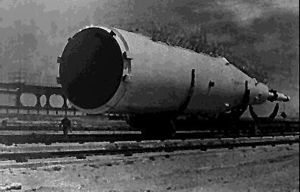 | N1-L3 Payload Shroud Credit: © Mark Wade |
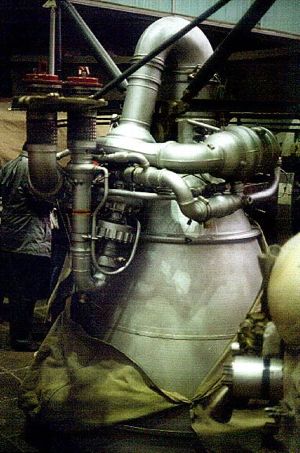 | NK-15 / 11D51 NK-15 / 11D51 rocket engine for first stage of N1 Credit: © Mark Wade |
 | NK15 engine NK-15 / 11D51 rocket engine for first stage of N1 Credit: © Mark Wade |
 | N1 base heat shield Close-up of N1 base heat shield, with openings for six centre engines, used as a gazebo at Baikonur. Credit: © Mark Wade |
 | N1 base heat shield N1 base heat shield, with openings for six centre engines, used as a gazebo at Baikonur. Credit: © Mark Wade |
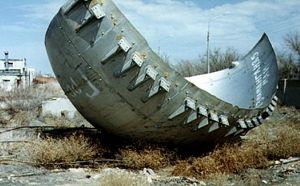 | N1 propellant tank N1 propellant tank dome, abandoned at Baikonur Credit: © Mark Wade |
 | MIK Assembly Bldg External view of the colossal MIK N1 / Energia / Buran Horizontal Assembly Building. Credit: © Mark Wade |
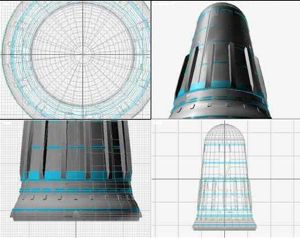 | N1 Stage 1 Views of computer model of N1 first stage Credit: new |
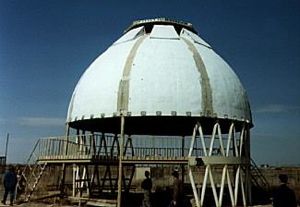 | N1 propellant tank N1 propellant tank dome, used as gazebo at Baikonur Credit: © Mark Wade |
 | N1 5L night launch Credit: RKK Energia |
 | N1 on pad at night Credit: © Mark Wade |
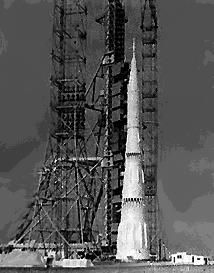 | N1 B Credit: RKK Energia |
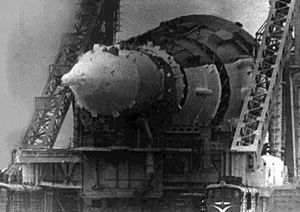 | N1 5L Rollout Credit: © Mark Wade |
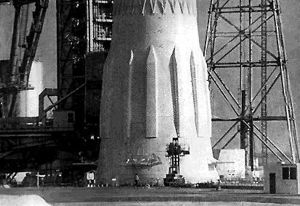 | N1 7L on pad Note modified first stage fairings on N1 7L Credit: RKK Energia |
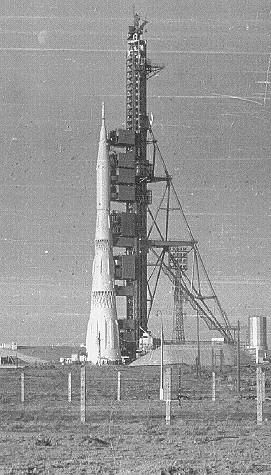 | N1 vehicle 7L Credit: Ed Cameron |
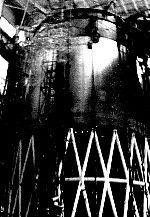 | N1 second stage N1 second stage undergoing dynamic test. This is believed to be the N1M version of the stage, showing the insulation panels to protect the cryogenic propellants. Credit: © Mark Wade |
 | N1 test model N1 dynamic test model in the stand at Tsniimash. Credit: © Mark Wade |
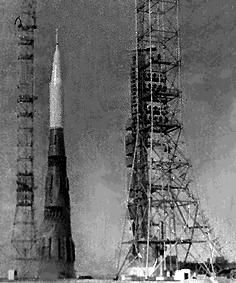 | N1 3L on pad Credit: RKK Energia |
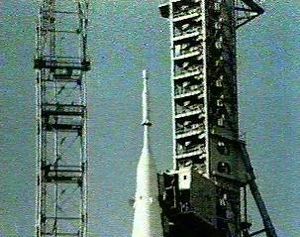 | N1-L3 Tower Detail of tower of N1-L3 7L Credit: RKK Energia |
 | N1 6L lift-off Credit: RKK Energia |
 | N1 5L Explosion Final explosion of N1 5L, destroying pad. Credit: RKK Energia |
 | 2 N1s Mounted on Pad Credit: RKK Energia |
 | N1 5L Falls Back Having just cleared the tower, N1 5L falls back onto the pad at a 45 degree angle. Credit: RKK Energia |
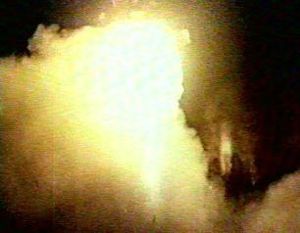 | N1 5L clears tower N1 5L Clears the tower but falters as the KORD system incorrectly shuts down engines. Credit: RKK Energia |
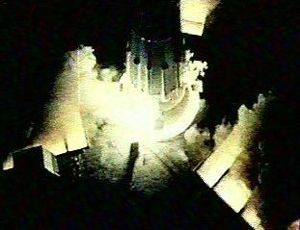 | N1 5L lift-off Engine ignition of N1 5L. Credit: RKK Energia |
 | N1 7L lift-off N1 7L rises over the apartment blocks of the workers that built it Credit: RKK Energia |
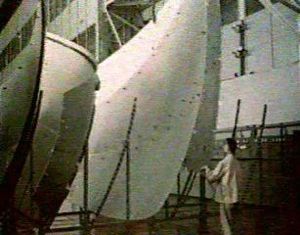 | N1 subassemblies N1 tank sections were built in Samara, then shipped to Baikonur for assembly of the launch vehicle. Credit: RKK Energia |
 | N1 stages N1 stages in the assembly hall Credit: RKK Energia |
 | N1 tank assembly Subassemblies from Samara were built up into stage bulkheads on assembly jigs at Baikonur. Credit: RKK Energia |
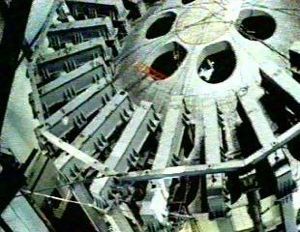 | N1 boattail assembly Base of N1 first stage in assembly jig Credit: RKK Energia |
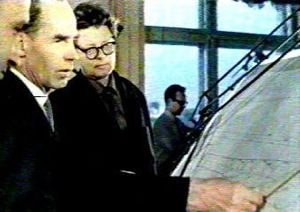 | N1 engineers N1 engineers study drawing Credit: RKK Energia |
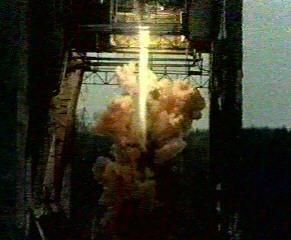 | N1 Engine fired N1 Engine fired on test stand Credit: RKK Energia |
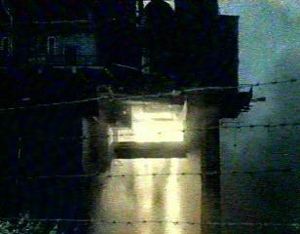 | N1 Upper Stage N1 Upper Stage firing on test stand Credit: RKK Energia |
 | N1 6L Lift-off Credit: RKK Energia |
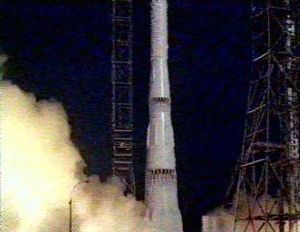 | N1 6L ignition Credit: RKK Energia |
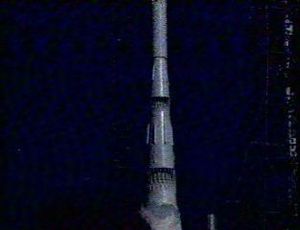 | N1 6L Engine Start Credit: RKK Energia |
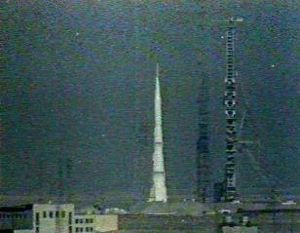 | N1 7L Lift-off Credit: RKK Energia |
 | N1 MIK Assembly Hall CIA's National Intelligence Estimate of March 1967 Credit: RKK Energia |
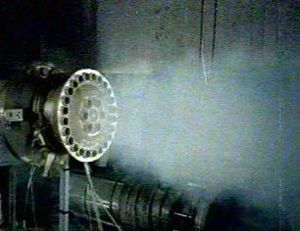 | N1 Model Test Credit: RKK Energia |
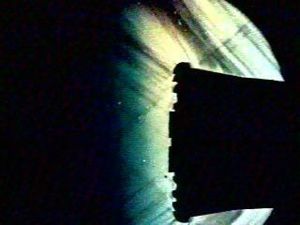 | N1 Wind Tunnel Test Credit: RKK Energia |
 | N1 Subscale Model Credit: RKK Energia |
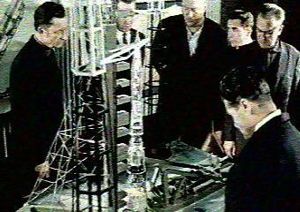 | Model of N1 pad Credit: RKK Energia |
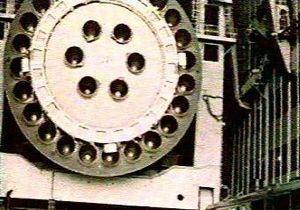 | N1 Rollout N1 Rollout - base of booster Credit: RKK Energia |
 | N1 Rollout N1 Rollout - view from inside MIK Credit: RKK Energia |
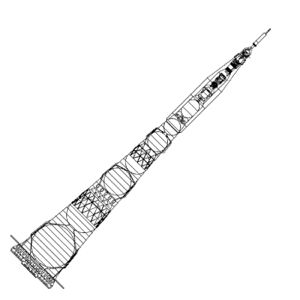 | N1 Cutaway Credit: © Mark Wade |
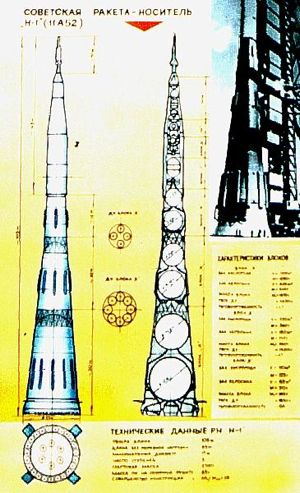 | N1 Diagram Korolev Diagram of N1 launch vehicle at Korolev. Credit: Jakob Terweij |
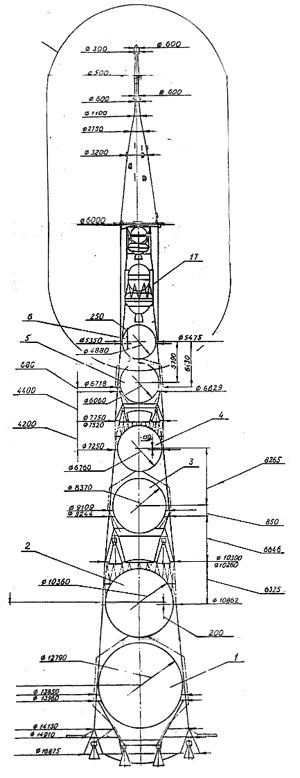 | N1 Cutaway Dimensioned Russian cutaway drawing of N1 launch vehicle. |
 | N1 Variants N1 Launch Vehicle Family Credit: © Mark Wade |
 | YaKhR-2 exterior YaKhR-2 Nuclear-powered Launch Vehicle Credit: © Mark Wade |
 | N1 - 1962 N-I as per draft project, 1962 |
 | N-IIGR - 1962 N-IIGR Multi-Warhead FOBS, 1962 |
 | N1 early concept Credit: © Mark Wade |
 | N-III 1962 |
 | R-56 test model R-56 dynamic test model Credit: © Mark Wade |
 | N1-L3 - 1964 N1-L3 as per advanced project, 1964 |
 | N1 Late Versions Late versions of N1: from left: N1F; N1M; N1F with Block S, R upper stages; N1F with Block Sr upper stage; Airbreathing N1 for MOK support; Kistler |
 | N-IF Variants N-IF Versions, from left: N1-L3; N-IF; N-IUV-III; N-IFV-III; N-IFV-III,II |
 | N-IFV-II, III N-IFV-II, III of 1965 |
 | N-IMV-II,III |
 | N-IUV-III |
 | N-IMV-III |
 | N-IM 1965 N-IM version of 1965 |
 | N1FV-III N-IFV-III design of 1965 |
 | N-IF - 1965 N-IF - 1965 design |
 | Cutaway of N1 Credit: RKK Energia |
 | N1M cutaway Credit: © Mark Wade |
 | N1F - Sr N1F with Sr Lox/LH2 upper stage |
 | N1F - 1974 N1F - 1974 Configuration (N1 s/n 8L) |
 | N1M 1974 N1M of 1974 |
 | N1M - Sr |
 | N1 and N-1M N1 and N-1M Dynamic test models Credit: © Mark Wade |
 | L3 Cutaway Dimensioned Russian cutaway drawing of L3 manned lunar landing complex. |
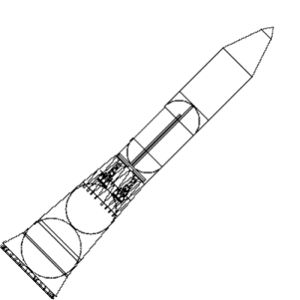 | Superraket Credit: © Mark Wade |
 | Blok SR Credit: RKK Energia |
 | Blok SR Credit: © Mark Wade |
1957 During the Year - . Launch Vehicle: N1.
- USSR starts ion engine development - .
Nation: Russia.
Related Persons: Feoktistov,
Korolev.
Spacecraft Bus: TMK.
Spacecraft: TMK-E.
At the urging of S P Korolev, OKB-1 Section 12, led by M V Melnikov, started development of an ion engine. By 1959 it would be proposed that clusters of the 7.5 kgf thrust ion engine could take the TMK-E manned Mars spacecraft on a low acceleration spiralling trajectory away from the Earth until it finally reached escape velocity and headed toward Mars. But to power even such a limited engine solar panels with a total area of 36,000 square meters would be required - clearly beyond 1959 technology. Feoktistov's solution was to turn to the use of a nuclear reactor to power the ion engine.
1959 During the Year - . Launch Vehicle: N1.
- TMK Heavy Piloted Interplanetary Spacecraft - .
Nation: Russia.
Spacecraft Bus: TMK.
Spacecraft: TMK-1.
In 1959 a group of enthusiasts in OKB-1 Section 3 under the management of G U Maksimov started engineering design of this first fantastic project for manned interplanetary travel. The requirements for executing this project would shape the specifications for the N1 launch vehicle.
The TMK-1 would then be put on a free flight trajectory towards Mars. After 10.5 months it would fly by Mars, dropping remote controlled landers, and then be flung by the gravity of Mars into an earth-return trajectory. Only minor midcourse manoeuvres would be required. The first flight to Mars of the TMK-1 was planned to begin on June 8, 1971, with the crew returning in a re-entry capsule to the earth on July 10, 1974, after a voyage of three years, one month, and two days. A variation of this scenario involved flybys of Venus on the return voyage, and may have been the project given the code name 'Mavr' ('Moor' or MArs - VeneRa).
1959 December 31 - . Launch Vehicle: N1.
- Nuclear propulsion work abandoned. - . Nation: Russia. Related Persons: Korolev. Program: Lunar L3. Korolev abandons work on nuclear-powered rockets. Future launch vehicles to be based on conventional lox/keroesene propellants..
1960 June 23 - . Launch Vehicle: N1.
- Korolev tries to obtain support for a military orbital station - .
Nation: Russia.
Related Persons: Korolev.
Spacecraft: OS.
Korolev wrote to the Ministry of Defence, trying to obtain support for a military orbital station (OS). The station would have a crew of 3 to 5, orbited at 350 to 400 km altitude. The station would conduct military reconnaissance, control other spacecraft in orbit, and undertake basic space research. The N-I version of the station would have a mass of 25 to 30 tonnes and the N-II version 60 to 70 tonnes. Korolev pointed out that his design bureau had already completed a draft project, in which 14 work brigades had participated.
1960 June 23 - . Launch Vehicle: N1.
- Soviet plan for mastery of space issued. - .
Nation: Russia.
Related Persons: Chelomei,
Korolev,
Yangel.
Spacecraft Bus: TMK.
Spacecraft: TMK-E.
Decree 715-296 'On the Production of Various Launch Vehicles, Satellites, Spacecraft for the Military Space Forces in 1960-1967' authorised design of a range of spacecraft and launch vehicles by Korolev, Yangel, and Chelomei. The decree included the N1 (development of launch vehicles of up to 2,000 tonnes liftoff mass and 80 tonne payload, using conventional chemical propellants) and nuclear reactors for space power and propulsion.
1961 February 12 - . Launch Vehicle: N1.
- Space plans - .
Nation: Russia.
Related Persons: Korolev,
Mikhailov.
Program: Vostok.
Flight: Vostok 1.
Spacecraft: Vostok.
Kamanin describes Korolev. He is unable to make a decision about the man's true nature. Everyone is excited about the new seven-year plan, approved on 23 January 1960 in decree 711-296, which authorises design work to start on the N1 superbooster. In the immediate future, Vostok 3KA flights are planned every 8 to 10 days beginning 22 February until the first manned flight is achieved. The first flights will use mannequins to test the cosmonaut ejection seat. A manned flight will be attempted after two consecutive successful mannequin flights.
In the West, the failed Venera 4 launch is being analysed as an attempted manned flight. Some Italians claim to have picked up voices on radio from the satellite. Kamanin describes all of this as unfounded speculation -- the Soviet Union will not risk a man's life until two fully successful mannequin flights demonstrate safe recovery.
1961 May 3 - . Launch Vehicle: N1.
- The draft project of the TKS Heavy Space Station was completed - . Nation: Russia. Related Persons: Korolev. Spacecraft Bus: OS. Spacecraft: TKS Heavy Space Station. Also known as TOSZ - Heavy Orbital Station of the Earth, this was Korolev's first 1961 project for a large N1-launched military space station..
1961 May 13 - . Launch Vehicle: N1.
- Soviet response to Apollo program - .
Nation: Russia.
Related Persons: Chelomei.
Spacecraft: Elektron-A,
Elektron-B,
Kosmoplan,
LK-1,
Raketoplan.
Soviet Decree 'On the Revision of Plans for Space Objects for Accomplishing Goals of Defence Designations--heavy boosters, course of work on Elektron, and suspension of work of work on the Kosmoplan and Raketoplan with continuation of new Raketoplan work' was issued. The decree set the end of 1965 as the date for the first launch of the N1. It also authorised Chelomei to stop work on Kosmoplan interplanetary probes and instead concentrate on a specific Raketoplan design - the LK-1 manned lunar flyby spacecraft.
1961 June 1 - . Launch Vehicle: N1.
- Moon program go-ahead in response to U.S. start - .
Nation: Russia.
Related Persons: Chelomei,
Korolev,
Yangel.
Program: Lunar L1.
Class: Manned.
Type: Manned spacecraft. Spacecraft: LK-1,
Soyuz A,
Soyuz B,
Soyuz V.
Chelomei is informally asked by Khruschev to begin design of a booster and spacecraft for a manned circumlunar mission (UR-500 Proton and LK-1). There is no authorization for a lunar landing program, although Korolev, Yangel, and Chelomei all begin booster designs.
1961 October 12 - . Launch Vehicle: N1.
- TMK-1 draft project was completed. - .
Nation: Russia.
Related Persons: Korolev.
Spacecraft Bus: TMK.
Spacecraft: TMK-1.
Design of the manned Mars flyby spacecraft had involved nearly all sections of Korolev's OKB-1. Those who worked on the TMK included A I Dylnev, A K Algypov, A A Kochkin, A A Dashkov, V N Kubasov, V E Bugrov, and N N Protacov. Kubasov would be selected as a cosmonaut in 1966.
1962 April 12 - . Launch Vehicle: N1.
- First Soviet announcement of manned lunar goals - . Nation: Russia. Program: Lunar L1. Class: Manned. Type: Manned spacecraft. Spacecraft: Soyuz A, Soyuz B, Soyuz V. First Soviet public announcement of manned lunar goals..
1962 April 13 - . Launch Vehicle: N1.
- N1 development slowed. - . Nation: Russia. Decree 'On restriction of work on the N1' was issued..
1962 April 20 - . Launch Vehicle: N1.
- OP -Orbital Belt - .
Nation: Russia.
Related Persons: Korolev.
Spacecraft Bus: OS.
Spacecraft: OP.
Korolev's fantastic 'Orbitalniy Poyas' (OP -Orbital Belt) scheme anticipated Ronald Reagan's Strategic Defence Initiative by 25 years. Two to three large N-I launched military manned stations would control a constellation of strategic assets. Geosynchronous nuclear-powered satellites would provide secure communications. Piloted reconnaissance spacecraft would surprise the enemy, observing military preparations without warning. The orbital stations would provide continuous observations of the territory of the imperialist block.
1962 September 25 - . Launch Vehicle: N1.
- N1 launch vehicle upgraded to accomodate OS-1 75 tonne manned platform with nuclear weapons. - .
Nation: Russia.
Related Persons: Khrushchev,
Korolev.
Class: Earth.
Type: Weather satellite. Spacecraft Bus: OS.
Spacecraft: OS-1 (1965).
Work on the OS-1 began following a meeting between Khrushchev and chief designers at Pitsunda. Korolev was authorized to proceed immediately to upgrade the three stage N vehicle to a maximum 75 tonne payload in order to launch the station. By 1965 the mockup of the huge station had been completed.
1962 November 1 - . Launch Vehicle: N1.
- Chelomei takes over Lavochkin and Myasishchev OKBs - . Nation: Russia. Related Persons: Chelomei, Khrushchev, Lavochkin, Myasishchev. Program: Lunar L1. Class: Manned. Type: Manned spacecraft. Spacecraft Bus: Soyuz. Spacecraft: Soyuz 7K-L1. At Khrushchev's decision Chelomei takes over Lavochkin's OKB-301 and Myasishchev's OKB-23. Lavochkin had built objects 205, 207, 400 (SA-1,2,5); Chelomei UR-96 ABM-1..
1963 March 21 - . LV Family: N1. Launch Vehicle: N1 1964.
- Presidium of Inter-institution Soviet - .
Nation: Russia.
Related Persons: Chelomei,
Glushko,
Keldysh,
Korolev.
Program: Soyuz.
Spacecraft: Soyuz 7K-OK,
Soyuz A,
Soyuz B,
Soyuz V.
The expert commission report on Soyuz is reviewed by the Chief Designers from 10:00 to 14:00. The primary objective of the Soyuz project is to develop the technology for docking in orbit. This will allow the spacecraft to make flights of many months duration and allow manned flyby of the moon. Using docking of 70 tonne components launched by the N1 booster will allow manned flight to the Moon, Venus, and Mars. Keldysh, Chelomei and Glushko all support the main objective of Soyuz, to obtain and perfect docking technology. But Chelomei and Glushko warn of the unknowns of the project. Korolev agrees with the assessment that not all the components of the system - the 7K, 9K, and 11K spacecraft - will fly by the end of 1964. But he does argue that the first 7K will fly in 1964, and the first manned 7K flight will come in 1965.
1963 March 21 - . Launch Site: Baikonur. Launch Complex: Baikonur LC110L. Launch Vehicle: N1.
1963 April 28 - . LV Family: N1. Launch Vehicle: N1 1964.
- N1 Plans - .
Nation: Russia.
Spacecraft: L3-1963,
OS-1 (1965),
TMK-1.
An Inter-Institution Soviet considers Korolev's N1 plans. He believes the first booster will be launched in 1965. The N1 is to have a payload capability of 75 tonnes to a 250 km altitude orbit, 50 tonnes to a 3000 km altitude orbit, and 16 tonnes in geostationary orbit. It could launch spacecraft capable of landing men on the moon and returning them to earth, or manned flybys of Mars or Venus. Three to ten launches would be needed for such missions, with the components being docked together in low earth orbit. The N1 can also be used to launch a large space station for military research. After the N1 discussion a decision is made that cosmonauts will not have to spend more than three to four days in a spacecraft mock-up on the ground to prove their readiness for flight. A simulation of the entire flight duration is not necessary.
1963 May - . Launch Vehicle: N1.
- Nuclear N1 designs - .
Nation: Russia.
Related Persons: Glushko,
Korolev.
At the end of 1961 the Glushko and Bondaryuk bureaux completed their draft projects on nuclear thermal engines for space vehicle upper stages. It was decided to continue work on development of an engine in the 30 to 40 tonne thrust range. In the following year Korolev was asked to study application of such engines, followed by a specific demand in May 1963 from the Scientific-Technical Soviet for specific recommendations. For a Mars expedition, it was calculated that the AF engine would deliver 40% more payload than a chemical stage, and the V would deliver 50% more. But Korolev's study also effectively killed the program by noting that his favoured solution, a nuclear electric ion engine, would deliver 70% more payload than the Lox/LH2 stage. Further investigation of nuclear thermal stages for the N1 does not seem to be pursued. Bondaryuk and Glushko turned to Chelomei and his competing UR-700 rocket for future application of such stages.
1963 September 1 - . Launch Site: Baikonur. Launch Complex: Baikonur LC110L. Launch Vehicle: N1.
1963 October 4 - . Launch Vehicle: N1.
- Gagarin identified as head of lunar cosmonauts - . Nation: Russia. Related Persons: Gagarin, Tereshkova. Program: Lunar L1. Class: Manned. Type: Manned spacecraft. Tereshkova announces in Havana that Gagarin head of lunar cosmonaut team..
1963 November 13 - . Launch Vehicle: N1.
- N1 launch site facility construction approved. - . Nation: Russia. Central Committee of the Communist Party and Council of Soviet Ministers Decree 'On approval of the schedule of work for the N1 launch complexes' was issued..
1963 December 24 - . Launch Vehicle: N1.
- N1 ground equipment construction authorised. - . Nation: Russia. Decree 'On ensuring the manufacture of ground equipment for the N1' was issued..
1964 February 12 - . LV Family: N1. Launch Vehicle: N1 1962.
- Kremlin meeting on lunar landing plans - .
Nation: Russia.
Program: Lunar L3.
Spacecraft Bus: Soyuz.
Spacecraft: L3-1963.
VVS officers meet with O G Ivanovskiy for two hours. The Communist Party plans a lunar expedition in the 1968-1970 period. For this the N1 booster will be used, which has a low earth orbit payload of 72 tonnes. The minimum spacecraft to take a crew to the lunar surface and back will have a minimum payload of 200 tonnes; therefore three N1 launches will be required to launch components, which will have to be assembled in orbit. However all of these plans are only on paper, and Kamanin does not see any way the Soviet Union can beat the Americans to the moon, who are already flying Apollo hardware for that mission.
1964 May 12 - . LV Family: N1. Launch Vehicle: N1 1962.
- Korolev's plans - .
Nation: Russia.
Related Persons: Korolev.
Program: Voskhod,
Lunar L1.
Flight: Soyuz A-1,
Soyuz A-2,
Soyuz A-3,
Soyuz A-4,
Voskhod 1,
Voskhod 2,
Voskhod 3,
Voskhod 4,
Voskhod 5,
Voskhod 6.
Spacecraft: Soyuz A,
Soyuz B,
Soyuz V,
Voskhod.
While Kamanin is away arranging screening of Voskhod candidates, Korolev meets with the VVS General Staff. He tells them he wants to have four Voskhods completed by the anniversary of the October Resolution for the first spacewalk. He dreams of a manned lunar flyby by either docking Soyuz A-B-V modules in orbit, or in a single N1 launch (no metal has even yet been cut for the N1 at Kuibyshev). In order to further develop EVA techniques he wants to convert a further five Vostoks into the Voskhod configuration. Meanwhile Kamanin agrees to a compression of the medical screening schedule from 20-25 days to 15-17 days. The physicians will reduce it no further than this.
1964 July 21 - . Launch Vehicle: N1.
- Korolev's single-launch lunar scheme reviewed by the Chief Designers - . Nation: Russia. Related Persons: Glushko, Isayev, Keldysh, Khrushchev, Korolev, Kuznetsov, Pilyugin, Smirnov. Program: Lunar L3. Spacecraft: LK, Soyuz 7K-LOK. How to achieve the additional N1 payload was a key point of discussion.. Additional Details: here....
1964 September 1 - . Launch Site: Baikonur. Launch Complex: Baikonur LC110L. Launch Vehicle: N1.
1964 September 24 - . Launch Vehicle: N1.
- Khrushchev visits Baikonur - .
Nation: Russia.
Related Persons: Belyayev,
Brezhnev,
Chelomei,
Gagarin,
Glushko,
Khrushchev,
Korolev,
Leonov,
Smirnov,
Ustinov,
Yangel.
Flight: Voskhod 2.
Spacecraft: Berkut,
LK-700,
Voskhod.
This was his last visit, just weeks before his overthrow. The Soviet leadership were shown the UR-100 and observed launches of the competing UR-200 and R-36. Khrushchev agreed with the decision to put the R-36 into production instead of Chelomei's UR-200. He felt he couldn't turn down Yangel a third time after approving Korolev's N1 instead of Yangel's R-56 and Chelomei's UR-100 instead of Yangel's R-26. Khrushchev decided to cancel Korolev's badly behind schedule R-9A, even though Smirnov and Ustinov insisted they wanted it in their arsenal (in May 1965, after Khrushchev's overthrow, this decision was reversed and the R-9A went into production).
Khrushchev also visited a secret space fair, with Korolev, Chelomei, Yangel, and Glushko presenting their rockets and spacecraft. Chelomei presented his UR-700 heavy lift design as an alternative to Korolev's N1. This presentation was a surprise to Ustinov and Dementiev. Khrushchev ordered Chelomei to prepare a draft proposal for the design. Chelomei hoped that 12 to 18 months later, when the UR-700 draft project would be completed, the fallacy of Korolev's N1 design would be apparent to all. Korolev's N1 plans were also reviewed and approved at the meeting.
Over the two days, Khruschev witnessed five launches of rockets by Korolev, Yangel, and Chelomei, all of them successful. Gagarin and Belyayev explained the Vykhod spacecraft to him, and Leonov donned a spacesuit and demonstrated how he would exit into open space form the inflatable airlock and return thereafter. All went very well.
This was the last time Khrushchev saw the chief designers of the Soviet rocket industry. Despite his support for them not one of them visited him in his retirement.
During 1965 - . Launch Vehicle: N1.
- N1 development issues - .
Nation: Russia.
Related Persons: Korolev,
Pilyugin,
Raushenbakh.
Program: Lunar L3.
Spacecraft: LK,
Luna E-6,
Soyuz 7K-LOK.
There were two camps on the N1-L3 control systems. One group was within OKB-1, and had developed the systems for the Vostok and Zenit spacecraft, under the personal oversight of Korolev. They stressed the maximum quality and reliability in their systems. The second group had worked with Pilyugin, and had designed the systems for the Mars, Venus, Luna E-6 probes, the R-9, RT-1, RT-2, and GR-1 missiles; and piloted spacecraft. Their design emphasis was on maximum usability and output. Pilyugin had been named chief designer of the control system for the N1-L3. Additional Details: here....
1965 February 10 - . Launch Vehicle: N1.
- L3 single-launch spacecraft draft project approved. - .
Nation: Russia.
Related Persons: Keldysh,
Korolev,
Pilyugin.
Program: Lunar L3.
Spacecraft: LK,
Soyuz 7K-LOK.
Interdepartmental Scientific-Technical Council on Space Research (MNTS-KI) Decree 'On approval of the L3 draft project' was issued. The decree followed a review by a Keldysh-led Academy of Sciences state commission the previous December. The decree moved the first flight of the N1 to the end of 1966. Additional Details: here....
Spring 1965 - . Launch Vehicle: N1.
- Guidance system for N1 cannot support planned schedule - . Nation: Russia. Related Persons: Korolev, Pilyugin. Program: Lunar L3. Spacecraft: LK, Soyuz 7K-LOK. By the second quarter of 1965 Pilyugin was already notifying OKB-1 that he could never have the booster guidance system ready for the planned first launch in 1968 - not to even mention the systems for the LOK and LK..
1965 September 1 - . LV Family: N1. Launch Vehicle: N1 1964.
- Voskhod/Soyuz crewing plans - .
Nation: Russia.
Related Persons: Anokhin,
Artyukhin,
Bykovsky,
Gagarin,
Katys,
Kolodin,
Komarov,
Korolev,
Matinchenko,
Nikolayev,
Ponomaryova,
Solovyova,
Volynov.
Program: Voskhod,
Soyuz,
Lunar L3.
Flight: Soyuz 1,
Soyuz 2A,
Soyuz s/n 3/4,
Voskhod 3,
Voskhod 5.
Spacecraft: LK,
LK-1,
Soyuz 7K-L1,
Soyuz 7K-LOK,
Voskhod.
Kamanin meets with Korolev at 15:00 to discuss crew plans. As Soyuz pilot candidates, Kamanin proposes Gagarin, Nikolayev, Bykovsky, Komarov, Kolodin, Artyukhin, and Matinchenko. Korolev counters by proposing supplemental training of a supplemental group of engineer-cosmonauts from the ranks of OKB-1. He calls Anokhin, his lead test pilot, informs Korolev that there are 100 engineers working at the bureau that are potential cosmonauts candidates, of which perhaps 25 would complete the selection process. Kamanin agrees to assist OKB-1 in flight training of these engineer-cosmonauts. Kamanin again proposes Volynov and Katys as prime crew for the Voskhod 3 12-15 day flight. Korolev reveals that, even though Kamanin will have the crew ready by October, the spacecraft for the flight may not yet even be ready by November - Kamanin thinks January 1966 is more realistic. The discussion turns to the female EVA flight - Ponomaryova as pilot, Solovyova as spacewalker. It is decided that a group of 6 to 8 cosmonauts will begin dedicated training in September for lunar flyby and landing missions. Korolev advises Kamanin that metal fabrication of the N1 superbooster first article will be completed by the end of 1965. The booster will have a payload to low earth orbit of 90 tonnes, and later versions with uprated engines will reach 130 tonnes payload. Korolev foresees the payload for the first N1 tests being a handful of Soyuz spacecraft.
1965 September 6 - . Launch Vehicle: N1.
- Problems in lunar projects addressed. - . Nation: Russia. Spacecraft: LK, Soyuz 7K-L1, Soyuz 7K-LOK. Ministry of General Machine Building (MOM) Decree 'On delays in work on piloted lunar programs' was issued..
1965 December 20 - . Launch Vehicle: N1.
- Decision to use analogue guidance in early N1 launches - . Nation: Russia. Related Persons: Keldysh, Korolev, Pilyugin, Ryazanskiy. Program: Lunar L3. Spacecraft: LK, Soyuz 7K-LOK. Pilyugin called Keldysh to tell him he had heard that Keldysh again wanted to form an expert commission to study guidance system development problems with the N1, with Bushuyev as the head.. Additional Details: here....
1965 December 31 - . LV Family: N1. Launch Vehicle: N1 1964.
- Daunting year ahead - .
Nation: Russia.
Program: Voskhod,
Soyuz,
Lunar L1.
Flight: Soviet Lunar Landing,
Soyuz 1,
Soyuz 2A,
Soyuz 7K-L1 mission 1.
Spacecraft: LK,
Soyuz 7K-L1,
Soyuz 7K-LOK,
Soyuz 7K-OK.
Kamanin looks ahead to the very difficult tasks scheduled for 1966. There are to be 5 to 6 Soyuz flights, the first tests of the N1 heavy booster, the first docking in space. Preparations will have to intensify for the first manned flyby of the moon in 1967, following by the planned first Soviet moon landing in 1967-1969. Kamanin does not see how it can all be done on schedule, especially without a reorganization of the management of the Soviet space program.
1966 January 14 - . Launch Vehicle: N1.
- Korolev's death - .
Nation: Russia.
Related Persons: Beregovoi,
Korolev,
Kuznetsov, Nikolai F,
Kuznetsova,
Mishin,
Petrovskiy,
Ponomaryova,
Shatalov,
Shonin,
Solovyova,
Tereshkova,
Volynov,
Yerkina.
Program: Voskhod,
Soyuz,
Lunar L1.
Spacecraft: Soyuz 7K-OK,
Voskhod.
Korolev dies at age 59 during what was expected to be routine colon surgery in Moscow. The day began for Kamanin with firm plans finally in place for the next three Voskhod and first three Soyuz flights. Volynov and Shonin will be the crew for the first Voskhod flight, with Beregovoi and Shatalov as their back-ups. That will be followed by a female flight of 15-20 days, with the crew begin Ponomaryova and Solovyova, with their back-ups Sergeychik (nee Yerkina) and Pitskhelaura (nee Kuznetsova). Tereshkova will command the female training group. Training is to be completed by March 15. After this Kamanin goes to his dacha, only to be called by General Kuznetsov around 19:00, informing him that Korolev has died during surgery.
Kamanin does not minimise Korolev's key role in creating the Soviet space program, but believes the collectives can continue the program without him. In truth, Kamanin feels Korolev has made many errors of judgment in the last three years that have hurt the program. Mishin, Korolev's first deputy, will take over management of Korolev's projects. Kamanin feels that Mishin is a clever and cultured engineer, but he is no Korolev. Over the next three days the cosmonauts console Korolev's widow.
Korolev's surgery was done personally by Petrovskiy, the Minister of Health. Korolev was told the surgery would take only a few minutes, but after five hours on the operating table, his body could no longer endure the insult, and he passed away.
1966 February 1 - . Launch Site: Baikonur. Launch Complex: Baikonur LC110L. Launch Vehicle: N1.
1966 February 14 - . Launch Vehicle: N1.
- N1 redesign to increase payload to 95 tonnes - .
Nation: Russia.
Related Persons: Mishin.
Program: Lunar L3.
Following Korolev's death, Mishin discovered that growth of the mass of the L3 payload had taken the low earth orbit payload requirement to 95 tonnes, beyond the 75 tonne lifting capability of the N1. To achieve the 95 tonne payload, changes in plans and redesign of the N1 would be necessary. The measures taken were: reduction of the orbital inclination for the initial earth orbit from 65 degrees to 52 degrees; reduce the altitude of the lunar orbit from 300 km to 220 km; increase the propellant mass by supercooling the propellants prior to loading in the lunach vehicle (the kerosene to be at -15 to -20 degrees Centigrade, the liquid oxygen to -191 degrees centigrade); add six engines to the first stage; increase thrust of all the engines on the first, second, and third stages by 2%; add a fourth stabilizer. The result of all of these measures would increase the launch mass to 2800 tonnes and the payload to the required 95 tonnes.
1966 May 11 - . Launch Vehicle: N1.
- Mishin selected as Korolev's replacement after four-month delay - .
Nation: Russia.
Related Persons: Babakin,
Keldysh,
Khrushchev,
Korolev,
Mishin,
Mozzhorin,
Okhapkin,
Ustinov.
Program: Lunar L3,
Lunar L1.
Flight: Soyuz 1,
Soyuz 2A.
Spacecraft: LK,
Soyuz 7K-LOK.
From 1963-1965 Ustinov was both head of the Soviet for the National Economy and the First Secretary of the Presidium of Soviet Ministers. He supported civilian space projects and instructed the military to co-operate in them. But after Khrushchev was ousted, Ustinov had less influence with the Ministry of Defence.
After the death of Korolev in January, a letter was sent to the Central Committee requesting that Mishin be appointed director of OKB-1. Ustinov tried to line up support for Mishin, but by the time of the first first Saturn IB orbital flight on 26 February 1966, no decision had been made. America was progressing on the path to the moon, but Russia was stalled. An alternate that had been considered was Sergei Okhapkin, another Deputy Chief Designer at TsKBEM. But Okhapkin knew only spacecraft, he had never developed complete launch-booster-spacecraft systems. By the time Mishin was appointed, it was clear that the race was lost. The American's planned their first Saturn V launch in September 1967 and their first manned flight in 1968. Mishin could not expect trials of the LK lunar lander until 1969 at the earliest. There were insufficient funds allocated, and the schedule had no allowance for test flight failures. Ustinov, Morozhin, and Keldysh pointed fingers as to who had presented such unrealistic schedules to the Politburo. Keldysh now supported unmanned robot lunar landers in development by Babakin. Even these would not land until 1970, allowing three years of flight trials to achieve reliability. Khrushchev, it seemed, was to blame for such enormous unaffordable projects. This in turn put Ustinov in danger, as Khrushchev's point man for space.
1966 July 22 - . LV Family: N1.
- Revised L1 flight schedule is released. - .
Related Persons: Mishin.
Spacecraft: Soyuz,
Soyuz 7K-L1,
Soyuz 7K-OK.
As a result of the review two days earlier (Mishin Diaries 1-266), a revised L1 flight schedule is released. No 1P - For 1M1 (N1 functional mockup) - 15 September
No 2P - 15 October & No 3P - October: Orbital flights with 2x (indecipherable) (1P, 2P and 3P were prototype L1's without heat shields and recovery possibilities).
Number 4 and 5: 2 units:Direct unpiloted flight with return to earth (November-December)
Numbers 6 to 10: 5 units: Flyby of the moon; 7K-L1 with crew transfer from 7K-OK (January to May 1967)
Numbers 11 to 14 (15): 4 units: Direct flyby of the moon by 7K-L1 (June-September) - launches every 1 to 1.5 months until completion (Mishin Diaries 1-266)
1966 September 1 - . Launch Vehicle: N1.
- N1-L3 manned landing profile approved. - . Nation: Russia. Spacecraft: LK, Soyuz 7K-LOK. Central Committee of the Communist Party and Council of Soviet Ministers Decree 'On approval of the N1-L3 mission profile' was issued..
1966 September 14 - . Launch Vehicle: N1.
- N1 plans approved. - . Nation: Russia. Spacecraft: LK, Soyuz 7K-LOK. Academy of Sciences Decree 'On course of work on the N1-L3' was issued..
1966 September 16 - . Launch Vehicle: N1.
- Communist Party delegates visit Baikonur - . Nation: Russia. Communist Party delegates from Interkosmos states visited Baikonur for two days. They were shown the N1 launch complex and viewed a Molniya-1 launch. They were the first non-Russians to see the N1 complex..
1966 November 10 - . Launch Vehicle: N1.
- Lunar coordination problems - . Nation: Russia. Program: Lunar L3. Class: Manned. Type: Manned spacecraft. Spacecraft Bus: Soyuz. Spacecraft: Soyuz 7K-LOK. Kamanin diary complains of lunar coordination problems..
1966 November 15 - . Launch Site: Baikonur. Launch Complex: Baikonur. Launch Vehicle: N1.
1966 November 18 - . Launch Vehicle: N1.
- N1 facilities tour - .
Nation: Russia.
Related Persons: Bykovsky,
Gagarin,
Gorbatko,
Khrunov,
Komarov,
Kubasov,
Mishin,
Nikolayev,
Rudenko,
Yeliseyev.
Program: Soyuz.
Flight: Soyuz 1,
Soyuz 2A.
Spacecraft Bus: Soyuz.
Spacecraft: Soyuz 7K-OK.
Rudenko and Kamanin meet with Mishin at Area 31 (18-20 kilometers east of Area 2). Launch preparations are reviewed, and Mishin satisfies them that the two Soyuz will be launched on 26-27 November. The State Commission will meet officially tomorrow at 16:00. For today, they tour the N1 horizontal assembly building at Area 13. Korolev planned the N1 as early as 1960-1961. It will have a takeoff mass of 2700-3000 tonnes and will be able to orbit 90-110 tonnes. The first stage of rocket has 30 engines, and the booster's overall height is114 m. The construction of the assembly plant, considered a branch of the Kuibyshev factory, began in 1963 but is still not finished. Two factory shops are in use, and the adjacent main assembly hall is truly impressive - more than 100 m in length, 60 m high, and 200 wide. Work on assembly of the ground test version of the rocket is underway. Assembly will be completed in 1967, and it will be used to test the systems for transport to the pad, erection of the booster, servicing, and launch preparations. The booster is to be ready for manned lunar launches in 1968. The construction site of the N1 launch pads occupies more than one square kilometre. Two pads are located 500 meter from each other. Between and around them is a mutli-storied underground city with hundreds of rooms and special equipment installations.
Only late in the night Rudenko and Mishin finally agree that the crews for the first manned Soyuz flights will be: Basic crews: Komarov, Bykovsky, Khrunov, Yeliseyev; Back-up crews: Gagarin, Nikolayev, Gorbatko, Kubasov. Meanwhile poor weather in Moscow is delaying zero-G training for the flight. In the last week only one weightless flight on the Tu-104 was possible - and a minimum of 24 flights need to be flown before the launch. It was therefore decided to ferry one Tu-104 to Tyuratam and train the cosmonauts here - it made its first flight today.
1966 December 2 - . LV Family: N1, Proton, .
- The 2-launch N1 scenario was discussed in an interdepartmental technical review with MV Keldysh. - .
Related Persons: Mishin,
Bushuyev,
Keldysh,
.
Spacecraft: Block D,
Soyuz 7K-LOK,
LK,
Luna Ye-8.
At this point the Ye-8 would be delivered to the moon by a UR-500K launch vehicle. The basic constraint was the 5300 kg payload capability of the Block D to translunar injection. This meant tradeoffs in the accuracy of the Ye-8's initial landing versus its lifetime on the surface waiting for arrival of the LK. It was agreed that a working group would meet the next day to develop final specifications Ye-8 and a more detailed outline of the N1-L3 expedition using Ye-8. (start-up sequence, the time, the connections between LK, LOK and Ye-8, the means for determining the location). KD Bushuyev was to study the backup LK concept. (Mishin Diaries 1-235)
1966 December 31 - . Launch Vehicle: N1.
- 18 cosmonauts in lunar training - . Nation: Russia. Related Persons: Artyukhin, Belousov, Bykovsky, Dobrovolsky, Gagarin, Gorbatko, Gubarev, Gulyayev, Khrunov, Kolesnikov, Kolodin, Komarov, Nikolayev, Popovich, Volynov, Voronov, Zholobov. Program: Lunar L1. Class: Manned. Type: Manned spacecraft. Spacecraft Bus: Soyuz. Spacecraft: Soyuz 7K-LOK. Gagarin, Komarov, Nikolayev, Bykovsky, Khrunov, Gorbatko, Voronov, Kolodin, Popovich, Gubarev, Artyukhin, Gylyayev, Belousov, Kolesnikov, Volynov, Doborvolsky, Zhobolov..
During 1967 - . Launch Vehicle: N1.
- N1 development progress - . Nation: Russia. Program: Lunar L3. The KORD system detected and controlled the parameters of 42 engines (30 first stage + 8 second stage + 4 third stage) This involved processing 1600 data elements.. Additional Details: here....
1967 February 1 - . Launch Vehicle: N1.
- Government approves landing on moon by end 1968 - .
Nation: Russia.
Program: Lunar L3.
Class: Manned.
Type: Manned spacecraft. Spacecraft Bus: Soyuz.
Spacecraft: Soyuz 7K-LOK.
Soviet government approves plan to land cosmonaut on moon by end 1968. N-1 test plan approved, envisioning third quarter 1967 as beginning of flight hardware construction. Fall-back project would be manned circumlunar mission. First manned L1 mission imagined as early as June 1967. First N1 launch by March 1968.
1967 February 4 - . Launch Vehicle: N1.
- L1/L3 launch schedules set - .
Nation: Russia.
Program: Lunar L1,
Lunar L3.
Spacecraft: Soyuz 7K-L1,
Soyuz 7K-LOK.
The following is the schedule set be decree for the L1 and L3 projects:
Serial # Mission Date 2P Develop Block D stage Feb or Mar 67 3P same Mar 67 4L Unmanned lunar flyby May 67 5L Unmanned lunar flyby Jun 67 6L Manned lunar flyby Jun or Jul 67 7L&8L Manned lunar flybys Aug 67 9L&10L Manned lunar flybys Sep 67 11L&12L Manned lunar flybys Oct 67 13L Reserve spacecraft N1-3L Serial # Mission Date 3L Develop LV & Blocks G&D Sep 67 4L Reserve 5L LOK/LK unmanned Dec 67 6L LOK/LK unmanned Feb 68 7L Manned LOK/unmanned LK Apr 68 8L Manned LOK/unmanned LK Jun 68 9L Piloted LOK/unmanned LK with LK landing on moon Aug 68 10L First men land on moon Sep 68 11L Reserve 12L ReserveKamanin's personal opinion of this schedule - manned L1 flights may occur before the end of 1967, but there will be no lunar landing until 1969.
1967 February 14 - . Launch Vehicle: N1.
- Fairing for OS space station authorised. - . Nation: Russia. Spacecraft Bus: OS. Spacecraft: OS-1 (1969). Ministry of General Machine Building (MOM) Decree 'On construction of the N1 payload fairing by the Khrunichev Plant' was issued..
1967 March 5 - . Launch Vehicle: N1.
- Three Soviet subjects begin full year in closed-loop NEK Mars spacecraft simulator. - .
Nation: Russia.
Spacecraft Bus: TMK.
Spacecraft: TMK-1.
The Institute of Medical-Biological Problems (IMBP) and the Zvezda design bureau (designer of the ejection seat, space suits, and environmental control system for the Vostok spacecraft) became partners with OKB-1 in developing the SOZh closed-loop environemental control system. An earth-based simulator - the Earth Experimental Complex (NEK) was built. V Ulibishev, G Manovtsev, and A Bozhko spent an entire year in this closed-environment test unit beginning on 5 March 1967. An analogous US experiment was conducted for only 90 days in July-September 1970.
1967 March 15 - . Launch Vehicle: N1.
- CIA reports on Soviet space developments - . Nation: Russia. Program: Lunar L3. Class: Manned. Type: Manned spacecraft. Spacecraft Bus: Soyuz. Spacecraft: Soyuz 7K-LOK. CIA reports accurately development of N-1, Almaz, Proton, etc.... even states 100,000 kg large space station in development for launch by N-1 by 1969. CIA does not expect lunar landing until early 1970's..
1967 May 5 - . LV Family: N1, Proton, N11.
- Recommendation that podsadka be dropped and L1 direct flight become the baseline. - .
Related Persons: Mishin.
Spacecraft: Block D,
Soyuz,
Soyuz 7K-L1,
Soyuz 7K-OK.
The Soviet of Chief Designers met with the Civil Chief Designer UR500K-L1 and recommended that podsadka be dropped and direct flight become the baseline. This was evidently to make possible the objective of a Soviet man around the moon before 4 October 1967. The reasons given were:
a) The successful flights of the UR-500K and Block D on the L1 2P and 3P and the further 4 separate UR-500 launches provided confidence in the launch vehicle's reliability.
b) The main delays with L1 development will be in relation to development by BTsVM of the Argon-11 digital computer for its control system.
c) The failure of 7K-OK number 4 (Soyuz 1) indicated a delay in development of docking in earth orbit.
It was recommended that the 7K-L1 launch sequence be revised to two missions per month as follows:
- 4L - "Zond" unmanned 17 - 29 June 1966
- 5L - unmanned, circumlunar, 27 June - 5 July
- 6L - "Zond", unmanned, 12 - 17 July
- 7L - unmanned, circumlunar, 25 July - 3 August
Followed by manned launches according to astronomical constraints (which would mean 23 August, 21 September, 19 October). (Mishin Diaries 2-22)
1967 June 15 - . LV Family: N1. Launch Vehicle: N1M.
- First test of liquid hydrogen/LOX engine for N1M - . Nation: Russia. Program: Lunar L3. First test of the 11D56 in an iron stand version. First test of an engine with these propellants in USSR for use in a space launch vehicle..
1967 August 31 - . Launch Site: Baikonur. Launch Complex: Baikonur LC110R. Launch Vehicle: N1.
1967 October 4 - . LV Family: N1.
- Mishin conducts a rather grim review of the cut backs to his OKB's budget for 1968. - .
Related Persons: Mishin.
Spacecraft: Block D,
Soyuz,
Soyuz 7K-LOK,
Soyuz 7K-OK,
MKBS,
LK.
Consider the shortfall in his request compared with the challenge of beating the Americans to the moon!
Review with Company Management on Occasion of Tenth Anniversary of Sputnik 1
Plan for 1968.
1. Funding:
R&D - 7.5 million Rubles. (26 million requested).
including YaRD nuclear rocket engine- 6 million., MKBS - 0.5 million., L-5 - 0.5 mln., Yantar - 0.5 million.
Experimental design work - 266 million. (Requested 333 million).
Funded 3 sets N1-L3 instead of 6 sets.
For 7K-OK - 11, 12, 13, 14 (shortfall 20%).
N1-L3 (3 sets - 207 million., Including 38 million experimental work. Stages A, B, V, G - 22.8 million. Payloads (LOK, LK, Block D, GO) - 9.5 million. Blocks E and I - free of charge. (under direct contract with Isayev).
2. Plan - does not meet the 5-year plan. Not included at all:
- Modernization of the N1-L3.
- In R&D - Modernization of the RT-2M (in full).
- EYaRD (nuclear electric propulsion)- instead of in R&D - to search for funding.
1967 October 10 - . Launch Vehicle: N1.
- Lunar Soviet - .
Nation: Russia.
Related Persons: Afanasyev, Sergei,
Chelomei,
Keldysh,
Kuznetsov,
Mishin.
Program: Lunar L1,
Lunar L3.
Spacecraft: L5.
The meeting is headed by Afanasyev. The first N1 will have a payload of only 76 tonnes, versus the 95 tonnes required for the L3 lunar landing complex. In order to land two cosmonauts on the moon, as the Americans are planning, a 105 tonne low earth orbit payload would be needed. This would require new engines in the first and second stages. Kuznetsov says that his 153 tonne engine could be uprated to 170 tonnes without any basic changes. Lox/LH2 engines would be needed for the upper stages. Keldysh questions the safety of the current plan of landing only one cosmonaut on the moon. Mishin replies that putting two cosmonauts on the moon simply is not possible with the N1. Chelomei raises a question - How is it possible that the Americans have built he Saturn V, which can put 130 tonnes in low earth orbit, in order to land two men on the moon, and Mishin says he can do the same mission with 105 tonnes? Mishin claims that this is due to the lighter design and construction of the L3. The following decisions are made:
- The first Soviet flight to he moon will use the current plan - one N1 launch, one cosmonaut on the moon.
- Special measures must be taken to ensure the safety of that single cosmonaut
- A new N1 model is to be developed to land the new L5 spacecraft (which will be able to handle 4 to 5 crew, 1.5 to 2.0 tonnes of scientific equipment, and spend three months on the lunar surface). This is to be ready two to three years after the first landing.
- The Academy of Sciences, the Ministry of Defence, and MOM are to develop a program of military and scientific experiments to be carried aboard the L3
- The next meeting of the lunar soviet will be in November/December 1967
1967 October 29 - . Launch Vehicle: N1.
- Cosmos 188 launch scrubbed. - .
Nation: Russia.
Program: Soyuz,
Lunar L3.
Spacecraft Bus: Soyuz.
Spacecraft: Soyuz 7K-OK.
The Soyuz-B ('Baikal') launch was delayed to 30 October due to problems with the celestial navigation system aboard Cosmos 186. Later that day an N1-L3 review is held. The first launch vehicle will be completed in two to three weeks, but the launch complex will not be ready until next January. The first trials of the booster on the pad will begin in February-March 1968, with the first launch in the second half of the year.
1967 November 14 - . Launch Vehicle: N1.
- N1-L3 moon landing schedule revised. - . Nation: Russia. Spacecraft: LK, Soyuz 7K-LOK. Decree 'On revision of the timetable for the N1-L3' was issued..
1967 November 25 - . Launch Site: Baikonur. Launch Complex: Baikonur LC110L. Launch Vehicle: N1.
- N-1 mockup 1M1 rolled out to launch pad - . Nation: Russia. Program: Lunar L3. Stays on pad until 12 December for facilities checks. Photographed by US reconnsat on 11 December. 1M1 mockup scrapped in 1975..
1967 December 2 - . Launch Vehicle: N1.
- Lunar Soviet. - .
Nation: Russia.
Related Persons: Afanasyev, Sergei,
Mishin,
Smirnov,
Ustinov.
Program: Lunar L3,
Apollo.
A panel headed by Afanasyev and Mishin reviews the readiness of the N1. The mock-up booster is to complete pad compatibility tests by 30 March 1968. The first launch is still supposed to take place in the second half of 1968. The launch of the American Saturn V in November has reenergized the workers at Tyuratam. Kamanin is impressed - he was less sure of success, knowing all the problems of a project that requires the labour of thousands of persons. Afanasyev then turns to crew selection issues. The original resolution said that a cosmonaut was to be launched by an N1-L3 by April 1968. Mishin says he will be able to make two launches in the second half of 1968. It will take 18 to 24 months to train crews. But to date, Mishin still won't agree to crew selections, despite dozens of contacts and letters from Kamanin to Ustinov and Smirnov. There are still no simulators for the L3. Mishin wants to launch to the moon only engineers from TsKBEM. He is given an ultimatum: either the VVS will leave the space program, requiring Mishin to take over all training and crew responsibilities, or reach an agreement on crew composition in the next few days. Afansyev orders the commission to convene again in two to three days.
1967 December 27 - . Launch Vehicle: N1.
- Mishin to remain in charge until first L3 launches. - .
Nation: Russia.
Related Persons: Afanasyev, Sergei,
Feoktistov,
Mishin,
Ustinov.
Program: Lunar L3.
Afanasyev holds meetings on the L3 lunar expedition program. Kamanin recites Mishin's failings. Afanasyev replies that he has talked to Ustinov about it, but Ustinov will leave the current management in charge until N1 flight tests begin. If they are unsuccessful, then Mishin alone will have to answer for it. Afansyev also assures Kamanin that although Feoktistov should be allowed to train for a space flight, he and Ustinov will make sure he never flies.
1968 January 28 - . Launch Vehicle: N1.
- Sergei Osipovich Okhapkin put in charge of the N1 at TsKBEM - . Nation: Russia. Related Persons: Mishin, Okhapkin. Program: Lunar L3. This decision led to one of Mishin's famous 'illnesses', putting him out of action for a period..
1968 March 1 - . Launch Vehicle: N1.
- Originally planned N-1 first launch - . Nation: Russia. Program: Lunar L3. Class: Manned. Type: Manned spacecraft. Spacecraft Bus: Soyuz. Spacecraft: Soyuz 7K-LOK. Slipped to May..
1968 March 13 - . Launch Vehicle: N1.
- L3 project plan. - .
Nation: Russia.
Related Persons: Feoktistov,
Titov.
Program: Lunar L3.
Spacecraft: LK,
Soyuz 7K-LOK.
Titov is going to Italy, Feoktistov to Hungary. The 30 month program for the L3 lunar landing is settled. The cosmonauts already began training in January. The first LK lunar lander will be tested in low earth orbit in the second half of 1969. The first Soviet manned lunar landing cannot take place any earlier than 1970-1971. The resolution had set the date as 1967-1968, but the N1 and L3 will not be ready in time. The L3 is still conceptual, a purely paper spacecraft. The first N1 was to have been moved to the pad by March of this year, but it won't even make that milestone by May.
1968 March 13 - . Launch Vehicle: N1.
- Lunar cosmonaut training program approved. - . Nation: Russia. Spacecraft: LK, Soyuz 7K-LOK. Decree 'On approval of the training program for lunar cosmonauts' was issued. This incuded the final moon landing plan..
1968 May 7 - . Launch Site: Baikonur. Launch Complex: Baikonur LC110R. Launch Vehicle: N1.
- N1 booster 4L erected at launch complex 110 east - .
Nation: Russia.
Program: Lunar L3.
A September 1968 flight test was planned. However the first stage LOX tank developed hairline cracks during ground tests. 4L was removed from the pad in June 1968. The first stage was cannibalized; the upper stages were incorporated into the 1M1 mockup for further training of the launch crews.
1968 June 23 - . Launch Vehicle: N1.
- First test of N1 stages - .
Nation: Russia.
Related Persons: Korolev,
Kuznetsov.
Program: Lunar L3.
Construction of the test facilities at Zagorsk for the N1 were directed by Tabakov's NII-229. First static test of the EU-15 test article of the N1's 1200 tonne thrust Block B second stage began on 23 June 1968. Test of the EU-16 Block V third stage began in early 1969, with three trials tests completed. But for the Block A first stage, only single engine tests were undertaken at Kuznetsov's OKB-236. Additional Details: here....
1968 June 30 - . Launch Vehicle: N1.
- N1 ground vehicle 1M1 moved to launch pad 110 east - . Nation: Russia. Program: Lunar L3. While the next N1, 3L was being built, the 1M1 was moved back to the pad for further ground tests and launch crew training. It remained there until the end of September..
1968 August 23 - . LV Family: N1.
- N1-L3 expedition using the Ye-8 - . Related Persons: Mishin, Ustinov, Babakin, . Spacecraft: , Luna Ye-8. At a meeting with DF Ustinov, head of the Military Industrial Commission, the N1-L3 expedition using the Ye-8 was pitched by Babakin. (Mishin Diaries 2-149).
1968 September 19 - . Launch Vehicle: N1.
- Bulldozer delays N1 launch by two months - .
Nation: Russia.
Related Persons: Afanasyev, Sergei.
Program: Lunar L1,
Lunar L3.
Spacecraft Bus: Soyuz.
Spacecraft: Soyuz 7K-L1.
The Zond 5 situation remains the same. The star trackers quit working, and the use of the back-up systems has not been completely successful. However the spacecraft is on course for a ballistic re-entry. At Area 112 Afanasyev heads the State Commission for the N1-L3 first launch. There are problems with the launch complex. The main electrical cable to the launch complex was accidentally bulldozed. The back-up cables were buried only 30 cm from the main line and both were destroyed. The cables were poorly marked. It will take 50 days to repair the damage. This will delay first launch until the second half of November 1968, and the second launch to February 1969. Most likely the first launch cannot take place until next year.
1968 October 24 - . Launch Vehicle: N1.
- N1 - lost opportunity in 1961 - .
Nation: Russia.
Related Persons: Glushko,
Isayev,
Korolev,
Mishin.
Program: Lunar L3.
Flight: Soyuz 3.
Spacecraft: LK,
Soyuz 7K-LOK.
Glushko has a private conversation with Isayev at the N1 MIK during the Soyuz 3 launch preparations. Glushko revealed to Isayev that in 1961 he had offered Korolev a compromise - if Korolev would use the same 'packet' scheme for the N1 that he had used on the R-7, so that the individual engine modules could be individually tested on the ground before flight, Glushko would give up his insistence on the use of storable propellants. However, after checking with Mishin, Korolev would not compromise. Additional Details: here....
1968 November 15 - . Launch Site: Baikonur. Launch Complex: Baikonur LC110R. Launch Vehicle: N1.
- N1 1M1 mockup erected on pad with L1S payload - . Nation: Russia. Program: Lunar L3. Spacecraft Bus: Soyuz. Spacecraft: Soyuz 7K-L1. The N1 mockup was again erected on the pad, in order to conduct tests of the L1S payload in advance of the availability of the 3L launch vehicle..
1968 November 21 - . Launch Vehicle: N1.
- The N1-L3 state commission meets. - .
Nation: Russia.
Program: Lunar L3.
Spacecraft: LK,
Soyuz 7K-LOK.
The previous launch date of 25 November has been pushed back to January 1969. The N1 has completed a good cycle of ground tests, but work on the L3 has not even begun. There is no news when it will be ready. The L3 plan called for the first article to be ready in March 1968. 20 cosmonauts from the L1 and Soyuz groups were to have trained on the spacecraft. But MOM never issued the implementation plan to the industrial enterprises to begin work on the spacecraft.
1968 December 23 - . Launch Vehicle: N1.
- Soviet crisis meeting mulls response to Apollo 8 - . Nation: Russia. Related Persons: Mishin, Nadiradze, Pilyugin, Ustinov, Yangel. Program: Lunar L3. Flight: Apollo 8. Spacecraft: LK, Soyuz 7K-LOK. Following the success of Apollo 8, Ustinov calls a crisis meeting at the Ministry of Defence. His question - how to reply to the American's success?. Additional Details: here....
1968 December 25 - . Launch Vehicle: N1.
- L3 lunar lander behind schedule - .
Nation: Russia.
Related Persons: Brezhnev,
Keldysh,
Malinovskiy,
Mishin,
Smirnov,
Ustinov.
Program: Lunar L3,
Apollo,
Lunar L1.
Flight: Soyuz 7K-L1 mission 1.
Spacecraft: Luna Ye-8,
Soyuz 7K-L1.
The L3 spacecraft still does not even exist in mock-up form. All of the leadership are responsible for this farce - Malinovskiy, Smirnov, Ustinov, Brezhnev. There is no single manager of the space program. The VPK and Central Committee operate on rumours. The Interagency Soviet headed by Keldysh was supposed to coordinate space activities, but in fact has not functioned in the last four to five years. There is no single military space organisation in the Ministry of Defence. Piloted flight tests are being run by former artillery officers in the RSVN. Various organizations of MAP and VVS coordinate ground and flight tests poorly. These are the reasons for the failure of the Soviet Union in space. Today in the Central Committee Ustinov asked - 'how to answer Apollo 8?' Ustinov relies on Keldysh, Keldysh supports Mishin, and Mishin is unfit for his duties. But Mishin is not even there! The program they come up with: In January 1969, 2 Venera probes will be launched, two manned Soyuz missions, and L1 s/n 13 will be sent around the moon. In February the first N1 will be launched. By the end of March the first Ye-8 robot will land on the moon and return lunar soil to the earth. This meeting is followed by a session of the VPK at 16:00. The crews are named for the Soyuz 4 and 5 flights.
1968 December 25 - . Launch Vehicle: N1.
- Soviets consider lunar landing alternatives - .
Nation: Russia.
Related Persons: Mishin,
Pilyugin.
Program: Lunar L3.
Spacecraft: L3M-1970,
LK,
Soyuz 7K-LOK.
A 'small Soviet' of designers was held to review whether to continue pursuing the N1 launch vehicle or not. Although a first manned lunar landing was not achievable, the N1 could still be used to establish a lunar base by the beginning of the 21st Century. Additional Details: here....
1968 December 26 - . Launch Site: Baikonur. Launch Complex: Baikonur LC110R. Launch Vehicle: N1.
- N1 launch vehicle 3L erected on launch pad - . Nation: Russia. Program: Lunar L3. The 3L vehicle, without its payload (which was on the 1M1 mockup), is erected on the pad to test engine systems..
1968 December 31 - . Launch Site: Baikonur. Launch Complex: Baikonur LC110L. Launch Vehicle: N1.
1969 January 9 - . Launch Vehicle: N1.
- State Commission for the first N1 launch - .
Nation: Russia.
Related Persons: Afanasyev, Sergei,
Kurushin.
Program: Lunar L3,
Lunar L1.
Spacecraft Bus: Soyuz.
Spacecraft: Soyuz 7K-L1A.
The State Commission for the first N1 launch, headed by Afanasyev, convenes at Area 12 of Baikonur. All of the Chief Designers and top generals of the VVS are in attendance. Many defects are identified in the review, but there seem to be no show-stoppers. Payload integration with the booster is to begin 13 January and launch by 18 February. Then Baikonur commander General Kurushin drops a bombshell - he declares he is not prepared to attempt to launch this 'unready' rocket. Much argument and discussion ensues. Finally Afanasyev asks that the issues raised be reviewed, in preparation for the next commission meeting on 11 January.
1969 January 10 - . LV Family: N1.
- At a meeting with SA Afanasyev, alternative moon landing approaches were discussed. - .
Related Persons: Mishin,
Afanasyev, Sergei,
Ryazanskiy.
Spacecraft: ,
LK.
SA Afanasyev considered that one near term solution would be a 2 launch scheme => 2 crew:0 crew). Ryazanskiy mentions the Ye8-4 (otherwise not identified, and states, "It is necessary to rethink the N1-L3 program. The scheme can not be single launch. (LK-R + Ye8-2); 2 launch scheme with docking in lunar orbit".
1969 January 10 - . LV Family: N1.
- Mishin meeting with Afanasyev in wake of Apollo 8 triumph - . Related Persons: Mishin, Afanasyev, Sergei. Spacecraft: , MKBS, Almaz. Mishin notes on 13.00 Meeting with SA Afanasyev. (In wake of Apollo 8 triumph). Yu.A.Mozzhorin: N1 is the basis for MKBS. Try "Almaz" on the N1. (Mishin Diaries 2-184).
1969 January 11 - . Launch Vehicle: N1.
- N1 state commission meeting. - . Nation: Russia. Related Persons: Afanasyev, Sergei. Program: Lunar L3, Lunar L1. Spacecraft Bus: Soyuz. Spacecraft: Soyuz 7K-L1A. The issues raised with the N1 have been cleared up and settled. Afanasyev approves the schedule leading to an 18 February first launch of the N1..
1969 January 13 - . Launch Vehicle: N1.
- N1 payload preparation and fuelling are underway. - .
Nation: Russia.
Program: Lunar L3.
Four N1 launches are planned in 1969: The launch of 3L will be followed by 5L, 6L, and 7L in April, June, and November. But this is probably much too optimistic due to delays in delivery of critical systems needed to complete the boosters. But at least 4L, 5L, and 6L should be launched this year.
1969 January 22 - . Launch Vehicle: N1.
- Soyuz 4/5 celebrations - . Nation: Russia. Related Persons: Mishin. Program: Lunar L3, Soyuz. Flight: Soyuz 4, Soyuz 4/5, Soyuz 5. TsKBEM closed down for the day, due to celebrations at Kaliningrad and at the Kremlin with the four cosmonauts from the Soyuz 4 /5 mission. Meanwhile, work at Tyuratam preparing the N1 for its first flight continued..
1969 January 23 - . Launch Vehicle: N1.
- N1 stormclouds - . Nation: Russia. Related Persons: Afanasyev, Sergei, Mishin. Program: Lunar L3. Spacecraft: LK, Soyuz 7K-LOK. In the morning Mishin advised his staff of comments made by Afanasyev at the Kremlin reception the previous evening. He had called a Soviet of the chief designers for 27 January to discuss the fate of the N1 programme..
1969 January 25 - . LV Family: N1, Proton.
- N1-L3 launch schemes - .
Related Persons: Mishin.
Spacecraft: Soyuz 7K-L1,
Soyuz 7K-L1S,
Soyuz 7K-L3S,
Soyuz 7K-LOK,
LK,
Luna Ye-8.
Mishin meeting with his guidance expert, NA Pilyugin, to consider the possibility of 2 launch schemes: with Ye-8 and without Ye-8 OV. All possibilities to improve the accuracy of the landing without the Ye-8 were to be examined. The first N1 missions would rehearse the two-launch scenario, with the Ye-8 being launched by a UR-500K and an L3S (orbital version of the L1S) standing in for the LOK (no LK being available yet).
1969 January 25 - . Launch Vehicle: N1.
- Apollo vs Ye-8-5 - .
Nation: Russia.
Program: Lunar L3,
Luna,
Apollo.
Flight: Apollo 9.
Spacecraft Bus: Luna Ye-8.
Spacecraft: Luna Ye-8-5.
America is preparing Apollo 9 for flight, and Kamanin muses that the Soviet reply will be the N1 and Ye-8-5, neither of which is proven or reliable. The Soviet Union would have a better chance of sending a manned L1 on a flight around the moon during the first quarter of 1969. Meanwhile Mishin's bureau has a new L3M lunar lander on the drawing boards. This will land 4 to 5 men on the moon, but require two N1 or seven UR-500K launches to assemble in orbit.
1969 January 26 - . LV Family: N1.
- MKBS a key justification for continuing with the N1. - .
Related Persons: Mishin,
Ryazanskiy,
Shcheulov.
Spacecraft: Soyuz,
MKBS.
In the post-mortems on the N1 after the Apollo 8 mission, MKBS became a key justification for continuing with the N1. MS Ryazanskiy: Our biggest problem - we think only 2 - 3 years ahead. Are we no longer prepared to create a TOS Heavy orbital station? After 7K-VI need to create a large space stations.
VI Shcheulov: Creation of a powerful space station on the basis of N1 would offset, to to some extent, the effect of the United States winning the moon race. MKBS would achieve long-duration through rotation of crews. Modification is necessary in parallel with the existing launch vehicle. We must build two new launch facilities allowing simultaneous launches. (It is necessary to assign the task to develop those launch facilities.) Mishin Diaries 2-159)
1969 January 27 - . Launch Vehicle: N1.
- Soviet of Chief Designers considers N1 cancellation - .
Nation: Russia.
Related Persons: Afanasyev, Sergei,
Barmin,
Chelomei,
Keldysh,
Mishin,
Serbin,
Tyulin.
Program: Lunar L3.
Spacecraft: Aelita satellite,
LK,
Mars 5NM,
Soyuz 7K-LOK.
Afanasyev and Keldysh chaired the unusual and extraordinary Soviet of the chief designers. Mishin opened with an emotional plea not to cancel the N1. He justified the delays and failures by saying that he had not been given sufficient budget to conduct necessary experimental and qualification tests of systems before flight. Additional Details: here....
1969 January 28 - . LV Family: N1.
- A scheme is formulated to upstage the American moon landing. - .
Related Persons: Mishin.
Spacecraft: Soyuz 7K-L3S,
Luna Ye-8-5,
Luna Ye-8-5.
The Ye-8-5, a version of the Ye-8 to drill a small sample of lunar soil and return it to earth would be accelerated. This could be launched in coordination with the L3S. Although not a manned lunar landing, it would provide a Soviet crew in orbit around the moon, and return of lunar soil to earth, nearly matching the Apollo mission. The last chance to upstage the Americans was a combined launch of the N1-L3S and Ye-8-5 before Apollo 11 in July. (Mishin Diaries 2-187)
1969 January 30 - . Launch Vehicle: N1.
- N1/Ye-8-5 launch preparations - . Nation: Russia. Related Persons: Mishin, Tyulin. Program: Lunar L3, Luna. Spacecraft: Luna Ye-8. Mishin agrees with Tyulin that he will fly to Tyuratam on 3 February to supervise launch of the Ye-8 on 18 February and the first N1 on 21 February. .
1969 January 31 - . Launch Vehicle: N1.
- Preparations for the first N1 launch. - .
Nation: Russia.
Related Persons: Afanasyev, Sergei,
Mishin.
Program: Lunar L3.
Mishin was staying in Korolev's cottage at the launch centre. The other chief designers were staying at the cosmodrome's hotel, while the technicians and workers were at the new apartments at Area 113. Afanasyev headed the 'Little Soviet', the State Commission, that would oversee the launch. The commission met in the conference hall in the huge horizontal assembly building for the N1 at Area 112. The commission gave the approval, and the first flight-ready N1 was rolled out of its assembly building over the 4 km of track to the launch pad. The huge dimensions of the booster had required a new method of building the booster at the launch site. Simulators were able to check all of he booster functions up to the point of engine ignition.
1969 February 3 - . Launch Vehicle: N1.
- N1/Ye-8 preparations - .
Nation: Russia.
Program: Lunar L3,
Luna.
Spacecraft: LK,
Luna Ye-8.
Kamanin arrives at Tyuratam at 15:30 aboard an An-24. The State Commission for the first Ye-8 robot lunar rover mission is chaired by Tyulin at Area 31. The spacecraft will make a soft landing on the moon, deploy a mobile lunar rover that can traverse slopes up to 30 degrees. The rover will find a position that is clear of obstacles for the first Soviet manned lunar landing. It will then park there, and provide a landing beacon for the LK manned lander. The spacecraft will have a mass of 1700 kg in lunar orbit. Launch is set for 19-20 February.
1969 February 9 - . LV Family: N1.
- New projects should use the existing N1 - .
Related Persons: Mishin,
Keldysh,
.
Spacecraft: ,
MKBS.
MV Keldysh is warning that new projects should use the existing N1 and trying to justify a program to upgrade it are premature. MV Keldysh - MKBS (use the existing launch vehicles) and direct broadcast satellites could also use existing LV's. Proposals for modernization are premature. Mozzhorin, Narimanov - also against the modernized N1M (Mishin Diaries 2-197)
1969 February 9 - . Launch Vehicle: N1.
- Final meeting held to review the N1 before the launch. - .
Nation: Russia.
Related Persons: Barmin,
Krylov,
Kurushin,
Mishin.
Program: Lunar L3.
Spacecraft: LK,
Soyuz 7K-LOK.
Marshal Krylov, Commander of the Strategic Rocket Forces, headed the meeting. The conference room was mobbed - many unfamiliar faces were in attendance - everyone wanted to witness the historic event. General Kurushin, Commander of Baikonur, stated that he was against proceeding with the launch, due to the many unresolved technical issues, unless he could somehow be persuaded otherwise. He pointed out that Mishin had made a large number of changes to the N1 to increase its payload. However these at the same time negatively impacted the booster's reliability. Additional Details: here....
1969 February 11 - . Launch Vehicle: N1.
- Military space objectives - .
Nation: Russia.
Program: Lunar L3,
Luna.
Spacecraft: Luna Ye-8.
The Ye-8 and N1 are on schedule for their respective launches. Kamanin discusses the cosmonaut training curriculum with Kerimov. No one has ever defined what it is cosmonauts are actually supposed to do in space. No one really knows what their purpose is --- not Keldysh, not Mishin, not Smirnov, not Ustinov. Kerimov agrees to put together a state commission to define the role of man in space and draw up plans for future space missions.
1969 February 16 - . LV Family: N1.
- The two-launch scenario with the LKR was still the baseline for the moon landing. - .
Related Persons: Mishin.
Spacecraft: Soyuz,
MKBS,
LK,
LK,
L3M.
Mishin notes: "9. Refine Lunar Expedition using LK, LK-R and E-8". This is the last mention; by mid-1971 a new five-year plan has been approved. Under this the N1-L3 was dropped and OKB-1 was pursuing the N1 with the giant MOK military earth orbit space station and L3M two-launch lunar expedition using new lunar spacecraft (with a podsadka approach to deliver the crew to earth orbit by the new 7K-S!). (Mishin Diaries 2-301)
1969 February 21 - . 09:18 GMT - . Launch Site: Baikonur. Launch Complex: Baikonur LC110R. LV Family: N1. Launch Vehicle: N-1 11A52. FAILURE: First stage failure.. Failed Stage: 1.
- N1 3L launch - .
Payload: Soyuz 7K-L1S s/n 3. Mass: 6,900 kg (15,200 lb). Nation: Russia.
Related Persons: Afanasyev, Sergei,
Dorofeyev,
Kirillov,
Mishin.
Agency: RVSN.
Program: Lunar L3.
Class: Manned.
Type: Manned spacecraft. Spacecraft Bus: Soyuz.
Spacecraft: Soyuz 7K-L1A.
Decay Date: 1969-02-21 . Apogee: 30 km (18 mi).
N-1 serial number 3L was the first N-1 launched. The vehicle ran into trouble immediately at lift-off. A fire developed in the tail compartment. The engine monitoring system detected the fire, but then gave an incorrect signal, shutting down all engines at 68.7 seconds into the flight. British intelligence detected the launch attempt, but the CIA's technical means for some reason missed it and they denied for years that it had ever occurred. In retrospect the launch team at Baikonur pointed to a grave mistake - at the christening of the first N1, the champagne bottle broke against the crawler-transporter rather than the hull of the rocket. After the 3L failure everyone knew there was no chance at all of beating the Americans to the moon. Additional Details: here....
1969 March 10 - . Launch Vehicle: N1.
- Apollo 9 points to US win - . Nation: Russia. Program: Lunar L3. Flight: Apollo 9. Kamanin notes the successful Apollo 9 mission. In his opinion Americans will land on the moon by the end of the year. The Soviet program is 3 to 4 years behind..
1969 March 20 - . Launch Vehicle: N1.
- Soviet of military officers meets to review manned space plans. - .
Nation: Russia.
Related Persons: Beregovoi.
Program: Lunar L3,
Lunar L1,
Soyuz,
Almaz.
Spacecraft: Almaz OPS,
LK,
Soyuz 7K-L1,
Soyuz 7K-LOK,
Soyuz 7K-OK,
Soyuz OB-VI,
Spiral OS.
A 50 minute presentation is given on space plans. Russia plans to fly no less than six different types of manned spacecraft in 1969-1970 - the Soyuz, L1, L3, Almaz, Soyuz VI, and Spiral. This will result in a decisive answer to the American Apollo programme within two to three years. No N1 launch with the complete L3 lunar landing spacecraft is planned until 1970. Approval is sought for the VVS to buy 10 Soyuz spacecraft for continued manned military flights in low earth orbit. Otherwise between the second half of 1970 and during all of 1971 there will be no spacecraft available for manned flights Additional Details: here....
1969 May 8 - . Launch Vehicle: N1.
- Russian only hope is major Apollo failure - .
Nation: Russia.
Related Persons: Keldysh,
Mishin,
Pashkov,
Serbin,
Smirnov.
Program: Lunar L3.
Flight: Apollo 11.
Mishin, Keldysh, Pashkov, Smirnov, and Serbin meet. Some of them are still expecting a big failure in the Apollo programme that will set the Americans back and still make it possible for Russia to be first on the moon. These are black days in the Soviet programme - it is clear to Kamanin that the Americans will successfully land on the moon in July, and the Russians are 2 to 3 years behind.
1969 June 1 - . Launch Vehicle: N1.
- Soviet lunar plans - .
Nation: Russia.
Related Persons: Mishin.
Program: Lunar L3,
Lunar L1.
Spacecraft: LK,
Soyuz 7K-L1A.
Despite having no stand testing of the N1 first stage, Mishin still expected the first Soviet lunar landing to take place by the end of 1970. He began pushing Kamanin to assign L3 flight crews for the missions. Mishin's staff did not believe he had the necessary discipline to pull it off, but supported him out of solidarity. Mishin accepted the resolution to use 5L to conduct a lunar flyby. The payload consisted of the L3-S. This spacecraft used the new unified guidance system developed for the LOK by NIIAP, replacing the 7K-L1 guidance system, and functional rocket stages G and D, plus the payload bay of the LK. The only functional spacecraft system was the SAS abort tower. Although unthinkable in Korolev's time, lunar launch window constraints meant the launch had to be made at precisely 23:18 on 3 June 1969.
1969 June 10 - . Launch Vehicle: N1.
- Revised Soviet lunar plans - .
Nation: Russia.
Program: Lunar L3,
Lunar L1,
Luna.
Spacecraft: LK,
Luna Ye-8,
Luna Ye-8-5,
Soyuz 7K-L1,
Soyuz 7K-LOK.
The VPK Military-Industrial Commission issues a decree on the schedule for the rest of 1969. There are to be five launches of Ye-8-5 lunar soil return robots, on 14 June, 13 and 28 July, 25 August, and 25 September. There are to be two launches of Ye-8 Lunokhod robot rovers on 22 October and 21 November. Further manned L1 flights are cancelled. There are no plans made for the L3 since the N1 is not ready.
1969 June 18 - . Launch Vehicle: N1.
- Mishin and Kamanin select candidates for the lunar landing mission. - .
Nation: Russia.
Related Persons: Afanasyev, Sergei,
Bykovsky,
Khrunov,
Leonov,
Makarov,
Mishin,
Patsayev,
Rukavishnikov,
Voronov,
Yeliseyev.
Program: Lunar L3.
They are Leonov, Bykovsky, Voronov, Khrunov, Yeliseyev, Makarov, Rukavishnikov, and Patsayev. Mishin expects a landing by the end of 1970; Kamanin thinks this is impossible. Afanasyev and Mishin propose modernisation of the N1, but this will take three to four years, by which time the booster will be essentially obsolete. The second launch of the N1 is set for 3 July. It would be a welcome miracle if it flew, but it still would not be enough to erase the American lead in the moon race.
1969 July 3 - . 20:18 GMT - . Launch Site: Baikonur. Launch Complex: Baikonur LC110R. LV Family: N1. Launch Vehicle: N-1 11A52. FAILURE: First stage failure.. Failed Stage: 1.
- N1 5L launch - .
Payload: Soyuz 7K-L1S s/n 5 / Dummy LK. Mass: 6,900 kg (15,200 lb). Nation: Russia.
Agency: RVSN.
Program: Lunar L3.
Class: Manned.
Type: Manned spacecraft. Flight: Apollo 11.
Spacecraft Bus: Soyuz.
Spacecraft: Soyuz 7K-L1A.
Decay Date: 1969-07-03 .
N-1 serial number 5L began to fail at 0.25 second after liftoff when the oxidizer pump of engine number 8 ingested a slag fragment and exploded. A fire ensued as the vehicle climbed past the top of the tower. Engines were shutdown until the acceleration dropped below 1 G; then the vehicle began to fall back to the pad at a 45 degree angle. The escape tower fired at the top of the brief trajectory, taking the L1S dummy descent module away from the pad. Upon impact of the base of the N1 with the pad, the vehicle exploded, destroying launch pad 110 east, which would take over 18 months to repair. This was the end of a slight Soviet hope of upstaging the US Apollo 11. Additional Details: here....
1969 July 21 - . Launch Vehicle: N1.
- Soviet engineers view moonwalk - .
Nation: Russia.
Related Persons: Mishin,
Tyulin,
von Braun.
Program: Lunar L3.
Flight: Apollo 11.
At the same time the reconstruction schedule for the destroyed N1 launch complex was being laid out, Apollo 11 landed on the moon and the Americans won the moon race. Mishin's engineers watched the live television at TsNIIMASH. Afterwards Tyulin declared, "this is all Chertok's fault. In 1945 he should have thought of stealing Von Braun from the Americans - but he never considered that solution". "True", Chertok replied, "my adventure with Vasiliy Kharchev didn't turn out too well".
1969 July 22 - . Launch Vehicle: N1.
- Soviet post-mortems after Apollo 11 - .
Nation: Russia.
Related Persons: Afanasyev, Sergei,
Glushko,
Keldysh,
Kuznetsov,
Mishin,
Ustinov.
Program: Lunar L3.
Two sequential N1 failures could not just be blamed on the poor reliability of the first stage. It was apparent that, compared to the Americans, both the management and the development practices of the Soviet space programme were inferior to the Americans. Politically there was no consensus within the Soviet state of the need for a space programme. Glushko and Ustinov waged a perpetual struggle against Afanasyev, Keldysh, and Mishin. RVSN Commander Kirillov wrote a letter to Smirnov on behalf of Afanasyev on the root causes of the failures. His faction believed these were the continued use of artillery/military rocket development practices for large, complex systems. These outdated practices required 20 to 60 flight tests to achieve reliability before a rocket could be put into production. Additional Details: here....
1969 August 1 - . Launch Vehicle: N1.
- VPK hearing on N1 improvements - .
Nation: Russia.
Related Persons: Brezhnev,
Kuznetsov,
Mishin.
Program: Lunar L3.
The VPK Military-Industrial Commission and the Central Committee of he Party discussed the matter of delaying further N1 tests until completely redesigned engines became available. Back came the ritual reply -- a Soviet manned lunar landing must be achieved by the 100th Anniversary of the Birth of Lenin (April 22, 1970). On that date a Soviet man would plant the Red Banner and unveil a bust of Lenin on the lunar surface. Unlike the US President, Brezhnev would never get to see a manned launch to the moon. Additional Details: here....
1969 August 9 - . LV Family: N1.
- N1M to launch expeditions to the moon, Mars, and MKBS. - .
Related Persons: Mishin,
Keldysh,
Ustinov,
Chelomei,
.
Spacecraft: ,
MKBS.
Mishin pitched his first draft for the next five year plan, with an upgraded N1M to launch expeditions to the moon, Mars, and MKBS. Again his plans to improve the N1 were not well received (Mishin Diaries 2-213): Meeting with the DF Ustinov (22.00) on the rocket and space Five Year Plan. N1-L3 - Core package for lunar exploration. Expedition to Mars \ necessary to accelerate MKBS / MV Keldysh - Against OB-VI and against N1M with EYaRD. There are three preliminary designs for an expedition to Mars (TsKBEM, Chelomei, Yangel)
"Luch" - you need to develop (especially realistic anti-jamming measures). NA Pilyugin - against the N1M LV.
1969 September 24 - . Launch Site: Baikonur. Launch Complex: Baikonur LC110L. Launch Vehicle: N1.
- N1 on launch pad 110 west. - . Nation: Russia. Program: Lunar L3. This was the first new launch vehicle erection activity detected by US reconnsats after the destruction of pad 110 east in the July launch failure. The all-white launch vehicle, with no payload, is believed to be either N1 mockup 1M1 or flight vehicle 6L..
1969 December 26 - . Launch Vehicle: N1.
- DOS formally authorised - .
Nation: Russia.
Related Persons: Chelomei,
Glushko,
Kuznetsov,
Mishin,
Ustinov.
Program: Lunar L3,
Almaz,
Salyut.
Spacecraft: Almaz OPS,
Salyut 1.
Ustinov called the DOS 'conspirators' to Kuibyshev Street. Mishin was sent away to Kslovodsk and Chelomei and Glushko were not invited. No one wanted to listen to any more of Glushko's diatribes about Kuznetsov's engines.
Ustinov supported presentation of the DOS concept to the Central Committee. Chelomei categorically opposed DOS and was trying to kill it through military channels. But the allure of an '18 month' station - one which would not only beat the American Skylab, but be in space in time for the 24th Party Congress - seemed too alluring. Mishin also rejected DOS, but deputies at both design bureaux supported the concept and were eager to proceed.
DOS was therefore created only when the moon project failed. Chelomei was forced to work on DOS, and it severely impacted Almaz schedules. The Salyut name was later applied to both the DOS and Almaz stations, creating the impression in the outside world that they were built by one designer.
1970 February 16 - . LV Family: N1.
- Next five year plan emphasized the use of the N1 - .
Related Persons: Mishin,
Chelomei,
.
Spacecraft: Soyuz,
MKBS,
Almaz,
Salyut,
LK.
The next five year plan emphasized the use of the N1 for MKBS and robot soil return missions to Mars by the mid-1970's. But an N1M and improved lunar spacecraft would be developed for establishment of a moon base late in the decade. This was all laid out in a review of the proposed five-year plan on 16 February 1970 (Mishin Diaries 2-302):
25. Budget Review - 5 Year Plan (presumed in thousands of rubles)
Experimental design work - 8734
R&D - 680
Projected over 5 yrs
Experimental Base - 3314
N1-L3 - 2665 (Capital investments)
DOS - 170
Almaz - 645
Topaz - 750 (unknown code name).
Apparatus for military use - 825 350
National economy. others - 928 150
Launch Vehicles - 255 116
Launch complexes - 476 91
Skh.A. - 830 293
EYaRD - 380
Launch work - 780 760
N1-L3 71 72 73 74 75 +ú
(11A52) 3 4 4 4 2 17
11A52 for Mars-75 - - - - 2 2
Grand total 19
26. On the draft resolution for the MKBS.
1. Use the same cooperation established in the design and manufacture of DOS.
2. Expand the cooperation of developers in various departments (especially on power, life support systems, equipment for national economic and scientific purposes).
2. Create the necessary experimental and industrial base (with the planned cooperation of developers).
3. Select TsKBEM factory for serial instrument production with MOM.
4. Determine the organization within MOM (former Nikitin) for the development of simulators and control panels.
5. Organize mass production 7K-S at the plant in Omsk (or in the factory "Progress").
6. Hydrogen blocks Sr and S - TSKBEM factory and plant "Progress".
7. Instruct Affiliate TsKBM (T. Bugajski) development of MKA (shuttle) according to TsKBEM's requirements (an interesting allusion to development of the LKS space shuttle by Chelomei's organization).
8. Determine the parent organization for the production of "Almaz" - organization of Chelomei (Reutov).
9. Immediately begin design work on the technical positions for MKBS ... see paragraph 21 (to establish a single NTS Scientific and Technical Council)
1970 May 18 - . Launch Site: Baikonur. Launch Complex: Baikonur LC110L. Launch Vehicle: N1.
- N1 erected on launch pad 110 west. - . Nation: Russia. Program: Lunar L3. US reconnsat detects N1 being installed on the pad. It remained there, without payload, at least through 4 June..
1970 June - . LV Family: N1. Launch Vehicle: N1F.
- Development of engines for N1F authorised - .
Nation: Russia.
Spacecraft Bus: L3M.
Spacecraft: L3M-1970.
Full go-ahead to develop a liquid hydrogen/liquid oxygen high energy upper stage for the N1F. The multi-engine Block Sr would have a propellant mass of 66.4 tonnes. In July Kuznetsov was given authorisation to design substantially improved versions of the N1 lower stage rocket engines. The N1 that would utilise these engines was designated the N1F and would have a payload to a 225 km orbit of 105,000 kg.
1970 September 24 - . LV Family: N1.
- N1, MKBS future plans - . Related Persons: Mishin. Spacecraft: , MKBS, L3M. Modernization of the N-1 (5 yrs). 1971 - Draft project - N1-L3M (N1S). 1972 - Draft project - MKBS. 1974 - Beginning of MKBS..
1970 September 25 - . LV Family: N1.
- Mars expedition is off, but the MKBS is still under consideration - . Related Persons: Mishin. Spacecraft: , MKBS. Definite news that the Mars expedition is off, but the MKBS ('the big girdle') is still under consideration by the military industrial commission. The N1-launched Luch communications satellite is to come in 1973 (Mishin Diaries 2-287).
1970 October 20 - . LV Family: N1.
- Lox/LH2 upper stages for the N1 necessary to achieve program - .
Related Persons: Mishin,
Chelomei,
.
Spacecraft: ,
MKBS,
MAVR,
Almaz,
Salyut,
LK,
L3M.
Mishin reviews the work and configurations of the Lox/LH2 (S and Sr) upper stages for the N1 necessary to achieve various programs. Mishin reviews the work and configurations of the Lox/LH2 (S and Sr) upper stages for the N1 necessary to achieve various programs (Mishin Diaries 2-293). Here was see evidence for several previously hinted-at but poorly-documented projects: the Lunar Orbital Station (N1+Almaz), the MAVR manned Mars-Venus-Flyby Spacecraft: AM Isaev - about speeding work on the engine 11D56. AM Lyulka - about speeding work on the engine 11D57.
1. S, Sr - LOS (lunar orbital station?) SNTV satellite for direct TV broadcasting, MAVT (MAVR?), DOS-II (later Mir).
2. S + Sr - L3M, Mavr, MKBS
3. S + S + Sp - L3M, MKBS, Mavr and others.
4. NII - DOS (20t - indecipherable) - this apparently refers to later plans to dump Chelomei's Proton vehicle and go back to the original plan to use the NII (consisting of the second and third stages of the N1) for this earth orbit payload class.
5. N1S => 110 t (the low earth payload for this version of the improved N1). (Mishin Diaries 2-293).
1971 March 1 - . Launch Vehicle: N1.
- N1-L3 loses remaining priority - .
Nation: Russia.
Related Persons: Mishin.
Program: Lunar L3.
Flight: Apollo 13,
Apollo 14.
Spacecraft: LK,
Soyuz 7K-LOK.
The Soviet leadership regained some interest in the N1-L3, after the near-tragedy of Apollo 13. It was felt that the Americans might cancel the remainder of the Apollo programme, leaving the road to the moon clear for the Soviet Union. However the successful flight of Apollo 14 redeemed the project, and the Central Committee lost all interest in the N1-L3. Additional Details: here....
1971 April 14 - . Launch Vehicle: N1.
- N1 threatened again - .
Nation: Russia.
Related Persons: Afanasyev, Sergei,
Babakin,
Keldysh,
Mishin,
Ustinov.
Program: Lunar L3.
Spacecraft: LK,
Soyuz 7K-LOK.
An expert commission met to consider the N1-L3. Keldysh made several categorical demands:
- the laser-based Kontakt rendezvous and docking system had to either be backed up with redundancy throughout, or an independent back-up system had to be developed
- the L3 had to be designed with an internal transfer compartment, as was being done for the DOS/7K-T space station system
- each stage of the N1 had to undergo flammability tests
- the mission scenario had to be reformulated to provide support by more than one cosmonaut on the moon at a time, and use of automated landers and rovers from Babakin at Lavochkin
- landings of the capsule in the equatorial oceans of the world had to be eliminated. The capsules had to land on the territory of the USSR
1971 April 14 - . Launch Vehicle: N1.
- Zarya renamed Salyut - .
Nation: Russia.
Program: Lunar L3,
Salyut.
Spacecraft: Salyut 1,
Shuguang 1.
All of the pressure on the N1 project was going on simultaneously with the launch preparations for DOS#1. The Central Committee had approved the name 'Zarya' (Dawn) for the station, but it was felt that this name might offend the Chinese, who's secret new manned spacecraft was also called 'Dawn' (it is interesting that Chertok and the Soviet space community was aware of this in 1970 - the existence of the nascent Chinese manned space project of that name was not revealed publicly in the West until 2002!). After some hurried consultations, it was decided to give the station the public name 'Salyut' (although the vehicle rolled out to the pad still had 'Zarya' emblazoned on the payload shroud -- but these pictures were not revealed until the 1990's).
1971 April 15 - . Launch Vehicle: N1.
- Salyut preparations - .
Nation: Russia.
Related Persons: Chelomei,
Mishin.
Program: Lunar L3,
Salyut,
Almaz.
Spacecraft: Almaz OPS,
MKBS,
Salyut 1.
The Salyut station was prepared in a huge two story bunker built for launch vehicle / payload processing. The contrast between the money lavished by the military on this facility for Chelomei's projects and the limited funds available for a proper N1 preparation and test facilities was enormous. Here funds were available without limit. The air was controlled by a self-contained environmental control system with its own independent electrical-diesel generators. The facility was a miracle. It was shocking that this was made available for Almaz, while the military told Mishin that he would have to prepare the immense MKBS station in the uncontrolled environment, subject to frequent power blackouts, of the N1 facility. At Chelomei's facility, everything was completely checked out on earth prior to launch.
1971 May - . LV Family: N1. Launch Vehicle: N1F Sr.
- Block Sr Lox/LH2 stage development begins - . Nation: Russia. The final version of the N1M replaced the fourth and fifth stages of the N1 with the single liquid oxygen/liquid hydrogen Block Sr stage..
1971 May 7 - . LV Family: N1.
- MKBS-1 would have a DOS core; MKBS-2 would use the MOK N1-launched core. - .
Related Persons: Mishin.
Spacecraft: Soyuz,
MKBS,
Mir.
The planning on MKBS has progressed to the point where there will be an MKBS-1 with a DOS core (AKA DOS-A, later Mir); while MKBS-2 will use the MOK N1-launched core. At the Soviet of the State Chief Designers (17K)- About DOS number 3 and number 4 and DOS-A (MKBS-1)".
1971 May 15 - . LV Family: N1. Launch Vehicle: N1M.
- Go-ahead to develop LH2/LOX stage for N1M - .
Nation: Russia.
Program: Lunar L3.
Decision made to proceed with development of the multi-engined stage Block Sr with a propellant mass of 66.4 tonnes. This single stage would be used in place of the previously-planned Blocks S and R to insert the modernized Lunar Expeditionary Complex (LEK) into low lunar orbit. It was also to be used to insert heavy spacecraft into geosynchronous orbit and on interplanetary trajectories.
1971 June 1 - . Launch Vehicle: N1.
- N1-6L launch commission - .
Nation: Russia.
Related Persons: Isayev,
Mishin,
Pilyugin.
Program: Lunar L3.
Flight: Soyuz 11.
Spacecraft: Almaz OPS,
LK,
MKBS,
Salyut 1,
Soyuz 7K-LOK.
The review of launch preparations veers off into a discussion of what the booster was now for. Pilyugin questioned the seriousness of intent of the TsKBEM staff. The digital control system priorities within the bureau were with DOS and Almaz -- why wasn't the N1-L3 the priority? Mishin had never been told that the N1-L3 development was lagging. It had no priority with the leadership. Top priority at TsKBEM was Nadiradze's solid propellant ICBM's, followed by the DOS Salyut station, and now Soyuz-Apollo preparations. Meanwhile it was finally recognised that a single-launch scenario was simply impossible, and two N1 launches would be needed to accomplish the lunar landing. But there was no political will to tell the Politburo the bad news -- that two N1's would be needed to be launched to accomplish the landing. The final conclusion was that the bureau needed a new direction, a project with national priority, like the DOS station. Strategic rocket work could be ruled out, as there were already too many players in that field. Additional Details: here....
1971 June 24 - . Launch Vehicle: N1.
- Soyuz 11 Day 19 - .
Nation: Russia.
Related Persons: Dobrovolsky,
Karas,
Patsayev,
Volkov.
Program: Salyut,
Lunar L3.
Flight: Soyuz 11.
Dobrovolsky and Patsayev successfully complete the Svinets experiment, fixing the position of a rocket launched at night. The N1 launch has been delayed again. Karas reports that telemetry shows many problems with the rocket, even just sitting on the pad. Kamanin sees this lousy rocket as a heavy cross for Soviet cosmonautics to bear. As for Soyuz 11, the Landing Commission discusses moving the landing from the 3rd to 2nd revolution on 30 July. But then the crew will land in the dark, while for the 3rd revolution landing they will touch down 24 minutes before sunrise. It is decided to continue planning for the third revolution, in case the crew needs immediate medical assistance.
1971 June 26 - . 23:15 GMT - . Launch Site: Baikonur. Launch Complex: Baikonur LC110L. LV Family: N1. Launch Vehicle: N-1 11A52. FAILURE: First stage failed.. Failed Stage: 1.
- N1 6L - .
Payload: Soyuz 7K-LOK / LK Mockups. Mass: 9,850 kg (21,710 lb). Nation: Russia.
Agency: RVSN.
Program: Lunar L3.
Class: Manned.
Type: Manned spacecraft. Spacecraft Bus: Soyuz.
Spacecraft: Soyuz 7K-LOK.
Decay Date: 1971-07-21 . Apogee: 1.00 km (0.60 mi).
Superbooster failure of N1 serial number 6L. This was a substantially improved vehicle, incorporating filters in the propellant lines to prevent any foreign objects from getting into the pumps. The shape of the tail of the booster was modified, and ventilation and refrigeration systems were added to keep the engine compartment cool. It was painted white overall to reduce temperatures while sitting on the pad. After liftoff and ascent, an axial rotation was introduced by gas dynamics interactions of the thirty engines with the air slipstream. The launch vehicle developed a roll beyond the capability of the control system to compensate. and began to break up as it went through Max Q. Control was lost at 50.2 seconds into the flight and it was destroyed by range safety a second later. The engines functioned well and did not shut down up to the point of vehicle destruction. No functional payload was carried. It has been stated that this launch did not have a working launch escape system. Additional Details: here....
1971 June 27 - . Launch Vehicle: N1.
- Soyuz 11 Day 22 - .
Nation: Russia.
Related Persons: Dobrovolsky,
Isayev,
Keldysh,
Mishin,
Patsayev,
Smirnov,
Ustinov,
Volkov.
Program: Salyut,
Lunar L3.
Flight: Soyuz 11.
Spacecraft: Salyut 1,
Soyuz 7KT-OK.
The shocking news of rocket engine designer Isayev's premature death is received at the Soyuz 11 control point at Yevpatoriya. This is followed by the news that the third N1 failed 57 seconds into its flight. A total of 13 N1's were built, and all three launched so far have exploded. Kamanin agreed to cancellation of the entire project three years ago, but Ustinov, Smirnov, Keldysh, and Mishin continued in their grandiose charade, wasting billions of roubles in the process. Meanwhile on the 22nd day of Soyuz 11's flight, the crew is up and about. Volkov is especially active, which should improve his readaptation when he returns to earth.
1971 July 4 - . Launch Vehicle: N1.
- Soyuz 11 failure investigation - .
Nation: Russia.
Related Persons: Dobrovolsky,
Patsayev,
Severin,
Tereshkova,
Volkov.
Program: Lunar L3,
Salyut.
Flight: Soyuz 11.
Spacecraft: Soyuz 7K-T,
Soyuz 7KT-OK.
This was a very difficult time for TsKBEM. All work at the bureaus came to a complete halt after the loss of Soyuz 11 and N1 6L. Simultaneous expert commissions investigated the loss of N1 6L and Soyuz 11. TsKBEM was seen as responsible for every failure. A virtually legal process ensued to fix guilt. Every design decision was examined and questioned. Additional Details: here....
1971 July 23 - . LV Family: N1.
- Further meetings with Mishin's section leaders on the N1-L3. - .
Related Persons: Mishin,
Afanasyev, Sergei,
.
Spacecraft: Soyuz 7K-LOK,
MKBS,
Mars 5NM,
LK.
Further meetings with Mishin's section leaders on 15 and 23 July leading up to a meeting of the N1-L3 Expert Commission with SA Afanasiev on 25 July where the N1-L3 is finally killed.. It is agreed that it could never have landed a cosmonaut on the moon:
1. Agree that the N1-L3 could not land a cosmonaut.
2. LOK, LK - cancelled.
3. N-1 to be used for MKBS, Mars 75, 77, etc.
4. Lunar Expedition - proceed. (but the solution is not clear. Machines may be better.)
5. Costs for N1-L3 to 1 January 1971: 2.9 billion rubles. Required to complete - 3.0 billion.
6. Unreliability must be solved through reliability testing.
7. Extend the use of N1 (LKI, Mars-75, Mars-77, MKBS).
8. What you need to alter under based on this testing.
9. Proceed with development of hydrogen stages, but you need to use the existing stages for now. (Mishin Diaries 2-336) l
1971 August 2 - . LV Family: N1.
- Manned military space to have priority in N1 program - . Related Persons: Mishin, Afanasyev, Sergei, . Spacecraft: Soyuz, MKBS, Mir, Soyuz 7K-S. In a follow-up call to Afanasiev, Mishin notes: "On conclusion of the expert committee on the N1-L3 (and Comrade Tsarev VPK): 7KS - MKBS-1 - MKBS-2 - Continue; Enlarge the crew to six people for short stays.".
1971 September 21 - . LV Family: N1.
- Crew shuttle to be used with MKBS (Soyuz, 7KS, Chelomei spaceplane, or a new high L/D spacecraft) - . Related Persons: Mishin, Chelomei, Bezverby, . Spacecraft: Soyuz, MKBS, Soyuz 7K-S, Mir, LKS. The issues of the crew shuttle to be used with MKBS (evidently choices are the existing Soyuz, 7KS, Chelomei's spaceplane, or the new high L/D spacecraft) Bezverby VK MKBS-1 on N-1 and variants of crew transport spacecraft (Mishin Diaries 2-362).
1971 September 26 - . LV Family: N1.
- MKBS-1 crew vehicle - . Related Persons: Mishin. Spacecraft: Soyuz, MKBS. About MKBS-1 product number 10, 11 - N-1. (Which LV will deliver crew - 7K-T) - Consider options"..
1971 October 10 - . LV Family: N1.
- A detailed list of project phases for the integrated MKBS-Lunar program are laid out. - .
Related Persons: Mishin.
Spacecraft: Soyuz,
MKBS,
Mir,
Soyuz 7K-S,
L3M.
Complex number 1
1. Improving N-1 (Increase thrust, increase reliability and survivability, operational testing).
2. Improving upper stages G, D (performance, reliability and survivability, operational testing).
3. Development of DM with operational testing.
4. Development of standardized units of Stage S (Sr, Sr-L3M et al.).
5. Development of block N.
Complex number 2
1. DOS 7KT - series production.
2. MKBS-I
3. 7KS
4. L3M - (SA, LPU, PAO)
5. SA reentry vehicle reusable. (Mishin Diaries 2-348)
1971 November 11 - . LV Family: N1.
- Work plan for L3M and the use of the N-1 booster for MKBS, stationary satellites, and Mars-75 - .
Related Persons: Mishin,
Afanasyev, Sergei,
.
Spacecraft: ,
MKBS,
Mars 5NM,
L3M.
A technical meeting considers "the work plan for L3M and the use of the N-1 LV for other tasks of space exploration (MKBS, stationary satellite, Mars-75). " There is a meeting with SA Afanasiev the next day on the draft decision of the VPK on MOK ("MKBS, not MOK", corrects Tyulin!). And on the following day the extent of the work ahead is laid out:
Organize a group for the study of systems specifications for MOK.
a) For the transport system Earth - Orbit - Earth.
b) For the interorbital tug - stationary orbit and others.
c) For the control systems for MKBS and future systems.
g) For the new reentry vehicle with L/D = 0.6.
d) For the coolant systems.
e) For the SEP (need in stages).
g) For the micrometeorite protection.
h) For the radiation protection.
i) For the pressurization systems, etc.
1972 February 16 - . LV Family: N1. Launch Vehicle: N1F.
- N1-L3M moon landing draft project work authorised. - . Nation: Russia. Spacecraft Bus: L3M. Spacecraft: L3M-1972. Military-Industrial Commission (VPK) Decree 'On approval of work on the draft project for the N1-L3M two-launch lunar landing proposal' was issued..
1972 February 23 - . LV Family: N1. Launch Vehicle: N1F.
- MOK technical proposal authorised. - . Nation: Russia. Spacecraft Bus: OS. Spacecraft: MKBS. Decree 'On work on the technical proposal for the creation of the MOK' was issued..
1972 May 15 - . LV Family: N1. Launch Vehicle: N1F.
- N1-L3M development authorised. - . Nation: Russia. Spacecraft Bus: L3M. Spacecraft: L3M-1972. Council of Chief Designers Decree 'On approval of the N1-L3M proposal' was issued..
1972 June 1 - . Launch Vehicle: N1.
- Soviet Lunar Landing (cancelled) - .
Nation: Russia.
Program: Lunar L3.
Flight: Soviet Lunar Landing.
The Russians were never able to have enough success with the N1 booster to have a serious schedule for the first Soviet lunar landing. In January 1969, before the first N1 launch, it was not expected that a Soviet landing would take place until 1972 at the earliest. In such circumstances only a disaster leading to cancellation of the Apollo program would allow the Russians to be first to the moon. After the explosions of the first two N1 rockets, and the success of Apollo 11, Russian engineering efforts were diverted into crash development of the Salyut space station in order to beat the American Skylab. Cosmonauts trained for L3 lunar landing missions until October 1973, when the last training group was dissolved. By that time actual manned flight of the original single-launch L3 LOK/LK spacecraft to the moon had been abandoned. Instead work was underway on the N1F-L3M, a twin launch scenario that would put the L3M lander on the surface in 1978 for extended operations, and eventually, a lunar base. This in turn was cancelled with the entire N1 program in 1974.
1972 August 2 - . LV Family: N1.
- The leadership is not returning Mishin's calls - .
Related Persons: Mishin.
Spacecraft: Soyuz,
MKBS,
Mir,
Soyuz 7K-S.
The leadership is not returning Mishin's calls and he considers alternate approaches to accelerate the space program. For study:
1. Increase the payload for the launch vehicle for the 7KST by modernizing Block I by using the 11D58M engine.
2. OB-7KST - New arrangement with the container in front (and for scientific and military research equipment).
3. Work out our technical policy for DOS 7KT in a given situation.
- Spacecraft numbers 34, 33, 35 - maybe defer some of them to DOS-3.
- As was provided for in this case in ZEM plan for 1972
4. Utmost acceleration of 7KS.
5. N1-L3 in this situation - a general solution. All for a successful operation. (But we need to agree with MOM.)
6. Accelerate work on MOK - MKBS 1st step. (Mishin Diaries 2-370)
1972 August 15 - . Launch Vehicle: N1.
- N1 7L launch readiness review - . Nation: Russia. Related Persons: Mishin. Program: Lunar L3. Mishin held a Soviet of N1 chief designers to confirm launch readiness..
1972 August 21 - . Launch Vehicle: N1.
- N1 7L State Commission - .
Nation: Russia.
Related Persons: Afanasyev, Sergei,
Kuznetsov,
Lapygin,
Mishin,
Okhapkin.
Program: Lunar L3.
Spacecraft Bus: Soyuz.
Spacecraft: Soyuz 7K-LOK.
The State Commission was held to verify readiness of N1 7L for launch. Mishin was 'sick' the whole week of the hearings and had to be represented by his deputies. However neither Mishin or his first deputy Okhapkin were available - both were in the hospital. The commission nearly ruled that until Mishin was available, no launch could be approved. However the review continued. Additional Details: here....
1972 September 20 - . Launch Vehicle: N1.
- Final N1 components arrive at Baikonur - . Nation: Russia. Program: Lunar L3. The replacement transformers for the VP53 digital to analogue converters were delivered to Baikonur..
1972 October 14 - . Launch Vehicle: N1.
1972 November 16 - . Launch Vehicle: N1.
- Flight readiness review for the N1. - .
Nation: Russia.
Program: Lunar L3.
Spacecraft Bus: Soyuz.
Spacecraft: Soyuz 7K-LOK.
There were still three defects in the new digital computer systems and controversy as to whether to fly the fuel cells in the LOK. But without the fuel cells, there could be no translunar mission. The only power available would then be the batteries in the Block G, limiting the flight to low earth orbit. But the launch manager continued to insist there was danger in handling liquid hydrogen. This was simply a bureaucratic hold-up - only 600 kg of LH2 would be flying, which did not represent a real safety issue. Finally a waiver was agreed and the it was decided the LOK would fly with fuel cells.
All else seemed ready to go. The estimated engine reliability was 93%. The turbogenerators had achieved 100% reliability in test stands. There were still dissenting voices on the use of LH2 - the final vote was 7 for flying with it, and 2 against.
1972 November 21 - . Launch Vehicle: N1.
- State Commission was held to formally approve launch of N1 7L. - . Nation: Russia. Program: Lunar L3. Spacecraft Bus: Soyuz. Spacecraft: Soyuz 7K-LOK.
1972 November 23 - . Launch Vehicle: N1.
- Final N1 preparations - . Nation: Russia. Program: Lunar L3. Spacecraft Bus: Soyuz. Spacecraft: Soyuz 7K-LOK. At 17:00 fuelling of N1 7L began. Lox fuelling was completed at 23:40..
1972 November 23 - . 06:11 GMT - . Launch Site: Baikonur. Launch Complex: Baikonur LC110L. LV Family: N1. Launch Vehicle: N-1 11A52. FAILURE: Failure. Failed Stage: 1.
- N1 7L - .
Payload: Soyuz 7K-LOK / LK Mockups. Mass: 9,850 kg (21,710 lb). Nation: Russia.
Agency: RVSN.
Program: Lunar L3.
Class: Manned.
Type: Manned spacecraft. Spacecraft Bus: Soyuz.
Spacecraft: Soyuz 7K-LOK.
Decay Date: 1972-11-23 . Apogee: 40 km (24 mi).
Unmanned test of manned lunar mission launch vehicle serial number 7L. This article incorporated significant changes to the previous model, including roll 'steering' engines to prevent the loss of control that destroyed 6L. The rocket ascended into the sky, and the engines ran 106.93 seconds, only seven seconds before completion of first stage burnout. Programmed shutdown of some engines to prevent overstressing of the structure led to propellant line hammering, rupture of propellant lines, and an explosion of engine number 4. The vehicle disintegrated. Additional Details: here....
1973 January 1 - . LV Family: N1. Launch Vehicle: N1F-L3M.
- N1-L3M - . Nation: Russia. Program: Lunar L3. Spacecraft Bus: L3M. Spacecraft: L3M-1972. The first lunar expedition project, the N1-L3M, was studied in 1973..
1973 January 9 - . LV Family: N1.
- Mishin marshals his arguments to continue with the N-1. - . Related Persons: Mishin. Spacecraft: , MKBS, Salyut. "On the advice of the Soviet of Chief Designers once again emphasize the importance of N-1 (primarily for the Lunar Expedition and directions indecipherable). As long as getting to the moon cannot be accomplished, emphasize the MOK (MKBS) and DOS..
1973 October 5 - . LV Family: N1, Proton, R-7.
- Mishin presents to the Academic Soviet the high-level justification and purpose of MKBS. - .
Related Persons: Mishin,
Ustinov,
Melnikov.
Spacecraft: Soyuz,
MKBS,
Soyuz 7K-S.
Principal basis for the development of the MOK
1. Providing solutions in targeted areas of defense, science and the economy as they may change over 10-20 years. Enabling rapid replacement of legacy systems, devices and components by more sophisticated systems without changing the logic of construction of the MOK as a whole and its constituent satellite systems and basic modules.
2. Solution targets a minimum number of satellite modules using common equipment and apparatus.
3. Complex solution of defense, economic and scientific problems using MKBS - the main base of the MOK, for logistics and maintenance of a long-term operation and cost-effective transport system.
4. The modular structure of the MOK. Wide standardization, harmonization of systems, devices, compartments, aggregates. All elements of these systems, devices, units must be maintainable and interchangeable.
5. Ensuring long-term service life (5-10 years) of the MOK through periodic visits CM astronauts for routine maintenance, based on the MKBS.
6. MOK should provide the most cost-effective creation of rocket-space tools for addressing the full range of targets, most cost-effective organization of logistics, maintenance and management of the complex in comparison with existing systems. The development of the IOC should be considered as the direction of development of rocket and space technology to solve national problems with the least material costs.
7. Stages of creation MOK as the development and creation of the necessary special systems.
And receives the following criticisms:
1. All elements of MKBS (especially spacecraft based on the 7KS) must have the new layout of systems and equipment, providing repair and replacement.
2. GP Melnikov - MKBS is necessary, but give priority to modules SM-1 and SM-2 (these are specialized military free-flyers).
3. You need to rethink the section on handling scientific information.
4. Do we need to upgrade or add all these launch sites (R-7, UR-500 and N-1) for MOK (especially the UR500K launch complex)? VP Barmin offers not to upgrade the old UR-500 launch complexes, and spend those funds on new complexes (in fact these two additional UR-500 complexes would be the only ones built after the N1 / MKBS cancellation).
5. You need a special decision of the Central Committee of the CPSU and special funding for construction.
6. Which launch vehicles to implement the MOK.
ND Ustinov suggests use of the UR-500 with a fluorine-ammonia upper stage to launch the SNTV direct television broadcasting system (Mishin Diaries 3-104)
1973 December 11 - . LV Family: N1, Proton, N11.
- Mishin lays out his planned program in desperate notes. - .
Related Persons: Mishin,
Afanasyev, Sergei,
Bezverby,
.
Spacecraft: ,
MKBS.
Review materials sent from Moscow.
1. Long-term program TSKBEM (projected) (See. Ref. 4/4748 dated 10 October 1973 from MOM).
MKBS-1 on UR-500K (this would later be Mir)-
Number 1 - 1977
Number 2 - 1978 - 79
MKBS on N-1 - Number 1 - 1983
Number 2 - 1988
N-11 (this refers to the use of the N-11 to replace the UR-500K for boosting modules to MKBS-1/Mir)
1 - 1978
2 - 1979
MKTS on the basis of the first-stage N1 - 1985 with the augmented engine - 1988-90 (this is a reference to the aerospike / air-augmented N1 with the spaceplane second stage, as revealed to USAF agent Peter X in that year!)
Performance in accordance with the "additional materials to the plan for experimental work in 1976-1990. See ref. 10414 dated 6.XII.1973.
2. TSKBEM work plan for 1974.
- Clarify:
a) The number for transport spacecraft to object "A", S.A. (Afanasiev?)
b) The number of DM (ZEM cannot produce the quantity.)
- No specification from TSNIIMMASH for the heavy launch vehicle (not to mention its scientific and technical justification).
3. Thematic plan for experimental work for TsKBEM in 1974.
4. NIR
All these materials require serious revision. (Focused, real and concrete, etc.) -Need to reduce the subject areas, the scope of work and remove excessive detail.
Call Bezverby VK - For papers on MOK.
Received in response via telegram a runaround (old papers are in the materials of the Academic Council). And I need - new papers. (I do not have - or have not yet found - my copies of these papers)
1974 January 2 - . LV Family: N1, R-7, N11, Molniya 8K78L.
- On the first two days of 1974, Mishin catalogues the issues and notes his supporters. - .
Related Persons: Mishin,
Ustinov,
Afanasyev, Sergei,
Almaz,
Bezverby,
.
Spacecraft: Soyuz,
MKBS,
Mir,
Soyuz 7K-S,
LK.
To do:
1. Now, when considering our long-term program and the use of near-earth space (including the Moon) for different purposes, it is necessary to clearly define the sequence of its implementation.
Especially decide - where to start? (Especially in the present situation).
- It is necessary as soon as possible to show the rationality inherent in the program guidelines.
Namely a space-based MOK.
- Optimal location for OAA systems: based on MKBS (DOS) - or visited the MPM for routine maintenance or brought near-MKBS for the same purpose.
- Reusable transport ship based on the 7M, and then a reusable transport system based on the work on the N-1 (but with a new engine system in stage 1).
02.I.1973
- Space problems solved by the OAA.
- A great resource. (even after these events)
Where to start?
? (7KS)
1. DOS 5 (6?) + 7KT + 7KTT + 7KS-OR
7KS-OR (evidently a reconnaissance version of the 7KS) - view as the embodiment of the most efficient use of the developed equipment (Zenit-Yantar)
Negotiations with DI Kozlov (What does he want?)
2. All that in the first only on the basis of the 7M, to create the MTK and MPM (talks with EV Shabarov)
What will branch NII-4 handle?
1. Operative follow-up exploration.
2. Armed struggle in outer space.
(03.I.1974)
3. The defeat of the moving targets.
4. Electronic countermeasures
5. Use of stationary orbit.
6. Use of of sun-synchronous orbits.
Means:
Filial of NII-4 GUKOS support (but only at the lower levels): 1. R-7M; 2. N-1?; 3. N-11
Support in the MO MO for the N-1 - signed by Alekseev and Tolubko.
Navy is indifferent to MOK (they do not understand the prospects)
It is necessary to establish a relationship with the customer. He is interested in this (Attract DI Kozlov!)
(4.I.1974)
- Write a detailed letter on MOK to Afanasyev (copied to the Central Committee) (With a draft work order)
- Draft a memo to the Central Committee for DF Ustinov. (Long-term planning)
- Achieve color television for the Soyuz-M (NN Detinov - CC)
- TsKBEM review of the level of work on special equipment in related organizations.
- Write a memo about the possibilities of "A" in the operational intelligence. (VK Bezverby together with TsNIIMASH).
- Deal with the radio channel on the "Yantar". Orders: VK Bezverby
- The draft memo on the need of long-term integrated planning by the state. TSKBEM work on MOK - 1st to attempt its development. (Mishin Diaries 3-167)
1974 February 28 - . LV Family: N1, R-7, N11, Molniya 8K78L.
- Mishin conducts more brainstorming on all issues. - .
Related Persons: Mishin,
Afanasyev, Sergei,
.
Spacecraft: ,
MKBS,
Almaz,
Mir.
21. Form a unit in TsKBEM for special equipment (e.g. classified military) (for some complexes).
22. Develop ideas on the feasibility of developing and creating two-stage rocket for launch into low earth orbit. (Comparison with 3-stage rocket, the advantages and disadvantages).
23. Conduct a study on the feasibility of establishing MKTS based on two-stage rocket.
24. Conduct research on performance 2-stage rocket for launch of payloads to earth orbit using different fuel components (Including solid propellant).
25. Elaborate design for a surveillance module based on MKBS-1 derived from the N-110.
26. Review a 2-stage N-1 for MKBS-II, a 3-stage for moving heavy SM modules to geostationary orbit and lunar orbits.
Questions for SA Afanasyev
1. His attitude to R-7M. Who is going to build it?
2. His attitude towards the N-11. 2-stage for moving spacecraft to sun-synchronous orbit).
3. On the sequence of launches of DOS and "Almaz".
4. On the development work on MOK.
About MOK - based on our promising developments. Basis MOK - space-based, and it should be checked already on the DOS-5 having two connecting nodes.
5. On the shuttle on the basis of R-7M. (Mishin Diaries 3-176)
1974 April 1 - . LV Family: N1, R-7, N11, Molniya 8K78L.
- Mishin records his final list of planned spacecraft. - .
Related Persons: Mishin.
Spacecraft: ,
MKBS.
MOK-1 stages.
Booster R-7M - Payload to sun-synchronous ~ 12 tons. It will deliver the following to the MKBS:
1) MTKK Space Shuttle - manned version for delivery and return of the crew of astronauts on the MKBS.
2) MTKK Space Shuttle - cargo version.
3) SM Special Module - a non-returnable, autonomous and dockable with the MKBS (all-weather reconnaissance)
4) MSK - the inter-satellite ship - automatic and manned. Launch vehicle - N-11 Payload = 18 tons (23 tons)
MKBS-1 in sun-synchronous orbit.
(Mishin Diaries 3-184)
1974 May 1 - . Launch Vehicle: N1.
- N1 cancellation imminent - .
Nation: Russia.
Related Persons: Keldysh,
Mishin,
Ustinov.
Program: Lunar L3.
Spacecraft: L3M-1972,
LK,
Mars 5NM,
MKBS,
Soyuz 7K-LOK.
Ustinov achieved a leadership consensus to kill the N1 by the beginning of May 1974. He achieved the agreement of the other Ministers on the Military-Industrial Commission, and finally Keldysh. Projects that were ongoing that were linked with the N1 included: the lunar base, MKBS space station, Mars robotic soil return spacecraft and manned expedition, a space radio telescope with a 100 m antenna, and multiple channel communications satellites. All of these died with the cancellation. If 8L had been successful, then after 1 or 2 further test launches, the N1-L3M could begin flying. That meant that the Soviet Union was within 3 to 4 years of establishing long-term lunar expeditions and a moon base. The Americans would have been leapfrogged. Instead, the leadership decided to develop a completely new heavy-lift launch vehicle, which never became operational before the Soviet Union collapsed.
1974 May 2 - . Launch Vehicle: N1.
- N1-L3 program is cancelled - .
Nation: Russia.
Related Persons: Glushko,
Kozlov,
Mishin.
Program: Lunar L3.
Class: Manned.
Type: Manned space station.
The N1 program was cancelled before the next test flight. Mishin was removed as head of NPO Energia. Kozlov is first asked to replace him, but he prefers to stay in Samara. Glushko is appointed as the second choice. Two fully assembled (serial numbers 8L and 9L), and four partially assembled rockets were available at time of cancellation. These would have been the first to use the new modernized series NK-33/NK-39 engines. 8L was planned for launch in the fourth quarter of 1974. Confidence was high that, based on the massive telemetry received on the 7L flight, that all problems would have been rectified. A total of 3.6 billion rubles was spent on the N1-L3 program, of which 2.4 billion rubles went into N1 development. Those on the project felt that they were within months of finally providing the Soviet Union with a heavy-lift booster. Instead the work was discarded, and Glushko began design of the RLA/Vulkan with entirely new configuration and engines.
1974 May 19 - . Launch Vehicle: N1.
- N1 launches suspended. - . Nation: Russia. Spacecraft Bus: L3M. Spacecraft: L3M-1972. Ministry of Defence Decree 'On suspension of further launches of the N1' was issued..
1974 June 24 - . Launch Vehicle: N1.
- N1-L3 work suspended. - . Nation: Russia. Spacecraft: L3M-1972, LK, Soyuz 7K-OK. TsKBEM Decree 'On suspension of work on the N1 -L3' was issued..
1974 August 14 - . Launch Vehicle: N1.
- Glushko meets with TsKBEM staff - .
Nation: Russia.
Related Persons: Barmin,
Glushko,
Korolev.
Program: Lunar L3.
Spacecraft: LK,
Soyuz 7K-LOK.
He solicited their support in the reorganization and new projects for the bureau. Glushko was sartorially perfect, and had an aristocratic air, never using the familiar forms of address in Russian. He only loosened up a little in the last years of his life. He was a nitpicker, correcting Russian syntax in documents. He was capable of clear logic but did not have the intuitive genius of Korolev (according to Barmin, while Korolev did not look after his appearance, he possessed a pure 'Russian' intelligence).
1977 December 1 - . Launch Vehicle: N1.
- Glushko uninterested in further lunar base work - .
Nation: Russia.
Related Persons: Bushuyev.
Spacecraft: Buran,
LEK,
Lunokhod LEK,
LZhM,
LZM.
Bushuyev tells Chertok that the lunar base work did not interest Glushko. The VPK Military-Industrial Commission was only interested in duplicating the American shuttle, not in any other ventures in space. With the N1-Sr booster, Russia could have had a six man lunar base established with 8 to 10 launches in the late 1970's. Bushuyev died on 26 October 1978, having seen his dream completely tossed away.
Back to top of page
Home - Search - Browse - Alphabetic Index: 0- 1- 2- 3- 4- 5- 6- 7- 8- 9
A- B- C- D- E- F- G- H- I- J- K- L- M- N- O- P- Q- R- S- T- U- V- W- X- Y- Z
© 1997-2019 Mark Wade - Contact
© / Conditions for Use
